Air Quality in Ontario 2012 Report
This annual report, the 42nd in a series, summarizes the state of ambient air quality in Ontario during 2012 and examines 10-year trends. It reports on the measured levels of six common air pollutants: ground-level ozone (O3), fine particulate matter (PM2.5), nitrogen dioxide (NO2), carbon monoxide (CO), sulphur dioxide (SO2) and total reduced sulphur (TRS) compounds. The report also summarizes the results from the Air Quality Index (AQI) and Smog Alert programs.
2012 Air Quality Report Highlights
The 2012 air quality report marks 42 years of long-term reporting on the state of air quality in Ontario. This report summarizes province- wide trends for key airborne pollutants affecting Ontario’s air quality.
Overall, air quality has improved significantly over the past 10 years, especially for nitrogen dioxide (NO2), sulphur dioxide (SO2) and carbon monoxide (CO) – pollutants emitted by vehicles and industry, as well as fine particulate matter (PM2.5), which may be emitted directly into the atmosphere as a by-product of fuel combustion or it may be formed indirectly in the atmosphere through a series of complex chemical reactions.
Ozone is a secondary pollutant formed when nitrogen oxides (NOX) and volatile organic compounds (VOCs) react in the presence of sunlight. Ozone annual means have increased by 8 per cent from 2003 to 2012; however, ozone summer means have remained constant over the same period.
Emissions of nitrogen oxides (NOX), CO and SO2 continue to decrease due in part to Ontario’s air quality initiatives such as the phase-out of coal-fired generating stations, emissions trading regulations (O. Reg. 397/01 and O. Reg. 194/05), emissions controls at Ontario smelters, and Drive Clean emissions testing, which supports the federal vehicle emission standards and lower sulphur content in transportation fuels.
| NO2 | decreased 43% |
| SO2 | decreased 52% |
| CO | decreased 43% |
| PM2.5 | decreased 31% |
| NOX | decreased 39% |
| SO2 | decreased 55% |
| CO | decreased 22% |
| PM2.5 | decreased 25% |
For more information, visit the Ontario’s Air Quality web site.
1.0 Introduction
This annual report, the 42nd in a series, summarizes the state of ambient air quality in Ontario during 2012 and examines 10-year trends. It reports on the measured levels of six common air pollutants: ground-level ozone (O3), fine particulate matter (PM2.5), nitrogen dioxide (NO2), carbon monoxide (CO), sulphur dioxide (SO2) and total reduced sulphur (TRS) compounds. This report also provides an overview of the Air Quality Index (AQI) and Smog Alert programs. Annual statistics, as well as 10- and 20-year trends of ambient air quality data are in the attached appendix.
Ontario continues to benefit from one of the most comprehensive air monitoring systems in North America, comprised of 40 monitoring sites across the province that undergo regularly scheduled maintenance and strict data quality assurance and quality control (QA/QC) procedures to ensure a high standard of data quality and data completeness. The data, which are collected continuously at these sites, are used to determine the current state of air quality and are reported every hour on Ontario’s Air Quality web site.
2.0 Ground-Level Ozone (O3)
Ground-level ozone is a gas formed when nitrogen oxides (NOX) and volatile organic compounds (VOCs) react in the presence of sunlight. While ozone at ground level is a significant environmental and health concern, the naturally occurring ozone in the stratosphere, 10 to 40 kilometres above the Earth’s surface, is beneficial as it shields the earth from harmful ultraviolet radiation.
Ozone is a colourless, odourless gas at typical ambient concentrations, and is a major component of smog. Ozone is not generally emitted directly into the atmosphere; the formation and transport of ozone is strongly dependent on meteorological conditions and emissions of chemical precursors, particularly NOX and VOCs. Changing weather patterns contribute to differences in ozone concentrations hour-to-hour, day-to-day, season-to-season, and year-to-year. In Ontario, the highest concentrations of ground-level ozone are typically recorded on hot and sunny days from mainly May to September, between noon and early evening.
Figure 1 shows the estimates of Ontario’s VOCs emissions from point, area and transportation sources. Transportation sectors accounted for approximately 35 per cent of VOCs emissions and the second largest source was general solvent use accounting for approximately 27 per cent. Figure 2 shows the estimates for Ontario’s NOX emissions from point, area and transportation sources. The transportation sectors accounted for approximately 72 per cent of NOX emissions (NPRI, 2013).
Ozone irritates the respiratory tract and eyes. Exposure to ozone in sensitive people can result in chest tightness, coughing and wheezing. Children who are active outdoors during the summer, when ozone levels are highest, are particularly at risk. Individuals with pre-existing respiratory disorders, such as asthma and chronic obstructive pulmonary disease (COPD), are also at risk. Ozone is associated with increased hospital admissions and premature deaths. Ozone also causes many losses in agricultural crops each year in Ontario, with visible leaf damage in many crops, garden plants and trees, especially during the summer months.
Figure 1: Ontario VOCs Emissions by Sector (2011 Estimates for Point/Area/Transportation Sources)
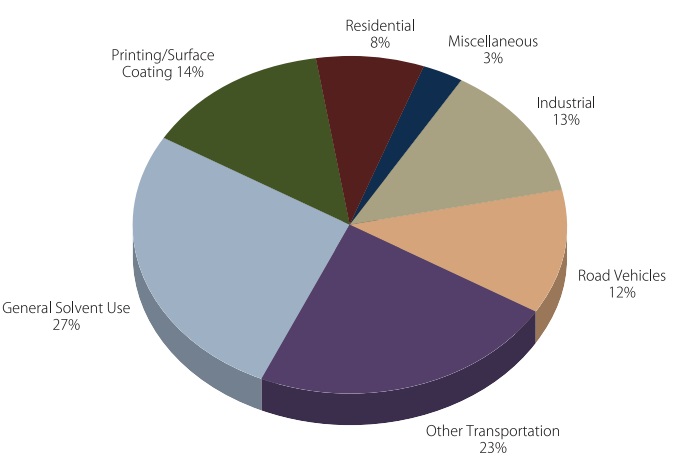
Note: Excludes emissions from open and natural sources.
Figure 2: Ontario Nitrogen Oxides Emissions by Sector (2011 Estimates for Point/Area/Transportation Sources)
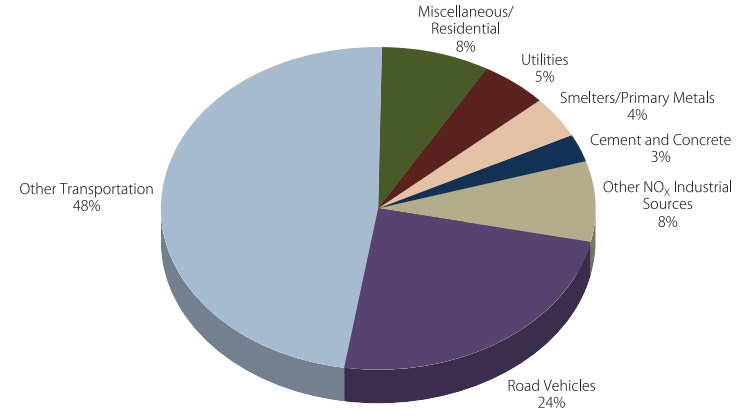
Note: Excludes emissions from open and natural sources.
In 2012, ozone was monitored at the ministry’s 40 AQI sites. The highest annual mean was
33.2 parts per billion (ppb), measured at Grand Bend, a transboundary-influenced site on
the eastern shore of Lake Huron. The lowest annual mean, 22.3 ppb, was measured at Toronto West, an urban site located near a major transportation corridor, Highway 401, and directly impacted by local nitric oxide (NO) emissions from vehicles. Generally, ozone concentrations are lower in urban areas because ozone is depleted by reacting with NO emitted by vehicles and other local combustion sources.
Ground-level ozone concentrations continued to exceed the provincial one-hour Ambient Air Quality Criterion (AAQC) of 80 ppb at 34 sites in 2012. The maximum one-hour ozone concentrations ranged from 74 ppb recorded in Thunder Bay, to 128 ppb recorded in Windsor. Ontario’s one-hour AAQC for ozone was exceeded the most often at Grand Bend on 109 occasions. The geographical distribution of one-hour ozone exceedances across the province are shown in Figure 3.
Figure 3: Geographical Distrubution of One-Hour Ozone Exceedances Across Ontario in 2012
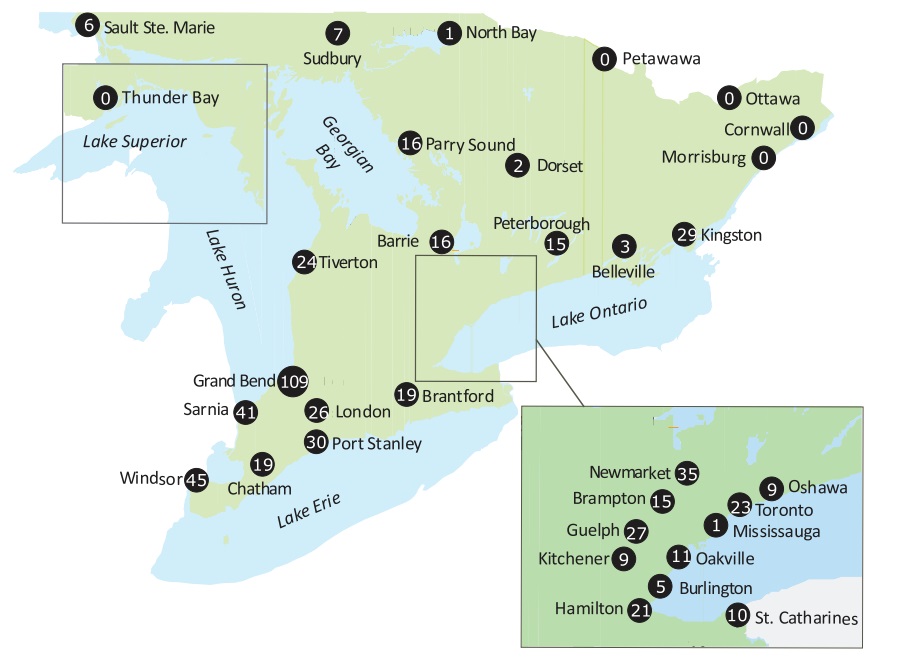
Generally, ozone exceedances are greater in southwestern Ontario, on the eastern shore of Lake Huron and on the northern shore of Lake Erie, more so than over central and eastern Ontario. As stated in the Transboundary Air Pollution in Ontario report, elevated ozone levels in southwestern Ontario are generally attributed to the long-range transport of pollutants from the United States. Transboundary air pollution is combined with local emissions of smog-related pollutants, and can impact various areas of the province during a smog episode (Yap et al., 2005).
As referenced in the Guidance Document on Achievement Determination (GDAD), the Canada-wide Standard (CWS) for ozone is 65 ppb, eight-hour running average time, based on the 4th highest annual ambient measurement averaged over three consecutive years. Of the 40 ambient air quality monitoring stations, 21 meet the requirements outlined in the GDAD (Canadian Council of Ministers of the Environment, 2007). In 2012, only two of the 21 CWS designated sites, Ottawa and Thunder Bay, met the CWS of 65 ppb for ozone. Table A19 of the Appendix provides a complete summary of reported CWS metrics since 2005.
The ozone annual means in Figure 4 display an increasing trend of 8 per cent for the 10-year period from 2003 to 2012. The trend of ozone summer means and ozone winter means are shown in Figure 5. The ozone summer means trend remained constant from 2003 to 2012, whereas the ozone winter means have increased by 16 per cent over the same 10- year period. The increase in the ozone winter means are mainly attributed to the rising global background concentrations which in turn drives the increasing trend of ozone annual means.
Figure 4: Trend of Ozone Annual Means Across Ontario (2003-2012)
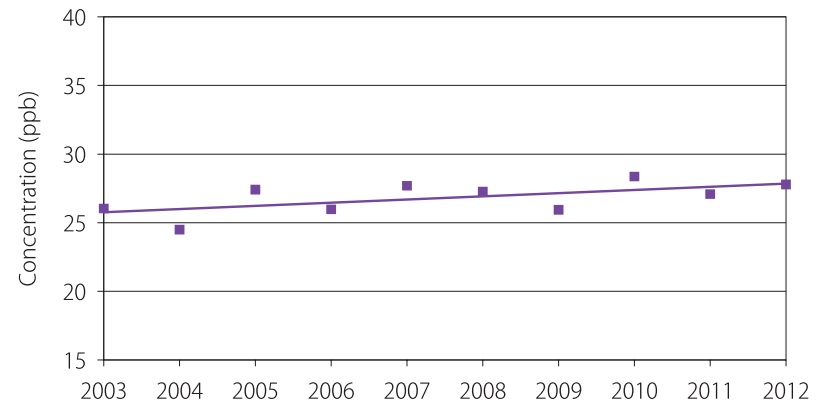
Note: Ten-year trend is a composite annual mean based on data from 37 monitoring sites.
Figure 5: Trend of Ozone Summer and Winter Means Across Ontario (2003-2012)
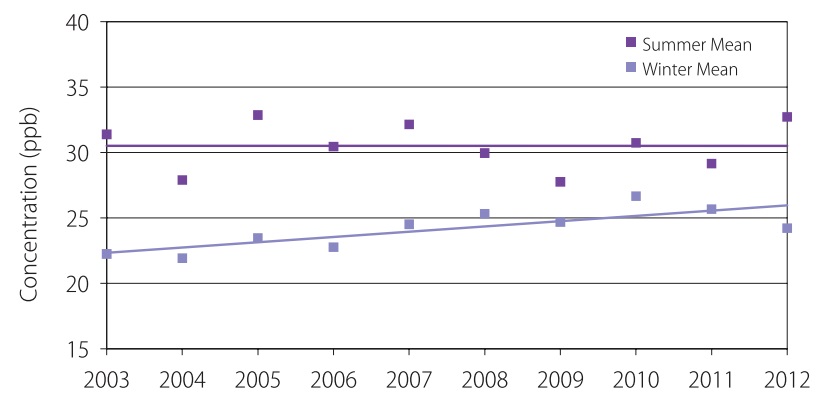
Note: Ten-year trends are a composite means for the summer and winter months based on data from 37 monitoring sites. Summer: May - September; Winter January - April, October - December.
3.0 Fine Particulate Matter (PM2.5)
Airborne particulate is the general term used to describe a mixture of microscopic solid particles and liquid droplets suspended in air. Particulate matter is classified according to its aerodynamic size, mainly due to the different health effects associated with particles of different diameters. Fine particulate matter, denoted as PM2.5, refers to respirable particles that are less than 2.5 microns in diameter, approximately 30 times smaller than the average diameter of a human hair. Due to their small size, they can penetrate deep into the lungs.
Particulate matter includes aerosols, smoke, fumes, dust, fly ash and pollen. Its composition is complex and varies with origin, residence time in the atmosphere, time of year and environmental conditions. Major components of PM2.5 in Ontario are typically nitrates, sulphates, organic matter and particle-bound water. Higher nitrate levels are common in the cooler months whereas sulphates are more elevated during warm temperatures. Fineparticulate matter may be emitted directly into the atmosphere as a by-product of fuel combustion or it may be formed indirectly in the atmosphere through a series of complex chemical reactions. Major sources of PM2.5 include motor vehicles, smelters, power plants, industrial facilities, residential fireplaces and wood stoves, agricultural burning and forest fires.
The 2011 estimates for Ontario’s PM2.5 emissions from point, area and transportation sources (excluding emissions from open and natural sources) indicate residential fuel combustion accounted for 40 per cent. The major contributor to residential emissions is fuel wood combustion in fireplaces and wood stoves. Industrial processes and transportation sectors accounted for 29 per cent and 24 per cent, respectively (NPRI, 2013).
The 2012 PM2.5 annual mean concentrations ranged from 3.6 µg/m3 in Petawawa to
10.2 µg/m3 in Sarnia. During periods of elevated concentrations of PM2.5 in Ontario, it is estimated that there are significant contributions from the U.S., specifically affecting border communities (Yap et al., 2005). The PM2.5 24-hour maximum concentrations ranged from 13 µg/m3 in Thunder Bay to 36 µg/m3 in Parry Sound. The PM2.5 24-hour maximum concentration in Parry Sound was recorded on July 22, 2012 due to forest fire smoke that originated in northern Manitoba and travelled over 600 kilometres. In 2012, four of the 40 sites exceeded Ontario’s 24-hour PM2.5 reference level of 30 µg/m3 on at least one occasion.
Similar to Ontario’s 24-hour PM2.5 reference level, the CWS for PM2.5 is also 30 µg/m3, 24-hour averaging time; however, as referenced in the GDAD, the CWS is based on the 98th percentile annual ambient measurement averaged over three consecutive years (Canadian Council of Ministers of the Environment, 2007), thus making the CWS for PM2.5 markedly different from Ontario’s PM2.5 reference level. The 2012 PM2.5 CWS metric concentrations ranged from 13 µg/m3 reported for both Sudbury and Thunder Bay to 25 µg/m3 reported for Hamilton Downtown. The CWS for PM2.5 was not exceeded in 2012 at any of the 21 CWS designated sites. Table A20 of the Appendix provides a complete summary of reported CWS metrics since 2005.
The PM2.5 annual means in Figure 6 display a decreasing trend of 31 per cent for the 10-year period of 2003 to 2012. Similarly, provincial PM2.5 emissions have decreased approximately 25 per cent from 2002 to 2011 as shown in Figure 7. Fine particulate emissions from industrial processes have been reduced approximately 40 per cent during this period. Emissions from the transportation sector decreased 24 per cent with the phase-in of new vehicles/engines having more stringent emission standards over the same period.
Figure 6: Trend of PM2.5 Annual Means Across Ontario (2003-2012)
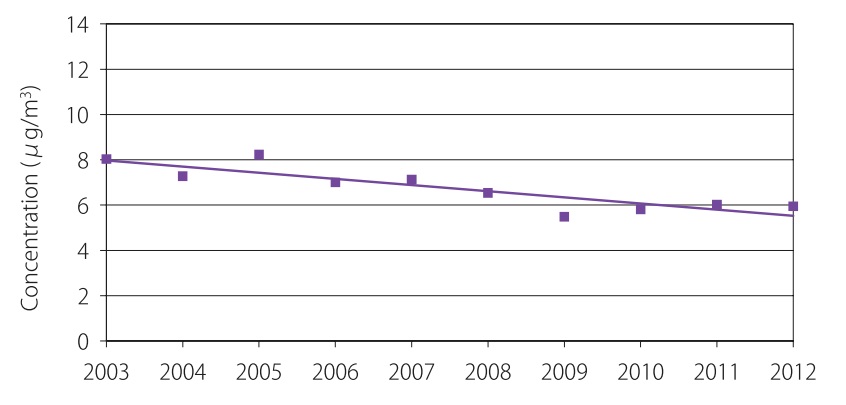
Note: The trend is a composite mean based on data from 37 monitoring sites. PM2.5 concentrations as measured by TEOM operated at 30°C with SES.
Figure 6: Ontario PM2.5 Emissions Trend (2002-2011)
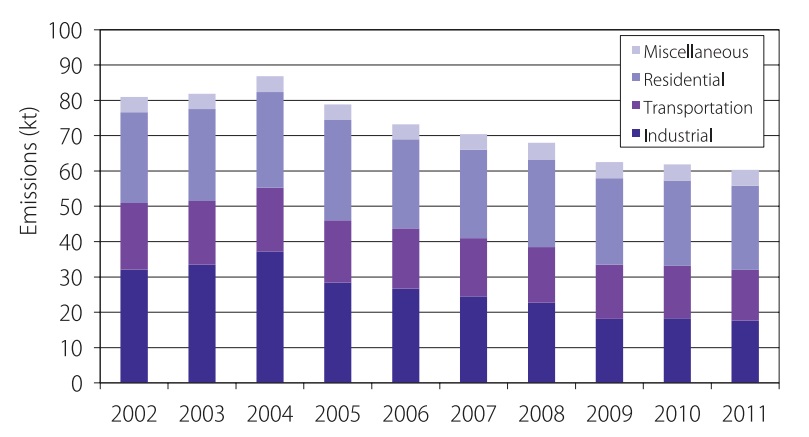
Note: Excludes emissions from open and natural sources.
4.0 Other Air Pollutants
Nitrogen Dioxide (NO2)
Nitrogen dioxide is a reddish-brown gas with a pungent odour, which transforms in the atmosphere to form gaseous nitric acid and nitrates. It plays a major role in atmospheric reactions that produce ground-level ozone, a major component of smog. Nitrogen dioxide also reacts in the air and contributes to the formation of PM2.5 (Seinfeld & Pandis, 2006). All combustion in air produces NOX, of which NO2 is a component. Major sources of NOX emissions include the transportation sector, industrial processes and utilities.
Nitrogen dioxide can irritate the lungs and lower their resistance to respiratory infection. People with asthma and bronchitis have increased sensitivity to NO2. Nitrogen dioxide chemically transforms into nitric acid in the atmosphere and, when deposited, contributes to the acidification of lakes and soils in Ontario. Nitric acid can also corrode metals, fade fabrics, degrade rubber, and damage trees and crops.
The Toronto West air monitoring station, located in an area of Toronto influenced by significant vehicular traffic, recorded the highest NO2 annual mean (16.3 ppb) during 2012; whereas Tiverton, a rural site, recorded the lowest NO2 annual mean (2.5 ppb). The highest NO2 means were recorded in large urbanized areas, such as the Greater Toronto Area of southern Ontario. The Toronto West station also recorded the highest one-hour NO2 concentration (70 ppb), and Windsor Downtown recorded the highest 24-hour NO2 concentration (40 ppb). There were no exceedances of the provincial one-hour and 24-hour AAQC for NO2, 100 ppb and 200 ppb, respectively, at any of the monitoring locations in Ontario during 2012.
The NO2 annual mean concentrations across Ontario have decreased 43 per cent from 2003 to 2012, as displayed in Figure 8. The NOX emission trend from 2002 to 2011 indicates a decrease of approximately 39 per cent as shown in Figure 9 (NPRI, 2013). Ontario’s emissions trading regulations on sulphur dioxide and nitrogen oxides (O. Reg. 397/01 and O. Reg. 194/05) have contributed to the reduction in nitrogen oxides emissions in recent years. The NOX emissions from on-road vehicles also decreased due to the phase-in of new vehicles having more stringent emission standards. The implementation of the Ontario Drive Clean program in southern Ontario in 1999 also helped further reduce the NOX emissions from light duty gasoline vehicles.
Figure 8: Trend of NO2 Annual Means Across Ontario (2003-2012)
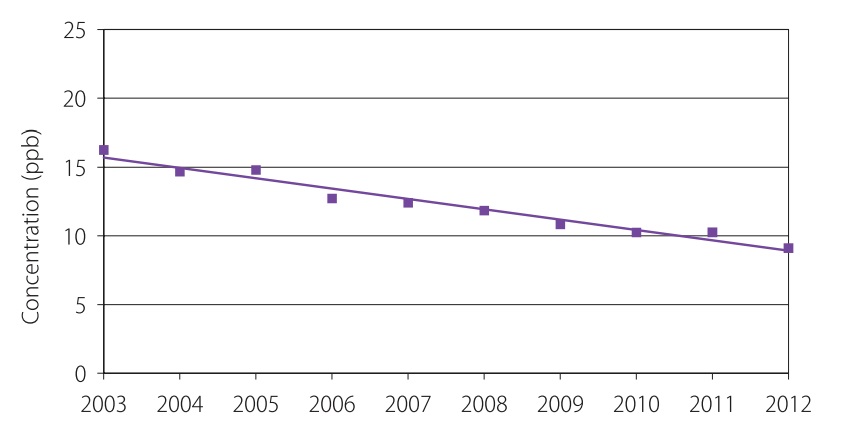
Note: The trend is a composite mean based on data from 22 monitoring sites.
Figure 9: Ontario NOX Emissions Trend (2002-2011)
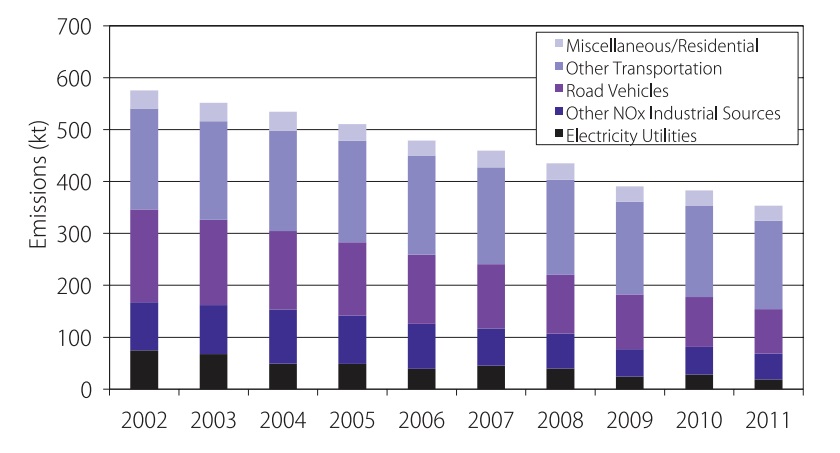
Excludes emissions from open and natural sources.
Sulphur Dioxide (SO2)
Sulphur dioxide is a colourless gas that smells like burnt matches. It can also be oxidized in the atmosphere to form sulphuric acid aerosols. In addition, sulphur dioxide is a precursor to sulphates, one of the main components of airborne secondary PM2.5. Electric utilities and smelters are the major sources of SO2 emissions in Ontario, accounting for approximately 64 per cent of the provincial SO2 emissions according to 2011 estimates for point, area and transportation sources (excluding emissions from open and natural sources). Other industrial processes (e.g. petroleum refining, cement and concrete manufacturing) accounted for an additional 27 per cent. The transportation sector and miscellaneous sources accounted for the remaining 9 per cent of all SO2 emissions in the province according to 2011 estimates (NPRI, 2013).
Health effects caused by exposure to high levels of SO2 include breathing problems, respiratory illness, and the exacerbation of respiratory and cardiovascular disease. People with asthma, chronic lung disease or heart disease are the most sensitive to SO2. Sulphur dioxide damages trees and crops. Similar to NO2, SO2 leads to the formation of PM2.5 and is also a precursor to acid rain, which contributes to the acidification of soils, lakes and streams, accelerated corrosion of buildings, and reduced visibility.
Hamilton Downtown recorded the highest SO2 annual mean (4.8 ppb) and 24-hour maximum concentration (29 ppb) during 2012, whereas Sudbury recorded the highest one-hour maximum concentration (142 ppb). There were no exceedances of the provincial one-hour, 24-hour and annual AAQC for SO2, 250 ppb, 100 ppb and 20 ppb, respectively, at any of the monitoring locations in Ontario during 2012.
The SO2 annual mean concentrations from 2003 to 2012 show a decreasing trend of 52 per cent across Ontario in Figure 10. Overall, provincial SO2 emissions have reduced by approximately 55 per cent from 2002 to 2011 as shown in Figure 11 (NPRI, 2013). The reduction of SO2 over the years is the result of various initiatives, which include, but are not limited to,
- Control orders for Ontario smelters
- Countdown Acid Rain program and Canada-wide Acid Rain Strategy
- Ontario emissions trading regulations on sulphur dioxide and nitrogen oxides (O. Reg. 397/01 and O. Reg. 194/05)
- Phase-out of coal-fired generating stations, with Lakeview Thermal Generating Station shut down in 2005
- Low sulphur content in transportation fuels.
Figure 10: Trend of SO2 Annual Means Across Ontario (2003-2012)
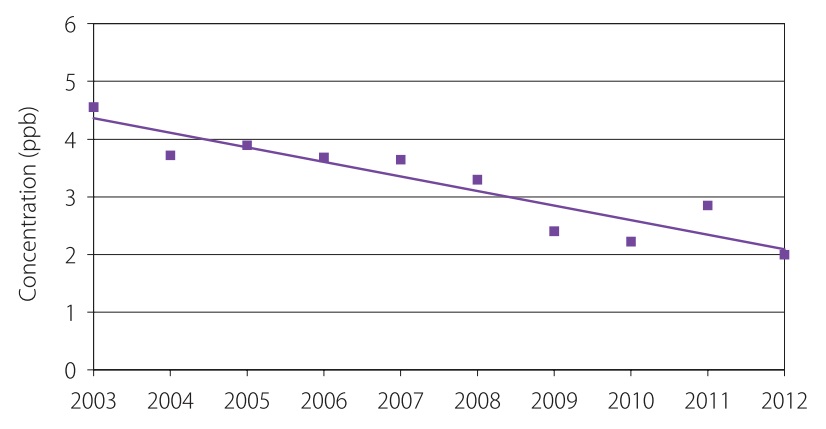
Note: Ten-year trend is a composite mean based on 9 sites.
Figure 11: Ontario SO2 Emissions Trend (2002-2011)
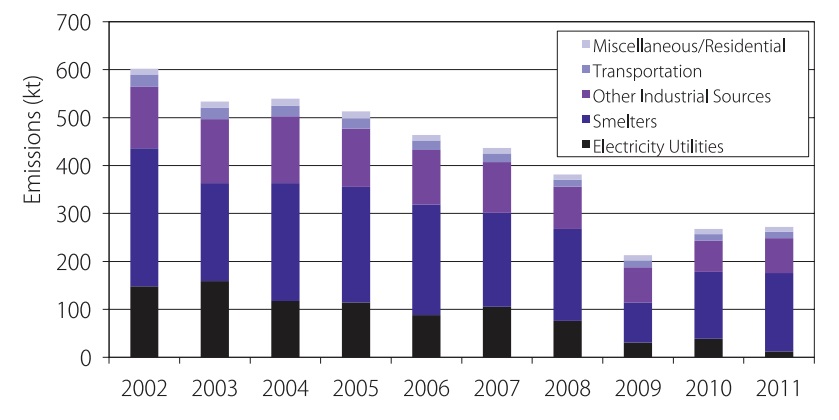
Note: Excludes emissions from open and natural sources.
Carbon Monoxide (CO)
Carbon monoxide is a colourless, odourless, tasteless and, at high concentrations, poisonous gas. This gas can enter the bloodstream and reduce oxygen delivery to the organs and tissues. People with heart disease are particularly sensitive to CO. Exposure to high CO levels is associated with the impairment of vision, work capacity, learning ability and performance of complex tasks. Carbon monoxide is produced primarily by the incomplete combustion of fossil fuels. The 2011 estimates for point, area and transportation sources (excluding emissions from open and natural sources) indicate that the transportation sector accounted for 87 per cent of all CO emissions (NPRI, 2013).
In 2012, the highest one-hour CO maximum, 2.09 parts per million (ppm) and the highest eight-hour maximum (1.21 ppm) were recorded at the Windsor Downtown site. Typically, higher CO concentrations are recorded in urban centres attributable to vehicle emissions.
There were no exceedances of the provincial one-hour and eight-hour AAQC, 30 ppm and 13 ppm, respectively, at any of the monitoring locations in Ontario during 2012.
The annual means of the one-hour and eight-hour CO maximums have decreased 43 per cent and 50 per cent, respectively, across the province from 2003 to 2012. Carbon monoxide emissions have been reduced by approximately 22 per cent from 2002 to 2011 (NPRI, 2013).
5.0 Air Quality Index and Smog Advisories
Ontario Air Quality Index (AQI)
The Air Quality Office of the Environmental Monitoring and Reporting Branch continuously obtains near real-time data for criteria pollutants from 40 AQI sites as displayed in Map A1 of the Appendix. The AQI, based on pollutants that have adverse effects on human health and the environment, includes O3, PM2.5, NO2, SO2, CO and TRS compounds. At the end of each hour, the concentration of each pollutant measured at each site is converted into a number ranging from zero upwards using a common scale or index. The calculated number for each pollutant is a sub-index. At a given air monitoring site, the highest sub-index for any given hour becomes the reporting AQI for that hour. The index is a relative scale, in that the lower the index, the better the air quality. The ministry web site provides index values, corresponding categories, and potential health and environmental effects.
The AQI network provides the public with hourly air quality information (24 hours per day) from across the province. The public can access AQI readings via the ministry’s web site or via the Interactive Voice Response (IVR) system. (To access an English recording, call 1.800.387.7768, or in Toronto, call 416-246-0411. For a French recording, call 1.800.221.8852). The ministry web site and IVR system also provides daily air quality forecasts, based on regional meteorological conditions and current pollution levels in Ontario and bordering U.S. states.
Based on the AQI categories, in 2012, Ontario reported very good to good air quality 92 per cent of the time, and moderate to poor air quality 8 per cent of the time. Table A21 of the Appendix provides the percentage distribution of hourly AQI readings for each of the 40 monitoring sites by AQI category and the number of poor air quality days.
Smog Advisories
Smog advisories are issued to the public in advance when AQI values are expected to be in the poor category due to elevated, widespread and persistent levels of O3 and/ or PM2.5. Generally, smog advisories are issued 24 hours in advance; however, if elevated smog conditions occur suddenly, and weather conditions conducive to elevated smog levels are expected to continue for several hours, a smog advisory is issued effective immediately. Note that a smog advisory is a forecast and does not necessarily mean elevated smog is a certainty since it is based on weather forecasts.
Smog advisories are issued via the ministry’s web site and the ministry’s IVR system (refer to Ontario’s Air Quality Index section above for details), and through email notification as per the Smog Alert network. (To receive a direct email notification of a smog advisory, visit the ministry web site and subscribe to the Smog Alert network).
The ministry issued 12 smog advisories in 2012, which covered 30 days. Table A22 of the Appendix summarizes the number of smog advisories issued for Ontario from 2003.
Glossary
- Air Quality Index
- real-time information system that provides the public with an indication of air quality in cities, towns and in rural areas across Ontario.
- AQI station
- continuous monitoring station used to inform the public of general ambient air quality levels over an entire region (not a localized area) on a real-time basis; station reports on criteria pollutant levels that are not unduly influenced by a single emission source, but rather are the result of emissions from multiple sources, including those in neighbouring provinces and states.
- Ambient air
- outdoor or open air.
- Carbon monoxide
- a colourless, odourless, tasteless, and at high concentrations, poisonous gas.
- Continuous pollutants
- pollutants for which a continuous record exists; effectively, pollutants that have hourly data (maximum 8,760 values per year except leap year – e.g. 2004 where maximum values for the year are 8,784).
- Continuous station
- where pollutants are measured on a real-time basis and data determined hourly (for example ozone, sulphur dioxide).
- Criterion
- maximum concentration or level (based on potential effects) of pollutant that is desirable or considered acceptable in ambient air.
- Exceedance
- violation of the air pollutant concentration levels established by environmental protection criteria or other environmental standards.
- Fine Particulate Matter
- particles smaller than 2.5 microns in aerodynamic diameter, which arise mainly from fuel combustion, condensation of hot vapours and chemically-driven gas-to-particle conversion processes; also referred to as PM2.5 or respirable particles. These are fine enough to penetrate deep into the lungs.
- Fossil fuels
- natural gas, petroleum, coal and any form of solid, liquid or gaseous fuel derived from organic materials for the purpose of generating heat.
- Ground-level ozone
- colourless gas formed from chemical reactions between nitrogen oxides and volatile organic compounds (VOCs) in the presence of sunlight near the Earth’s surface.
- Micron
- a millionth of a metre.
- Nitrogen dioxide
- a reddish-brown gas with a pungent and irritating odour.
- Oxidation
- a chemical reaction where a substance gains an oxygen; for example, in the atmosphere, sulphur dioxide is oxidized by hydroxyl radicals to form sulphate.
- Particulate matter
- refers to all airborne finely divided solid or liquid material with an aerodynamic diameter smaller than 44 microns.
- Percentile value
- percentage of the data set that lies below the stated value; if the 70 percentile value is 0.10 ppm, then 70 per cent of the data are equal to or below 0.10 ppm.
- Primary pollutant
- pollutant emitted directly to the atmosphere.
- Secondary pollutant
- pollutant formed from other pollutants in the atmosphere.
- Smog
- a contraction of smoke and fog; colloquial term used for photochemical smog, which includes ozone, and may include fine particulate matter, and other contaminants; tends to be a brownish haze.
- Smog advisory
- smog advisories are issued to the public when there is a strong likelihood that widespread, elevated and persistent smog levels are expected.
- Stratosphere
- atmosphere 10 to 40 kilometres above the Earth’s surface.
- Stratospheric ozone
- ozone formed in the stratosphere from the conversion of oxygen molecules by solar radiation; ozone found there absorbs much ultraviolet radiation and prevents it from reaching the Earth.
- Sulphur dioxide
- a colourless gas that smells like burnt matches.
- Troposphere
- atmospheric layer extending from the surface up to about 10 kilometres above the Earth’s surface.
Acronyms
- AAQC
- Ambient Air Quality Criteria (Ontario)
- AQI
- Air Quality Index
- CO
- carbon monoxide
- CWS
- Canada-wide Standard
- GDAD
- Guidance Document on Achievement Determination
- IVR
- Interactive Voice Response
- NO
- nitric oxide
- NO2
- nitrogen dioxide
- NOX
- nitrogen oxides
- O3
- ozone
- PM2.5
- fine particulate matter
- SES (TEOM)
- Sample Equilibration System
- SO2
- sulphur dioxide
- TEOM
- Tapered Element Oscillating Microbalance
- TRS
- total reduced sulphur
- VOCs
- volatile organic compounds
- kt
- kilotonnes
- µg/m3
- micrograms (of contaminant) per cubic metre (of air) – by weight
- ppb
- parts (of contaminant) per billion (parts of air) – by volume
- ppm
- parts (of contaminant) per million (parts of air) – by volume
References
- Canadian Council of Ministers of the Environment, 2007. Guidance Document on Achievement Determination: Canada-Wide Standards for Particulate Matter and Ozone (Revised).
- NPRI, 2013. National Pollutant Release Inventory (NPRI) Downloadable Datasets. Environment Canada. (accessed February 2013).
- Ontario Ministry of the Environment. 2013. Air Quality in Ontario – Report for 2011.
- Seinfeld, J.H. and S.N. Pandis. 2006. Atmospheric chemistry and physics: From air pollution to climate change. (2nd ed.) New Jersey: John Wiley & Sons Inc.
- Yap, D., Reid, N., De Brou, G. and R. Bloxam. 2005. Transboundary Air Pollution in Ontario. Ontario Ministry of the Environment.
Resources
- Brook, J.R., Dann, T. and R.T. Burnett. 1997. The Relationship among TSP, PM10, PM2.5 and Inorganic Constituents of Atmospheric Particulate Matter at Multiple Canadian Locations. Journal of Air and Waste Management Association, Vol 46, pp. 2-18.
- Burnett, R.T., Dales, R.E., Krewski, D., Vincent, R., Dann, T., and J.R. Brook. 1995. Associations between Ambient Particulate Sulphate and Admissions to Ontario Hospitals for Cardiac and Respiratory Diseases. American Journal of Epidemiology, Vol 142, pp. 15-22.
- Fraser, D., Yap, D., Kiely, P. and D. Mignacca. 1991. Analysis of Persistent Ozone Episodes in Southern Ontario 1980-1991. Technology Transfer Conference, Toronto, 1991. Proceedings AP14, pp. 222-227.
- Geddes, J.A., Murphy, J.G., D.K.Wang. 2009. Long term changes in nitrogen oxides and volatile organic compounds in Toronto and the challenges facing local ozone control. Atmospheric Environment, Vol. 43, pp. 3407-3415.
- Itano, Y., Bandow, H., Takenaka, N., Saitoh, Y., Asayama, A., J. Fukuyama. 2007. Impact of NOX reduction on long-term ozone trends in an urban atmosphere. Science of the Total Environment, Vol. 379, pp. 46-55.
- Lin, C.C.-Y., Jacob, D.J., Munger, J.W., and A.M. Fiore. 2000. Increasing Background Ozone in Surface Air Over the United States. Geophysical Research Letters, Vol. 27 (21), pp. 3465-3468.
- Lioy, P. et al., 1991. Assessing Human Exposure to Airborne Pollutants. Environmental Science and Technology, Vol. 25, pp. 1360.
- Lipfert, F.W. and T. Hammerstrom. 1992. Temporal Patterns in Air Pollution and Hospital Admissions. Environmental Research, Vol. 59, pp. 374-399.
- Lippmann, M. 1991. Health Effects of Tropospheric Ozone. Environmental Science and Technology, Vol. 25, No. 12, pp. 1954-1962.
- Logan, J. A., Staehelin, J., Megretskaia, I. A., Cammas, J.-P., Thouret, V., Claude, H., Backer, H. D., Steinbacher, M., Scheel, H.-E., Stubi, R., Frohlich, M., and R. G. Derwent. 2012. Changes in ozone over Europe: Analysis of ozone measurements from sondes, regular aircraft (MOZAIC) and alpine surface sites. Journal of Geophysical Research, 117, D09301, doi:10.1029/2011JD016952.
- Ontario Ministry of the Environment, 2011. Publications. Ontario Ministry of the Environment.
- Pengelly, L.D., Silverman, F. and C.H. Goldsmith. 1992. Health Effects of Air Pollution Assessed Using Ontario Health Survey Data. Urban Air Group, McMaster University.
- Reid, N., Yap, D., R. Bloxam. 2008. The potential role of background ozone on current and emerging air issues: An overview. Air Quality, Atmosphere & Health, Vol. 1, pp. 19-29.
- Rethinking the Ozone Problem in Urban and Regional Air Pollution. National Academy Press, Washington, D.C., 1991.
- United States Environmental Protection Agency. 2003. Latest Findings on National Air Quality, 2002 Status and Trends.
- United States Environmental Protection Agency. 2003. National Air Quality and Emission Trends, 2003 Special Studies Edition.
- United States Environmental Protection Agency. 2004. Particle Pollution Report, Current Understanding of Air Quality and Emissions through 2003.
- Vingarzan, R. 2004. A review of surface ozone background levels and trends. Atmospheric Environment, Vol. 38, pp. 3431-42.
- Wolff, G.T., Kelley, N.A. and M.A. Ferman. 1982. Source Regions of Summertime Ozone and Haze Episodes in the Eastern U.S. Water, Air and Soil Pollution, 18: pp. 65-81.
- Yap, D., Ning, D.T. and W. Dong. 1988. An Assessment of Source Contribution to the Ozone Concentrations in Southern Ontario. Atmospheric Environment, Vol. 22, No. 6, pp. 1161-1168.
Appendix
The Appendix is intended for use in conjunction with the 2012 Annual Air Quality in Ontario report. The Appendix briefly describes the provincial Air Quality Index (AQI) network, quality assurance and quality control procedures, and the Ministry of the Environment and Climate Change’s air quality database. It also includes a series of tables displaying station locations and a listing of the summary statistics including means, maximums, percentile values and the number of exceedances of the Ontario Ambient Air Quality Criteria (AAQC) for each pollutant. In addition, trends for select pollutants are displayed for 10- and 20-year periods.
Monitoring Network Operations
Network Description
In 2012, the Environmental Monitoring and Reporting Branch (EMRB) operated 40 ambient air monitoring sites across Ontario. Monitoring site locations for the AQI network are illustrated in Map A1. The AQI network was comprised of 133 continuous monitoring instruments at 40 sites. These instruments have the capability of recording minute data (approximately 70 million data points per year) that are used to scan and validate the continuous hourly data.
Quality Assurance and Quality Control
Day-to-day maintenance and support of the instruments are administered by EMRB staff. Instrumentation precision is verified by daily automatic internal zero and span checks. Data analysts and station operators review span control charts to confirm instrument precision using a telemetry system. A quarterly quality assurance and quality control (QA/QC) review is performed on the ambient data set in order to highlight anomalies and administer corrective action in a timely manner.
The air monitoring station operators routinely inspect and maintain monitoring equipment and stations with mandatory bi-monthly on- site visits where secondary transfer standards are used to calibrate instrumentation. Station activity is recorded using FieldWorker Inc. software, an electronic documentation solution; this information is transferred directly to the ministry’s database. The instrumentation used throughout the provincial air monitoring network has been standardized to Thermo Electron Corporation analyzers in an effort to streamline parts inventory and leverage common hardware used within each analyzer. The following is a summary of the instrumentation deployed within the network:
- Ozone – TE49C/I
- Fine Particulate Matter – TEOM 1400ab/SES
- Nitrogen Oxides – TE42C/I
- Carbon Monoxide – TE48C/I
- Total Reduced Sulphur – TE43C/CDN101
- Sulphur Dioxide – TE43C/I
EMRB operates a laboratory with gas reference standards that adhere to those of the U.S. National Institute of Standards and Technology (NIST) and the Air Quality Research Division of Environment Canada. The secondary transfer standards used by station operators are referenced and certified to EMRB’s NIST primary standards on a quarterly basis. Primary weighed filter standards from Environment Canada are used to calibrate the TEOM twice a year.
The Ontario ambient air quality monitoring network undergoes constant maintenance to ensure a high standard of quality control.
Continuous real-time data are consistently reviewed, assessed and validated by EMRB staff. Immediate actions are taken to correct any inconsistencies that may affect the validity of the data. These measures ensure ambient air monitoring data are valid, complete, comparable, representative and accurate. As a result, the 2012 ambient air quality monitoring network had greater than 98 per cent valid data from over one million hourly data points.
Continous PM2.5 Monitoring Network Upgrade
The ministry historically relied on the non- continuous Federal Reference Method (FRM) for PM2.5 monitoring, which produces 24-hour averaged measurements on a 3-day or 6-day cycle. The FRM is resource-intensive and requires sample setup and laboratory analysis and can take up to several months to report PM2.5 data. Continuous particulate matter (PM) monitoring is essential for reporting hourly ambient concentrations; however, it comes with technical challenges. The Tapered Element Oscillating Microbalance (TEOM) technology was developed for continuous real-time PM monitoring (Patashnick and Rupprecht, 1991) and received United States Environmental Protection Agency (USEPA) Class III Federal Equivalent Method (FEM) designation in 1990 for PM10 reporting (USEPA, 2011). The Class III FEM is a designation for measuring ambient concentrations of specified air pollutants in accordance with Title 40, Part 53 of the Code of Federal Regulations (40 CFR Part 53).
Ontario was the first province in Canada to report continuous real-time PM2.5 concentrations to the public in 2002 under the AQI program when continuous measurements of PM2.5 became a priority for provincial and federal governments. TEOM was the most innovative method at the time for continuous real-time PM2.5 monitoring, and continues to be used by many jurisdictions across North America. Over the last decade, continuous PM2.5 monitoring technologies have evolved dramatically to address the technical issues associated with cold weather PM2.5 measurements. To ensure consistency and comparability in PM2.5 monitoring and reporting, in 2006, the USEPA published criteria for designating a continuous PM2.5 monitor as Class III FEM (Federal Register, 2006). Manufacturers are required to collocate their PM2.5 monitors with FRM measurements and pass rigorous tests following the USEPA guidelines to receive the Class III FEM PM2.5 designation (Federal Register, 2006). Six continuous PM2.5 monitors received the Class III FEM designation as of October 12, 2011.
After extensive evaluation of four designated Class III FEM PM2.5 monitors, Ontario selected the Thermo Scientific Synchronized Hybrid Ambient Real-time Particulate (SHARP) 5030 to replace the TEOM monitors currently deployed in the AQI network. In 2012, as part of a national initiative funded by Environment Canada, Ontario deployed the SHARP 5030 monitor across Ontario’s ambient air monitoring network. This deployment enables the ministry to learn about the new PM2.5 monitoring method in preparation for the reporting of PM2.5 concentrations as measured by the SHARP 5030 to commence in January 2013. It is anticipated that the SHARP 5030 will report higher PM2.5 concentrations than those reported by TEOM during cold weather due to the improved performance of the SHARP 5030 when compared to measurements with the FRM (Sofowote et al., 2013). Ontario’s upgrade of its PM2.5 monitoring network to the USEPA Class III FEM will standardize monitoring methods and ensure consistency of data quality across Canada.
Data Base
The ambient air quality data used in this report are stored in the ministry’s air quality information system (AQUIS). A statistical pattern test is used to identify data anomalies, such as unusual pollutant concentrations. Each pollutant has a predetermined concentration range based on historical data. Values outside this range are flagged for further investigation.
Data obtained from automated ambient air monitoring instruments that operate continuously to produce an average measurement for every hour for a possible total of 8,760 measurements in a given year. Hourly parameters measured include O3, PM2.5, NO/NO2/NOX, CO, SO2 and TRS compounds. A valid annual mean requires at least 6,570 hourly readings. In addition, the 2nd and 3rd quarters of the year should have 75 per cent valid data for ozone, whereas for PM2.5, each quarter of the year should have 75 per cent valid data (Canadian Council of Ministers of the Environment, 2002).
Network Descriptive Table, Annual Statistics and Trends
The AQI network for 2012 is summarized in Table A1. The table displays the station name, numerical identifier and pollutants measured. The numerical identifier is the station (ID) number, the first digit of which identifies the geographic region in which the station is located.
Table A1 also identifies the type of air monitoring site: ambient, road-side, Canada-wide Standard (CWS), and/or National Air Pollution Surveillance (NAPS). Ambient sites represent the general air quality of an area without any direct influence of local industrial sources. Road-side sites are within approximately 100 m of a major roadway with daily traffic volumes greater than 10,000 vehicles per day.
The 2012 statistical data and 10-year trends for various continuous pollutants are provided in Tables A2-A9, and Tables A10-A18, respectively. To be included in the 10-year trend analysis, a site must have valid annual means for a minimum of 8 years over the 10-year period from 2003-2012. The 20-year trends for ozone, NO2 and SO2 are provided in Figures A1-A26, Figures A27-A40, and Figures A41-A48, respectively. To be included in the 20-year trend analysis, a site must have valid annual means for a minimum of 15 years over the 20-year period from 1993-2012. A linear regression was applied to each of the 20-year trends presented to calculate the per cent change in concentrations over time.
References For Appendix
- Canadian Council of Ministers of the Environment, 2002. Guidance Document on Achievement Determination: Canada-Wide Standards for Particulate Matter and Ozone.
- Federal Register. 2006. 40 CFR Parts 53 and 58: Revisions to Ambient Air Monitoring Regulations; Final Rule.71 (200), 61236-61328. October 17, 2006.
- Patashnick, H. and E.G. Rupprecht. 1991. Continuous PM-10 Measurements Using the tapered Element Oscillating Microbalance. Journal of the Air & Waste Management Association, Vol. 41, pp. 1079-1083.
- Sofowote, U., Su, Y., Bitzos, M.M., and Munoz, A. 2013. Improving the Correlations of Ambient TEOM PM2.5 Data and SHARP 5030 FEM in Ontario: a Multiple Linear Regression Analysis. Journal of the Air & Waste Management Association, in press.
- United States Environmental Protection Agency (USEPA). 2011. List of Designated Reference and Equivalent Methods. Issue Date: October 12, 2011.
Map A1: Air Quality Index (AQI) Monitoring Sites across Ontario in 2012
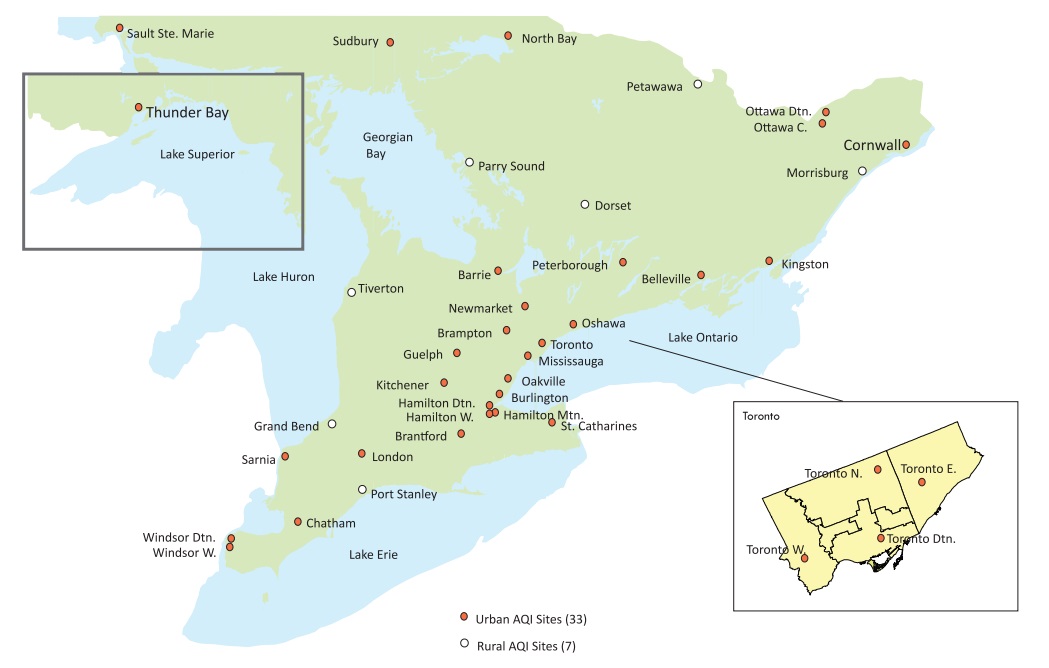
| ID | Station Name | Station Location | Year | Latitude (D:M:S) | Longitude (D:M:S) | Air Intake (AGL) | Type | AQI | O3 | PM2.5 | NO2 | SO2 | CO | TRS |
|---|---|---|---|---|---|---|---|---|---|---|---|---|---|---|
| 12008 | Windsor Downtown | 467 University Ave. West | 1969 | 42°18'56.8" | -83°02'37.2" | 8 | A/RS/C/N | Y | T | T | T | T | T | . |
| 12016 | Windsor West | College Ave./South Street | 1975 | 42°17'34.4" | -83°04'23.3" | 4 | A/N | Y | T | T | T | T | . | T |
| 13001 | Chatham | 435 Grand Ave. West | 2005 | 42°24'13.3" | -82°12'29.9" | 15 | A/C/N | Y | T | T | T | . | . | . |
| 14064 | Sarnia | Front Street North/CN Tracks, Centennial Park | 1978 | 42°58'56.2" | -82°24'18.3" | 3 | A/N | Y | T | T | T | T | . | T |
| 15020 | Grand Bend | Point Blake Conservation Area | 1991 | 43°19'59.1" | -81°44'34.4" | 5 | A/N | Y | T | T | T | . | . | . |
| 15025 | London | 900 Highbury Ave. North | 1995 | 43°00'24.2" | -81°12'23.1" | 4 | A/C/N | Y | T | T | T | . | . | . |
| 16015 | Port Stanley | 43665 Dexter Line, Elgin Water T. Plant | 2002 | 42°40'19.5" | -81°09'46.4" | 5 | A/N | Y | T | T | . | . | . | . |
| 18007 | Tiverton | 4th Concession/Bruce Road 23 | 1979 | 44°18'52.1" | -81°32'59.0" | 4 | A/N | Y | T | T | T | . | . | . |
| 21005 | Brantford | 324 Grand River Ave. | 2004 | 43°08'19.0" | -80°17'33.5" | 5 | A/C/N | Y | T | T | T | . | . | . |
| 26060 | Kitchener | West Ave./Homewood Ave. | 1990 | 43°26'37.8" | -80°30'13.7" | 5 | A/C/N | Y | T | T | T | . | . | . |
| 27067 | Saint Catharines | Argyle Crescent, Pump Station | 1987 | 43°09'36.2" | -79°14'05.1" | 4 | A/C/N | Y | T | T | T | . | . | . |
| 28028 | Guelph | Exhibition Street/Clark Street West | 2000 | 43°33'05.8" | -80°15'51.0" | 4 | A/C/N | Y | T | T | T | . | . | . |
| 29000 | Hamilton Downtown | Elgin St./Kelly St. | 1987 | 43°15'28.0" | -79°51'42.0" | 4 | A/RS/C/N | Y | T | T | T | T | T | T |
| 29114 | Hamilton Mountain | Vickers Rd./East 18th St. | 1985 | 43°13'45.9" | -79°51'46.0" | 3 | A/C/N | Y | T | T | T | T | . | . |
| 29118 | Hamilton West | Main St. West/Hwy 403 | 1985 | 43°15'26.8" | -79°54'27.9" | 3 | A/RS | Y | T | T | T | . | . | . |
| 31103 | Toronto Downtown | Bay St./Wellesley St. West | 2000 | 43°39'46.7" | -79°23'17.2" | 10 | A/RS/C/N | Y | T | T | T | . | . | . |
| 33003 | Toronto East | Kennedy Rd./Lawrence Ave. East | 1970 | 43°44'52.5" | -79°16'26.6" | 4 | A/RS/C/N | Y | T | T | T | . | . | . |
| 34020 | Toronto North | Hendon Ave./Yonge St. | 1988 | 43°46'53.8" | -79°25'03.8" | 5 | A/RS/C/N | Y | T | T | T | . | . | . |
| 35125 | Toronto West | 125 Resources Rd. | 2003 | 43°42'34.0" | -79°32'36.6" | 8 | A/RS/C/N | Y | T | T | T | T | T | . |
| 44008 | Burlington | North Shore Blvd. E./Lakeshore Rd. | 1979 | 43°18'54.4" | -79°48'09.5" | 5 | A/C/N | Y | T | T | T | . | . | . |
| 44017 | Oakville | Eighth Line/Glenashton Dr., Halton Reservoir | 2003 | 43°29'12.9" | -79°42'08.2" | 12 | A/C/N | Y | T | T | T | . | . | . |
| 45026 | Oshawa | 2000 Simcoe St. North, Durham College | 2005 | 43°56'45.4" | -78°53'41.7" | 7 | A/RS/C/N | Y | T | T | T | . | . | . |
| 46089 | Brampton | 525 Main St. North, Peel Manor | 2000 | 43°41'55.5" | -79°46'51.3" | 5 | A/C/N | Y | T | T | T | . | . | . |
| 46108 | Mississauga | 3359 Mississauga Rd. North, U of T Mississauga | 2007 | 43°32'49.1" | -79°39'31.3" | 5 | A/C/N | Y | T | T | T | T | . | . |
| 47045 | Barrie | 83 Perry St. | 2001 | 44°22'56.5" | -79°42'08.3" | 5 | A/C/N | Y | T | T | T | . | . | . |
| 48006 | Newmarket | Eagle St. West/McCaffrey Rd. | 2001 | 44°02'39.5" | -79°28'59.7" | 5 | A/N | Y | T | T | T | . | . | . |
| 49005 | Parry Sound | 7 Bay St. | 2001 | 45°20'16.3" | -80°02'17.4" | 5 | A/N | Y | T | T | T | . | . | . |
| 49010 | Dorset | 1026 Bellwood Acres Rd. | 1981 | 45°13'27.4" | -78°55'58.6" | 3 | A/N | Y | T | T | . | . | . | . |
| 51001 | Ottawa Downtown | Rideau St./Wurtemburg St. | 1971 | 45°26'03.6" | -75°40'33.6" | 4 | A/C/N | Y | T | T | T | T | T | . |
| 51002 | Ottawa Central | 960 Carling Ave. | 2007 | 45°22'57.1" | -75°42'51.1" | 5 | A/N | Y | T | T | T | . | . | . |
| 51010 | Petawawa | Petawawa Research Forest Facility | 2007 | 45°59'48.2" | -77°26'28.3" | 6 | A/N | Y | T | T | . | . | . | . |
| 52022 | Kingston | 752 King St. West | 2006 | 44°12'58.5" | -76°31'41.9" | 13 | A/C/N | Y | T | T | T | . | . | . |
| 54012 | Belleville | 2 Sidney St., Water Treatment Plant | 2002 | 44°09'01.9" | -77°23'43.8" | 10 | A/N | Y | T | T | T | . | . | . |
| 56010 | Morrisburg | County Rd. 2, Morrisburg Water Tower | 2005 | 44°53'59.1" | -75°11'23.8" | 5 | A/N | Y | T | T | . | . | . | . |
| 56051 | Cornwall | Bedford St./3rd St. West | 1970 | 45°01'04.7" | -74°44'06.8" | 4 | A/N | Y | T | T | T | . | . | . |
| 59006 | Peterborough | 10 Hospital Dr. | 1998 | 44°18'06.9" | -78°20'46.4" | 10 | A/C/N | Y | T | T | T | . | . | . |
| 63203 | Thunder Bay | 421 James St. South | 2004 | 48°22'45.8" | -89°17'24.6" | 15 | A/RS/C/N | Y | T | T | T | . | . | . |
| 71078 | Sault Ste. Marie | Sault College | 2004 | 46°31'59.5" | -84°18'35.7" | 8 | A/N | Y | T | T | T | T | . | T |
| 75010 | North Bay | Chippewa St. West, Dept. National Defence | 1979 | 46°19'23.5" | -79°26'57.4" | 4 | A/RS/N | Y | T | T | T | . | . | . |
| 77219 | Sudbury | 1222 Ramsey Lake Rd. | 2004 | 46°28'32.5" | -80°57'46.6" | 3 | A/C/N | Y | T | T | . | T | . | . |
| Total | 40 | 40 | 40 | 35 | 10 | 4 | 4 | |||||||
Notes:
- ID
- station identfication number
- Year
- year station began monitoring
- Air intake
- height of air intake above ground (m)
- Type
- type of monitoring site: A = ambient, RS = road-side, C = CWS, N = NAPS
- AQI
- Air Quality Index site
- T
- telemetry
- O3:
- ground-level ozone
- PM2.5
- fine particulate matter
- NO2
- nitrogen dioxide
- CO
- carbon monoxide
- SO2
- sulphur dioxide
- TRS
- total reduced sulphur
| ID | City | Station Location | Valid h | Percentiles (10%) | Percentiles (30%) | Percentiles (50%) | Percentiles (70%) | Percentiles (90%) | Percentiles (99%) | Percentiles (Mean) | Maximum (1h) | Maximum (24h) | No. of Times Above Criterion (1h) |
|---|---|---|---|---|---|---|---|---|---|---|---|---|---|
| 12008 | Windsor Downtown | 467 University Ave. W. | 8741 | 7 | 18 | 26 | 35 | 51 | 76 | 28.0 | 128 | 69 | 45 |
| 12016 | Windsor West | College Ave./South St. | 8666 | 6 | 18 | 26 | 35 | 51 | 75 | 28.0 | 128 | 70 | 41 |
| 13001 | Chatham | 435 Grand Ave. W. | 8710 | 13 | 21 | 28 | 35 | 49 | 74 | 29.5 | 104 | 65 | 19 |
| 14064 | Sarnia | Front St. N./CN Tracks, Centennial Park | 8682 | 12 | 22 | 29 | 35 | 49 | 74 | 29.7 | 101 | 60 | 41 |
| 15020 | Grand Bend | Point Blake Conservation Area | 8761 | 16 | 26 | 32 | 38 | 51 | 82 | 33.2 | 124 | 74 | 109 |
| 15025 | London | 900 Highbury Ave. N. | 8771 | 10 | 19 | 26 | 33 | 47 | 72 | 27.7 | 88 | 62 | 26 |
| 16015 | Port Stanley | 43665 Dexter Line, Elgin Water T. Plant | 8767 | 17 | 25 | 31 | 38 | 52 | 75 | 33.1 | 104 | 68 | 30 |
| 18007 | Tiverton | 4th Concession/Bruce Rd. 23 | 8717 | 18 | 25 | 30 | 36 | 48 | 72 | 32.0 | 93 | 66 | 24 |
| 21005 | Brantford | 324 Grand River Ave. | 8773 | 8 | 20 | 28 | 35 | 50 | 72 | 28.8 | 88 | 57 | 19 |
| 26060 | Kitchener | West Ave./Homewood Ave. | 8759 | 10 | 20 | 27 | 34 | 47 | 68 | 28.0 | 89 | 58 | 9 |
| 27067 | St. Catharines | Argyle Cres., Pump Stn. | 8685 | 9 | 21 | 28 | 35 | 49 | 69 | 28.7 | 98 | 63 | 10 |
| 28028 | Guelph | Exhibition St./Clark St. W. | 8685 | 10 | 21 | 28 | 35 | 49 | 71 | 28.8 | 94 | 57 | 27 |
| 29000 | Hamilton Downtown | Elgin St./Kelly St. | 8724 | 7 | 18 | 25 | 32 | 45 | 65 | 25.7 | 88 | 55 | 7 |
| 29114 | Hamilton Mountain | Vickers Rd./E. 18th St. | 8734 | 12 | 22 | 29 | 36 | 51 | 72 | 30.2 | 91 | 70 | 21 |
| 29118 | Hamilton West | Main St. W./Hwy 403 | 8771 | 4 | 16 | 24 | 30 | 43 | 64 | 24.2 | 85 | 53 | 4 |
| 31103 | Toronto Downtown | Bay St./Wellesley St. W. | 8763 | 8 | 19 | 25 | 32 | 46 | 69 | 26.6 | 90 | 62 | 11 |
| 33003 | Toronto East | Kennedy Rd./Lawrence Ave. E. | 8680 | 5 | 17 | 23 | 30 | 44 | 69 | 24.6 | 89 | 65 | 12 |
| 34020 | Toronto North | Hendon Ave./Yonge St. | 8769 | 7 | 18 | 25 | 32 | 44 | 70 | 25.7 | 92 | 61 | 15 |
| 35125 | Toronto West | 125 Resources Rd. | 8708 | 2 | 12 | 20 | 27 | 42 | 69 | 21.5 | 94 | 58 | 23 |
| 44008 | Burlington | North Shore Blvd. E./Lakeshore Rd. | 8707 | 8 | 18 | 26 | 33 | 46 | 67 | 26.7 | 91 | 56 | 5 |
| 44017 | Oakville | Eighth Line/Glenashton Dr., Halton Reservoir | 8735 | 9 | 20 | 27 | 34 | 47 | 70 | 27.7 | 96 | 59 | 11 |
| 45026 | Oshawa | 2000 Simcoe St. N., Durham College | 8731 | 10 | 20 | 26 | 32 | 43 | 69 | 27.0 | 92 | 58 | 9 |
| 46089 | Brampton | 525 Main St. N., Peel Manor | 8701 | 6 | 18 | 26 | 33 | 46 | 70 | 26.6 | 92 | 56 | 15 |
| 46108 | Mississauga | 3359 Mississauga Rd. N., U of T Campus | 8747 | 5 | 18 | 25 | 32 | 45 | 67 | 25.6 | 81 | 57 | 1 |
| 47045 | Barrie | 83 Perry St. | 8728 | 8 | 19 | 26 | 33 | 43 | 66 | 26.3 | 91 | 57 | 16 |
| 48006 | Newmarket | Eagle St. W./Mccaffrey Rd. | 8720 | 12 | 22 | 29 | 35 | 48 | 71 | 29.4 | 105 | 64 | 35 |
| 49005 | Parry Sound | 7 Bay St. | 8777 | 14 | 24 | 30 | 35 | 46 | 70 | 30.1 | 94 | 66 | 16 |
| 49010 | Dorset | 1026 Bellwood Acres Rd. | 8776 | 10 | 21 | 28 | 34 | 44 | 65 | 28.0 | 82 | 52 | 2 |
| 51001 | Ottawa Downtown | Rideau St./Wurtemburg St. | 8622 | 9 | 19 | 26 | 32 | 42 | 59 | 26.0 | 76 | 64 | 0 |
| 51002 | Ottawa Central | 960 Carling Ave. | 8664 | 8 | 19 | 26 | 32 | 42 | 58 | 25.6 | 76 | 62 | 0 |
| 51010 | Petawawa | Petawawa Research Forest Facility | 8758 | 12 | 22 | 28 | 33 | 43 | 60 | 27.7 | 77 | 55 | 0 |
| 52022 | Kingston | 752 King St. W. | 8726 | 17 | 26 | 31 | 37 | 49 | 73 | 32.7 | 92 | 67 | 29 |
| 54012 | Belleville | 2 Sidney St., Water Treatment Plant | 8742 | 12 | 21 | 27 | 33 | 45 | 67 | 28.0 | 87 | 59 | 3 |
| 56010 | Morrisburg | County Rd. 2, Morrisburg Water Tower | 8767 | 11 | 22 | 28 | 34 | 44 | 61 | 28.2 | 78 | 62 | 0 |
| 56051 | Cornwall | Bedford St./3rd St. W. | 8592 | 10 | 20 | 27 | 33 | 44 | 59 | 27.1 | 76 | 61 | 0 |
| 59006 | Peterborough | 10 Hospital Dr. | 8707 | 13 | 22 | 28 | 34 | 46 | 70 | 29.1 | 90 | 64 | 15 |
| 63203 | Thunder Bay | 421 James St. S. | 8764 | 8 | 19 | 26 | 31 | 39 | 53 | 25.0 | 74 | 56 | 0 |
| 71078 | Sault Ste. Marie | Sault College | 8765 | 15 | 23 | 28 | 33 | 43 | 66 | 28.8 | 82 | 69 | 6 |
| 75010 | North Bay | Chippewa St. W., Dept. National Defence | 8769 | 10 | 20 | 26 | 32 | 42 | 63 | 26.1 | 82 | 56 | 1 |
| 77219 | Sudbury | 1222 Ramsey Lake Rd. | 8663 | 15 | 23 | 28 | 33 | 43 | 63 | 28.5 | 84 | 63 | 7 |
| ID | City | Station Location | Valid h | Percentiles (10%) | Percentiles (30%) | Percentiles (50%) | Percentiles (70%) | Percentiles (90%) | Percentiles (99%) | Percentiles (Mean) | Maximum (1h) | Maximum (24h) | No. of Times Above Criterion (24h) |
|---|---|---|---|---|---|---|---|---|---|---|---|---|---|
| 12008 | Windsor Downtown | 467 University Ave. W. | 8652 | 1 | 4 | 6 | 9 | 15 | 24 | 7.4 | 81 | 22 | 0 |
| 12016 | Windsor West | College Ave./South St. | 8580 | 1 | 4 | 6 | 10 | 16 | 26 | 7.6 | 63 | 22 | 0 |
| 13001 | Chatham | 435 Grand Ave. W. | 8604 | 0 | 3 | 5 | 8 | 13 | 23 | 6.0 | 46 | 20 | 0 |
| 14064 | Sarnia | Front St. N./CN Tracks, Centennial Park | 8583 | 4 | 6 | 9 | 12 | 19 | 30 | 10.2 | 93 | 28 | 0 |
| 15020 | Grand Bend | Point Blake Conservation Area | 8677 | 0 | 2 | 5 | 8 | 13 | 22 | 5.8 | 38 | 20 | 0 |
| 15025 | London | 900 Highbury Ave. N. | 8539 | 0 | 3 | 5 | 8 | 14 | 25 | 6.5 | 74 | 23 | 0 |
| 16015 | Port Stanley | 43665 Dexter Line, Elgin Water T. Plant | 8550 | 1 | 3 | 5 | 7 | 12 | 23 | 5.9 | 74 | 24 | 0 |
| 18007 | Tiverton | 4th Concession/Bruce Rd. 23 | 7702 | 0 | 2 | 3 | 6 | 11 | 20 | INS | 39 | 19 | 0 |
| 21005 | Brantford | 324 Grand River Ave. | 8711 | 1 | 3 | 5 | 8 | 13 | 25 | 6.2 | 101 | 24 | 0 |
| 26060 | Kitchener | West Ave./Homewood Ave. | 8540 | 1 | 3 | 5 | 7 | 13 | 24 | 6.0 | 46 | 24 | 0 |
| 27067 | St. Catharines | Argyle Cres., Pump Stn. | 8642 | 1 | 3 | 5 | 8 | 13 | 22 | 6.3 | 64 | 19 | 0 |
| 28028 | Guelph | Exhibition St./Clark St. W. | 8661 | 1 | 3 | 5 | 7 | 13 | 23 | 5.8 | 48 | 21 | 0 |
| 29000 | Hamilton Downtown | Elgin St./Kelly St. | 8617 | 1 | 4 | 6 | 10 | 18 | 37 | 8.3 | 111 | 33 | 3 |
| 29114 | Hamilton Mountain | Vickers Rd./E. 18th St. | 8695 | 1 | 3 | 5 | 8 | 14 | 28 | 6.5 | 115 | 31 | 1 |
| 29118 | Hamilton West | Main St. W./Hwy 403 | 8612 | 1 | 3 | 6 | 9 | 16 | 32 | 7.3 | 76 | 28 | 0 |
| 31103 | Toronto Downtown | Bay St./Wellesley St. W. | 8627 | 0 | 3 | 5 | 8 | 14 | 25 | 6.4 | 45 | 26 | 0 |
| 33003 | Toronto East | Kennedy Rd./Lawrence Ave. E. | 8622 | 0 | 3 | 5 | 8 | 14 | 24 | 6.3 | 70 | 21 | 0 |
| 34020 | Toronto North | Hendon Ave./Yonge St. | 8683 | 1 | 3 | 6 | 9 | 16 | 27 | 7.3 | 43 | 24 | 0 |
| 35125 | Toronto West | 125 Resources Rd. | 8595 | 1 | 3 | 6 | 9 | 15 | 26 | 7.1 | 45 | 23 | 0 |
| 44008 | Burlington | North Shore Blvd. E./Lakeshore Rd. | 8445 | 1 | 3 | 5 | 8 | 14 | 24 | 6.4 | 68 | 28 | 0 |
| 44017 | Oakville | Eighth Line/Glenashton Dr., Halton Res. | 8639 | 1 | 3 | 5 | 8 | 13 | 23 | 6.1 | 42 | 20 | 0 |
| 45026 | Oshawa | 2000 Simcoe St. N., Durham College | 8412 | 0 | 2 | 4 | 7 | 12 | 21 | 5.5 | 38 | 21 | 0 |
| 46089 | Brampton | 525 Main St. N., Peel Manor | 8421 | 0 | 2 | 4 | 7 | 13 | 24 | 5.7 | 57 | 24 | 0 |
| 46108 | Mississauga | 3359 Mississauga Rd. N., U of T Campus | 8572 | 1 | 3 | 5 | 7 | 13 | 23 | 6.0 | 40 | 21 | 0 |
| 47045 | Barrie | 83 Perry St. | 8658 | 0 | 2 | 4 | 7 | 12 | 23 | 5.6 | 79 | 28 | 0 |
| 48006 | Newmarket | Eagle St. W./McCaffrey Rd. | 8708 | 0 | 2 | 4 | 7 | 12 | 23 | 5.6 | 39 | 22 | 0 |
| 49005 | Parry Sound | 7 Bay St. | 8747 | 0 | 2 | 3 | 6 | 11 | 22 | 4.8 | 86 | 36 | 1 |
| 49010 | Dorset | 1026 Bellwood Acres Rd. | 8707 | 0 | 1 | 3 | 5 | 10 | 19 | 4.1 | 36 | 18 | 0 |
| 51001 | Ottawa Downtown | Rideau St./Wurtemburg St. | 8604 | 0 | 2 | 4 | 6 | 11 | 21 | 4.8 | 95 | 22 | 0 |
| 51002 | Ottawa Central | 960 Carling Ave. | 8680 | 0 | 2 | 4 | 6 | 11 | 20 | 5.0 | 32 | 22 | 0 |
| 51010 | Petawawa | Petawawa Research Forest Facility | 8691 | 0 | 1 | 2 | 4 | 9 | 17 | 3.6 | 28 | 17 | 0 |
| 52022 | Kingston | 752 King St. W. | 8578 | 1 | 3 | 5 | 8 | 15 | 27 | 6.8 | 44 | 24 | 0 |
| 54012 | Belleville | 2 Sidney St., Water Treatment Plant | 8358 | 0 | 2 | 4 | 7 | 11 | 20 | 5.1 | 44 | 19 | 0 |
| 56010 | Morrisburg | County Rd. 2, Morrisburg Water Tower | 8733 | 1 | 2 | 4 | 6 | 11 | 20 | 5.0 | 32 | 20 | 0 |
| 56051 | Cornwall | Bedford St./3rd St. W. | 8641 | 0 | 2 | 4 | 7 | 12 | 25 | 5.4 | 57 | 27 | 0 |
| 59006 | Peterborough | 10 Hospital Dr. | 8615 | 0 | 2 | 4 | 6 | 11 | 20 | 4.9 | 50 | 21 | 0 |
| 63203 | Thunder Bay | 421 James St. S. | 8381 | 0 | 2 | 3 | 5 | 9 | 15 | 4.1 | 30 | 13 | 0 |
| 71078 | Sault Ste. Marie | Sault College | 8213 | 0 | 1 | 3 | 5 | 10 | 21 | 4.4 | 86 | 27 | 0 |
| 75010 | North Bay | Chippewa St. W., Dept. National Defence | 8726 | 0 | 2 | 3 | 5 | 10 | 18 | 4.1 | 42 | 19 | 0 |
| 77219 | Sudbury | 1222 Ramsey Lake Rd. | 8754 | 0 | 1 | 3 | 5 | 9 | 19 | 4.0 | 50 | 33 | 1 |
Note:
Measurements taken by Tapered Element Oscillating Microbalance (TEOM) sampler operated at 30 degrees Celsius with a Sample Equilibration System (SES).
INS indicates there was insufficient data in any one quarter to calculate a valid annual mean.
The PM2.5 reference level is 30 µg/m3 for a 24h period based on CWS.
| ID | City | Station Location | Valid h | Percentiles (10%) | Percentiles (30%) | Percentiles (50%) | Percentiles (70%) | Percentiles (90%) | Percentiles (99%) | Percentiles (Mean) | Maximum (1h) | Maximum (24h) |
|---|---|---|---|---|---|---|---|---|---|---|---|---|
| 12008 | Windsor Downtown | 467 University Ave. W. | 8764 | 0 | 1 | 1 | 3 | 10 | 60 | 4.7 | 248 | 92 |
| 12016 | Windsor West | College Ave./South St. | 8536 | 0 | 0 | 1 | 2 | 8 | 73 | 4.6 | 292 | 90 |
| 13001 | Chatham | 435 Grand Ave. W. | 8678 | 0 | 0 | 1 | 2 | 4 | 16 | 1.8 | 95 | 20 |
| 14064 | Sarnia | Front St. N./CN Tracks, Centennial Park | 8689 | 0 | 1 | 1 | 2 | 4 | 20 | 2.1 | 89 | 20 |
| 15020 | Grand Bend | Point Blake Conservation Area | 8759 | 0 | 0 | 0 | 0 | 1 | 4 | 0.3 | 24 | 3 |
| 15025 | London | 900 Highbury Ave. N. | 8771 | 1 | 2 | 2 | 4 | 8 | 32 | 4.2 | 144 | 36 |
| 18007 | Tiverton | 4th Concession/Bruce Rd. 23 | 8709 | 0 | 0 | 1 | 1 | 1 | 4 | 0.7 | 34 | 4 |
| 21005 | Brantford | 324 Grand River Ave. | 8771 | 0 | 0 | 0 | 1 | 2 | 17 | 1.1 | 63 | 21 |
| 26060 | Kitchener | West Ave./Homewood Ave. | 8756 | 0 | 0 | 1 | 1 | 3 | 42 | 2.1 | 160 | 38 |
| 27067 | St. Catharines | Argyle Cres., Pump Stn. | 8687 | 0 | 0 | 1 | 1 | 4 | 44 | 2.5 | 151 | 40 |
| 28028 | Guelph | Exhibition St./Clark St. W. | 8668 | 0 | 1 | 1 | 1 | 3 | 33 | 2.2 | 119 | 31 |
| 29000 | Hamilton Downtown | Elgin St./Kelly St. | 8702 | 0 | 1 | 2 | 3 | 10 | 54 | 4.6 | 146 | 40 |
| 29114 | Hamilton Mountain | Vickers Rd./E. 18th St. | 8670 | 0 | 0 | 1 | 1 | 4 | 27 | 1.9 | 86 | 27 |
| 29118 | Hamilton West | Main St. W./Hwy 403 | 8714 | 0 | 1 | 2 | 4 | 15 | 74 | 6.3 | 243 | 55 |
| 31103 | Toronto Downtown | Bay St./Wellesley St. W. | 8701 | 0 | 0 | 1 | 2 | 7 | 31 | 2.8 | 126 | 30 |
| 33003 | Toronto East | Kennedy Rd./Lawrence Ave. E. | 8617 | 0 | 1 | 3 | 6 | 15 | 64 | 6.6 | 208 | 75 |
| 34020 | Toronto North | Hendon Ave./Yonge St. | 8767 | 0 | 1 | 2 | 3 | 12 | 51 | 5.0 | 151 | 58 |
| 35125 | Toronto West | 125 Resources Rd. | 8706 | 0 | 2 | 4 | 10 | 29 | 100 | 11.3 | 214 | 81 |
| 44008 | Burlington | North Shore Blvd. E./Lakeshore Rd. | 8202 | 0 | 0 | 1 | 3 | 10 | 58 | 4.6 | 204 | 40 |
| 44017 | Oakville | Eighth Line/Glenashton Dr., Halton Res. | 8728 | 0 | 0 | 1 | 3 | 7 | 39 | 3.4 | 168 | 29 |
| 45026 | Oshawa | 2000 Simcoe St. N., Durham College | 8686 | 0 | 0 | 1 | 2 | 5 | 19 | 2.1 | 90 | 25 |
| 46089 | Brampton | 525 Main St. N., Peel Manor | 8619 | 0 | 0 | 1 | 2 | 9 | 67 | 4.4 | 164 | 47 |
| 46108 | Mississauga | 3359 Mississauga Rd. N., U of T Campus | 8619 | 0 | 1 | 1 | 1 | 7 | 57 | 3.8 | 142 | 42 |
| 47045 | Barrie | 83 Perry St. | 8768 | 0 | 1 | 1 | 1 | 5 | 44 | 3.2 | 239 | 45 |
| 48006 | Newmarket | Eagle St. W./McCaffrey Rd. | 8682 | 0 | 0 | 1 | 1 | 3 | 26 | 2.0 | 91 | 22 |
| 49005 | Parry Sound | 7 Bay St. | 8777 | 0 | 0 | 0 | 0 | 1 | 9 | 0.5 | 38 | 6 |
| 51001 | Ottawa Downtown | Rideau St./Wurtemburg St. | 8551 | 0 | 1 | 1 | 2 | 4 | 26 | 2.4 | 124 | 30 |
| 51002 | Ottawa Central | 960 Carling Ave. | 8664 | 0 | 0 | 0 | 1 | 3 | 42 | 2.0 | 94 | 40 |
| 52022 | Kingston | 752 King St. W. | 8721 | 0 | 0 | 0 | 0 | 1 | 4 | 0.4 | 46 | 7 |
| 54012 | Belleville | 2 Sidney St., Water Treatment Plant | 8697 | 0 | 0 | 0 | 1 | 3 | 21 | 1.6 | 92 | 21 |
| 56051 | Cornwall | Bedford St./3rd St. W. | 8758 | 0 | 0 | 1 | 1 | 3 | 38 | 2.2 | 156 | 38 |
| 59006 | Peterborough | 10 Hospital Dr. | 8765 | 0 | 1 | 1 | 1 | 3 | 18 | 1.8 | 89 | 17 |
| 63203 | Thunder Bay | 421 James St. S. | 8691 | 1 | 2 | 2 | 4 | 12 | 40 | 5.1 | 122 | 35 |
| 71078 | Sault Ste. Marie | Sault College | 8747 | 0 | 1 | 1 | 1 | 3 | 13 | 1.7 | 40 | 7 |
| 75010 | North Bay | Chippewa St. W., Dept. National Defence | 8761 | 1 | 1 | 2 | 2 | 5 | 28 | 2.9 | 156 | 20 |
| ID | City | Station Location | Valid h | Percentiles (10%) | Percentiles (30%) | Percentiles (50%) | Percentiles (70%) | Percentiles (90%) | Percentiles (99%) | Percentiles (Mean) | Maximum (1h) | Maximum (24h) | No. of Times Above Criterion (1h) | No. of Times Above Criterion (24h) |
|---|---|---|---|---|---|---|---|---|---|---|---|---|---|---|
| 12008 | Windsor Downtown | 467 University Ave. W. | 8764 | 5 | 8 | 11 | 16 | 25 | 40 | 13.2 | 58 | 40 | 0 | 0 |
| 12016 | Windsor West | College Ave./South St. | 8536 | 4 | 6 | 9 | 14 | 23 | 37 | 11.4 | 51 | 36 | 0 | 0 |
| 13001 | Chatham | 435 Grand Ave. W. | 8678 | 1 | 3 | 4 | 7 | 12 | 23 | 5.7 | 38 | 24 | 0 | 0 |
| 14064 | Sarnia | Front St. N./CN Tracks, Centennial Park | 8689 | 2 | 4 | 7 | 11 | 18 | 29 | 8.6 | 53 | 24 | 0 | 0 |
| 15020 | Grand Bend | Point Blake Conservation Area | 8759 | 1 | 2 | 3 | 4 | 8 | 14 | 3.6 | 30 | 14 | 0 | 0 |
| 15025 | London | 900 Highbury Ave. N. | 8771 | 2 | 3 | 5 | 7 | 12 | 22 | 6.3 | 36 | 17 | 0 | 0 |
| 18007 | Tiverton | 4th Concession/Bruce Rd. 23 | 8709 | 0 | 1 | 2 | 3 | 5 | 10 | 2.5 | 21 | 10 | 0 | 0 |
| 21005 | Brantford | 324 Grand River Ave. | 8771 | 2 | 3 | 4 | 6 | 12 | 22 | 5.4 | 43 | 25 | 0 | 0 |
| 26060 | Kitchener | West Ave./Homewood Ave. | 8756 | 1 | 3 | 5 | 8 | 16 | 32 | 7.1 | 60 | 28 | 0 | 0 |
| 27067 | St. Catharines | Argyle Cres., Pump Stn. | 8687 | 3 | 4 | 6 | 9 | 17 | 29 | 8.1 | 45 | 22 | 0 | 0 |
| 28028 | Guelph | Exhibition St./Clark St. W. | 8668 | 1 | 3 | 5 | 7 | 15 | 27 | 6.5 | 43 | 25 | 0 | 0 |
| 29000 | Hamilton Downtown | Elgin St./Kelly St. | 8702 | 4 | 6 | 9 | 14 | 25 | 37 | 11.9 | 51 | 33 | 0 | 0 |
| 29114 | Hamilton Mountain | Vickers Rd./E. 18th St. | 8670 | 3 | 4 | 6 | 10 | 19 | 33 | 8.6 | 52 | 33 | 0 | 0 |
| 29118 | Hamilton West | Main St. W./Hwy 403 | 8714 | 4 | 7 | 10 | 14 | 24 | 36 | 12.1 | 53 | 32 | 0 | 0 |
| 31103 | Toronto Downtown | Bay St./Wellesley St. W. | 8701 | 5 | 8 | 11 | 16 | 25 | 38 | 13.4 | 57 | 36 | 0 | 0 |
| 33003 | Toronto East | Kennedy Rd./Lawrence Ave. E. | 8617 | 5 | 8 | 12 | 17 | 27 | 40 | 14.0 | 52 | 34 | 0 | 0 |
| 34020 | Toronto North | Hendon Ave./Yonge St. | 8767 | 4 | 7 | 11 | 17 | 27 | 41 | 13.4 | 60 | 35 | 0 | 0 |
| 35125 | Toronto West | 125 Resources Rd. | 8706 | 5 | 10 | 14 | 20 | 31 | 44 | 16.3 | 70 | 35 | 0 | 0 |
| 44008 | Burlington | North Shore Blvd. E./Lakeshore Rd. | 8202 | 3 | 6 | 9 | 13 | 23 | 37 | 11.0 | 54 | 28 | 0 | 0 |
| 44017 | Oakville | Eighth Line/Glenashton Dr., Halton Res. | 8728 | 2 | 4 | 7 | 10 | 20 | 35 | 9.1 | 48 | 29 | 0 | 0 |
| 45026 | Oshawa | 2000 Simcoe St. N., Durham College | 8686 | 2 | 3 | 4 | 6 | 12 | 22 | 5.6 | 36 | 23 | 0 | 0 |
| 46089 | Brampton | 525 Main St. N., Peel Manor | 8619 | 2 | 4 | 7 | 12 | 25 | 40 | 10.4 | 55 | 29 | 0 | 0 |
| 46108 | Mississauga | 3359 Mississauga Rd. N., U of T Campus | 8619 | 3 | 5 | 7 | 11 | 20 | 32 | 9.6 | 45 | 25 | 0 | 0 |
| 47045 | Barrie | 83 Perry St. | 8768 | 3 | 4 | 6 | 9 | 18 | 32 | 8.1 | 48 | 26 | 0 | 0 |
| 48006 | Newmarket | Eagle St. W./McCaffrey Rd. | 8682 | 2 | 3 | 5 | 8 | 16 | 30 | 7.2 | 51 | 32 | 0 | 0 |
| 49005 | Parry Sound | 7 Bay St. | 8777 | 1 | 1 | 2 | 3 | 7 | 19 | 3.3 | 38 | 13 | 0 | 0 |
| 51001 | Ottawa Downtown | Rideau St./Wurtemburg St. | 8551 | 2 | 3 | 5 | 9 | 17 | 33 | 7.8 | 46 | 28 | 0 | 0 |
| 51002 | Ottawa Central | 960 Carling Ave. | 8664 | 1 | 2 | 4 | 7 | 16 | 36 | 6.6 | 52 | 29 | 0 | 0 |
| 52022 | Kingston | 752 King St. W. | 8721 | 2 | 2 | 3 | 4 | 8 | 19 | 4.0 | 33 | 15 | 0 | 0 |
| 54012 | Belleville | 2 Sidney St., Water Treatment Plant | 8697 | 1 | 2 | 3 | 5 | 10 | 23 | 4.7 | 33 | 18 | 0 | 0 |
| 56051 | Cornwall | Bedford St./3rd St. W. | 8758 | 2 | 3 | 4 | 6 | 14 | 31 | 6.1 | 51 | 29 | 0 | 0 |
| 59006 | Peterborough | 10 Hospital Dr. | 8765 | 1 | 1 | 2 | 4 | 8 | 20 | 3.7 | 32 | 18 | 0 | 0 |
| 63203 | Thunder Bay | 421 James St. S. | 8691 | 2 | 3 | 5 | 8 | 16 | 29 | 7.3 | 46 | 24 | 0 | 0 |
| 71078 | Sault Ste. Marie | Sault College | 8747 | 1 | 2 | 3 | 5 | 10 | 21 | 4.8 | 42 | 13 | 0 | 0 |
| 75010 | North Bay | Chippewa St. W., Dept. National Defence | 8761 | 1 | 2 | 4 | 6 | 14 | 35 | 6.1 | 55 | 23 | 0 | 0 |
| ID | City | Station Location | Valid h | Percentiles (10%) | Percentiles (30%) | Percentiles (50%) | Percentiles (70%) | Percentiles (90%) | Percentiles (99%) | Percentiles (Mean) | Maximum (1h) | Maximum (24h) |
|---|---|---|---|---|---|---|---|---|---|---|---|---|
| 12008 | Windsor Downtown | 467 University Ave. W. | 8764 | 5 | 9 | 13 | 19 | 34 | 96 | 17.8 | 290 | 133 |
| 12016 | Windsor West | College Ave./South St. | 8536 | 4 | 7 | 11 | 16 | 30 | 107 | 16.0 | 332 | 126 |
| 13001 | Chatham | 435 Grand Ave. W. | 8678 | 2 | 4 | 6 | 8 | 15 | 34 | 7.5 | 118 | 43 |
| 14064 | Sarnia | Front St. N./CN Tracks, Centennial Park | 8689 | 3 | 5 | 8 | 12 | 22 | 46 | 10.7 | 122 | 43 |
| 15020 | Grand Bend | Point Blake Conservation Area | 8759 | 1 | 2 | 3 | 5 | 8 | 17 | 3.9 | 40 | 17 |
| 15025 | London | 900 Highbury Ave. N. | 8771 | 3 | 5 | 8 | 11 | 20 | 51 | 10.5 | 165 | 50 |
| 18007 | Tiverton | 4th Concession/Bruce Rd. 23 | 8709 | 1 | 2 | 3 | 4 | 6 | 13 | 3.1 | 47 | 14 |
| 21005 | Brantford | 324 Grand River Ave. | 8771 | 2 | 3 | 5 | 7 | 14 | 37 | 6.7 | 92 | 46 |
| 26060 | Kitchener | West Ave./Homewood Ave. | 8756 | 2 | 4 | 6 | 9 | 19 | 69 | 9.2 | 213 | 66 |
| 27067 | St. Catharines | Argyle Cres., Pump Stn. | 8687 | 3 | 5 | 7 | 10 | 21 | 69 | 10.6 | 178 | 60 |
| 28028 | Guelph | Exhibition St./Clark St. W. | 8668 | 2 | 4 | 6 | 9 | 18 | 55 | 8.8 | 145 | 50 |
| 29000 | Hamilton Downtown | Elgin St./Kelly St. | 8702 | 5 | 7 | 11 | 18 | 34 | 85 | 16.6 | 186 | 67 |
| 29114 | Hamilton Mountain | Vickers Rd./E. 18th St. | 8670 | 3 | 5 | 7 | 11 | 22 | 56 | 10.5 | 116 | 55 |
| 29118 | Hamilton West | Main St. W./Hwy 403 | 8714 | 5 | 8 | 11 | 18 | 40 | 103 | 18.4 | 290 | 78 |
| 31103 | Toronto Downtown | Bay St./Wellesley St. W. | 8701 | 6 | 9 | 12 | 18 | 31 | 65 | 16.2 | 181 | 63 |
| 33003 | Toronto East | Kennedy Rd./Lawrence Ave. E. | 8617 | 6 | 10 | 15 | 22 | 41 | 98 | 20.6 | 248 | 109 |
| 34020 | Toronto North | Hendon Ave./Yonge St. | 8767 | 4 | 8 | 13 | 21 | 39 | 87 | 18.5 | 211 | 89 |
| 35125 | Toronto West | 125 Resources Rd. | 8706 | 6 | 12 | 19 | 30 | 59 | 134 | 27.6 | 249 | 114 |
| 44008 | Burlington | North Shore Blvd. E./Lakeshore Rd. | 8202 | 3 | 6 | 10 | 16 | 32 | 88 | 15.6 | 258 | 68 |
| 44017 | Oakville | Eighth Line/Glenashton Dr., Halton Res. | 8728 | 3 | 6 | 8 | 13 | 26 | 69 | 12.6 | 197 | 58 |
| 45026 | Oshawa | 2000 Simcoe St. N., Durham College | 8686 | 2 | 4 | 6 | 9 | 16 | 36 | 7.8 | 117 | 45 |
| 46089 | Brampton | 525 Main St. N., Peel Manor | 8619 | 3 | 5 | 8 | 14 | 35 | 100 | 14.8 | 212 | 74 |
| 46108 | Mississauga | 3359 Mississauga Rd. N., U of T Campus | 8619 | 4 | 6 | 9 | 13 | 27 | 82 | 13.4 | 173 | 67 |
| 47045 | Barrie | 83 Perry St. | 8768 | 3 | 5 | 7 | 10 | 23 | 71 | 11.3 | 274 | 72 |
| 48006 | Newmarket | Eagle St. W./McCaffrey Rd. | 8682 | 3 | 4 | 6 | 9 | 19 | 52 | 9.2 | 114 | 53 |
| 49005 | Parry Sound | 7 Bay St. | 8777 | 1 | 1 | 2 | 4 | 9 | 26 | 3.8 | 54 | 17 |
| 51001 | Ottawa Downtown | Rideau St./Wurtemburg St. | 8551 | 3 | 4 | 7 | 10 | 22 | 55 | 10.2 | 153 | 55 |
| 51002 | Ottawa Central | 960 Carling Ave. | 8664 | 2 | 3 | 4 | 7 | 19 | 71 | 8.7 | 132 | 60 |
| 52022 | Kingston | 752 King St. W. | 8721 | 2 | 3 | 3 | 5 | 9 | 22 | 4.6 | 66 | 19 |
| 54012 | Belleville | 2 Sidney St., Water Treatment Plant | 8697 | 2 | 3 | 4 | 6 | 13 | 43 | 6.4 | 114 | 30 |
| 56051 | Cornwall | Bedford St./3rd St. W. | 8758 | 2 | 3 | 5 | 7 | 17 | 64 | 8.4 | 204 | 62 |
| 59006 | Peterborough | 10 Hospital Dr. | 8765 | 1 | 2 | 4 | 5 | 11 | 34 | 5.4 | 98 | 35 |
| 63203 | Thunder Bay | 421 James St. S. | 8691 | 4 | 5 | 8 | 13 | 27 | 66 | 12.4 | 144 | 53 |
| 71078 | Sault Ste. Marie | Sault College | 8747 | 2 | 3 | 4 | 7 | 13 | 32 | 6.4 | 71 | 19 |
| 75010 | North Bay | Chippewa St. W., Dept. National Defence | 8761 | 3 | 4 | 5 | 8 | 19 | 58 | 9.1 | 206 | 40 |
| ID | City | Station Location | Valid h | Percentiles (10%) | Percentiles (30%) | Percentiles (50%) | Percentiles (70%) | Percentiles (90%) | Percentiles (99%) | Percentiles (Mean) | Maximum (1h) | Maximum (24h) | No. of Times Above Criterion (1h) | No. of Times Above Criterion (24h) | 1y |
|---|---|---|---|---|---|---|---|---|---|---|---|---|---|---|---|
| 12008 | Windsor Downtown | 467 University Ave. W. | 8654 | 0 | 1 | 1 | 2 | 7 | 22 | 2.8 | 62 | 18 | 0 | 0 | 0 |
| 12016 | Windsor West | College Ave./South St. | 8413 | 0 | 0 | 1 | 2 | 8 | 24 | 2.8 | 69 | 14 | 0 | 0 | 0 |
| 14064 | Sarnia | Front St. N./CN Tracks, Centennial Park | 8659 | 0 | 0 | 1 | 2 | 11 | 49 | 4.1 | 110 | 42 | 0 | 0 | 0 |
| 29000 | Hamilton Downtown | Elgin St./Kelly St. | 8727 | 0 | 1 | 1 | 3 | 15 | 50 | 4.8 | 112 | 29 | 0 | 0 | 0 |
| 29114 | Hamilton Mountain | Vickers Rd./E. 18th St. | 8769 | 1 | 1 | 2 | 3 | 8 | 30 | 3.7 | 107 | 25 | 0 | 0 | 0 |
| 35125 | Toronto West | 125 Resources Rd. | 8659 | 0 | 0 | 0 | 1 | 2 | 5 | 0.6 | 18 | 4 | 0 | 0 | 0 |
| 46108 | Mississauga | 3359 Mississauga Rd. N., U of T Campus | 8746 | 0 | 0 | 0 | 1 | 2 | 6 | 0.6 | 20 | 3 | 0 | 0 | 0 |
| 51001 | Ottawa Downtown | Rideau St./Wurtemburg St. | 8586 | 0 | 0 | 0 | 0 | 1 | 2 | 0.3 | 8 | 2 | 0 | 0 | 0 |
| 71078 | Sault Ste. Marie | Sault College | 8758 | 0 | 0 | 0 | 0 | 1 | 13 | 0.6 | 56 | 7 | 0 | 0 | 0 |
| 77219 | Sudbury | 1222 Ramsey Lake Rd. | 8767 | 0 | 0 | 0 | 0 | 2 | 27 | 1.3 | 142 | 13 | 0 | 0 | 0 |
| ID | City | Station Location | Valid h | Percentiles (10%) | Percentiles (30%) | Percentiles (50%) | Percentiles (70%) | Percentiles (90%) | Percentiles (99%) | Percentiles (Mean) | Maximum (1h) | Maximum (8h) | No. of Times Above Criterion (1h) | No. of Times Above Criterion (8h) |
|---|---|---|---|---|---|---|---|---|---|---|---|---|---|---|
| 12008 | Windsor Downtown | 467 University Ave. W. | 8770 | 0.17 | 0.2 | 0.22 | 0.26 | 0.37 | 0.73 | 0.26 | 2.09 | 1.21 | 0 | 0 |
| 29000 | Hamilton Downtown | Elgin St./Kelly St. | 8710 | 0.16 | 0.19 | 0.22 | 0.26 | 0.40 | 0.76 | 0.25 | 1.71 | 0.87 | 0 | 0 |
| 35125 | Toronto West | 125 Resources Rd. | 8711 | 0.16 | 0.2 | 0.23 | 0.26 | 0.38 | 0.7 | 0.25 | 1.39 | 1.20 | 0 | 0 |
| 51001 | Ottawa Downtown | Rideau St./Wurtemburg St. | 8260 | 0.14 | 0.18 | 0.2 | 0.24 | 0.33 | 0.54 | 0.23 | 0.93 | 0.77 | 0 | 0 |
| ID | City | Station Location | Valid h | Percentiles (10%) | Percentiles (30%) | Percentiles (50%) | Percentiles (70%) | Percentiles (90%) | Percentiles (99%) | Percentiles (Mean) | Maximum (1h) | Maximum (24h) |
|---|---|---|---|---|---|---|---|---|---|---|---|---|
| 12016 | Windsor West | College Ave./South St. | 8667 | 0 | 0 | 0 | 1 | 1 | 3 | 0.5 | 13 | 2 |
| 14064 | Sarnia | Front St. N./CN Tracks, Centennial Park | 8603 | 0 | 0 | 1 | 1 | 2 | 2 | 0.7 | 5 | 2 |
| 29000 | Hamilton Downtown | Elgin St./Kelly St. | 8651 | 0 | 0 | 0 | 0 | 1 | 3 | 0.2 | 13 | 4 |
| 71078 | Sault Ste. Marie | Sault College | 8677 | 0 | 0 | 0 | 0 | 0 | 1 | 0.1 | 4 | 1 |
| ID | City/Town | 2003 | 2004 | 2005 | 2006 | 2007 | 2008 | 2009 | 2010 | 2011 | 2012 | Change Over Time |
|---|---|---|---|---|---|---|---|---|---|---|---|---|
| 12008 | Windsor Downtown | 22.9 | 20.2 | 25.3 | 24.6 | 27.0 | 26.9 | 24.8 | 28.0 | 27.2 | 28.0 | up 26% |
| 12016 | Windsor West | 22.9 | 22.6 | 25.6 | 24.3 | 25.3 | 25.9 | 24.9 | 26.7 | 26.4 | 28.0 | up 19% |
| 13001 | Chatham | INS | INS | 31.0 | 28.7 | 30.9 | 30.9 | 28.8 | 31.9 | 29.7 | 29.5 | down 1% |
| 14064 | Sarnia | 24.7 | 23.8 | 27.4 | 26.7 | 28.6 | 28.7 | 26.6 | 30.7 | 29.7 | 29.7 | up 22% |
| 15020 | Grand Bend | 30.7 | 25.8 | 32.5 | 29.7 | 31.7 | 31.3 | 29.6 | 35.0 | 32.8 | 33.2 | up 16% |
| 15025 | London | 26.9 | 23.6 | 26.1 | 25.1 | 27.2 | 27.0 | 25.1 | 28.2 | 26.8 | 27.7 | up 9% |
| 16015 | Port Stanley | 34.9 | 32.2 | 34.6 | 32.4 | 34.3 | 34.3 | 30.9 | 34.6 | 32.8 | 33.1 | down 3% |
| 18007 | Tiverton | 33.2 | 28.1 | 31.8 | 29.0 | 34.3 | 32.6 | 31.4 | 33.8 | 32.1 | 32.0 | up 6% |
| 21005 | Brantford | INS | 26.2 | 27.9 | 27.0 | 28.9 | 28.4 | 26.5 | 29.4 | 28.7 | 28.8 | up 7% |
| 26060 | Kitchener | 28.1 | 24.8 | 28.0 | 26.6 | 28.6 | 28.1 | 27.0 | 29.4 | 27.6 | 28.0 | up 5% |
| 27067 | St. Catharines | 25.3 | 23.6 | 26.3 | 26.2 | 28.1 | 27.5 | 25.6 | 28.3 | 28.0 | 28.7 | up 15% |
| 28028 | Guelph | 24.4 | 25.9 | 28.6 | 26.8 | 28.1 | 27.9 | 27.3 | 30.7 | 28.9 | 28.8 | up 15% |
| 29000 | Hamilton Downtown | 21.7 | 20.1 | 23.3 | 23.2 | 24.8 | 25.1 | 24.3 | 26.9 | 25.4 | 25.7 | up 24% |
| 29114 | Hamilton Mountain | 28.4 | 24.6 | 28.2 | 27.5 | 29.2 | 29.0 | 27.2 | 29.7 | 28.8 | 30.2 | up 10% |
| 29118 | Hamilton West | 22.0 | 19.2 | 21.2 | 20.9 | 23.0 | 23.3 | 21.8 | 24.5 | 24.2 | 24.2 | up 20% |
| 31103 | Toronto Downtown | 23.6 | 22.8 | 24.5 | 22.6 | 25.7 | 26.0 | 24.6 | 26.1 | 25.4 | 26.6 | up 14% |
| 33003 | Toronto East | 21.8 | 19.9 | 22.4 | 22.0 | 23.2 | 21.6 | 22.1 | 23.0 | 23.3 | 24.6 | up 13% |
| 34020 | Toronto North | 23.6 | 22.5 | 24.5 | 23.3 | 24.5 | 22.7 | 22.1 | 24.8 | 23.6 | 25.7 | up 5% |
| 35125 | Toronto West | 18.7 | 17.6 | 20.3 | 19.0 | 21.1 | 20.7 | 19.5 | 20.6 | 20.1 | 21.5 | up 13% |
| 44008 | Burlington | 22.8 | 21.0 | 23.9 | 23.5 | 24.6 | 24.9 | 24.1 | 26.6 | 25.9 | 26.7 | up 21% |
| 44017 | Oakville | INS | 24.6 | 27.7 | 26.1 | 27.5 | 27.0 | 25.5 | 28.0 | 26.8 | 27.7 | up 6% |
| 45026 | Oshawa | 24.1 | 23.3 | 28.6 | 25.1 | 28.0 | 27.0 | 25.5 | 28.0 | 26.6 | 27.0 | up 10% |
| 46089 | Brampton | 25.1 | 25.1 | 26.8 | 25.5 | 26.8 | 26.6 | 25.2 | 27.5 | 26.1 | 26.6 | up 5% |
| 46108 | Mississauga | 24.8 | 20.6 | 23.1 | 22.4 | 23.3 | 24.6 | 24.0 | 25.9 | 24.1 | 25.6 | up 13% |
| 47045 | Barrie | 23.2 | 24.8 | 26.9 | 24.1 | 25.9 | 26.5 | 24.3 | 26.8 | 25.3 | 26.3 | up 7% |
| 48006 | Newmarket | 29.6 | 28.3 | 30.8 | 28.8 | 31.7 | 29.5 | 28.6 | 31.5 | 27.8 | 29.4 | down 1% |
| 49005 | Parry Sound | INS | 31.1 | 33.8 | 30.7 | 31.8 | 32.1 | 29.7 | 31.3 | 29.7 | 30.1 | down 7% |
| 49010 | Dorset | 30.1 | 28.8 | 32.3 | 28.9 | 29.9 | 29.3 | 27.7 | 28.6 | 27.0 | 28.0 | down 10% |
| 51001 | Ottawa Downtown | 24.7 | 21.7 | 23.3 | 23.6 | 24.7 | 23.3 | 23.4 | 25.7 | 24.2 | 26.0 | up 9% |
| 54012 | Belleville | 30.9 | 28.1 | 29.4 | 29.2 | 32.0 | 29.8 | 28.5 | 30.0 | 27.9 | 28.0 | down 5% |
| 56010 | Morrisburg | INS | 28.0 | 27.8 | 28.0 | 29.2 | 27.9 | 26.1 | 28.6 | 27.2 | 28.2 | down 1% |
| 56051 | Cornwall | 25.9 | 23.8 | 27.7 | 27.5 | 28.3 | 26.6 | 25.5 | 27.9 | 26.1 | 27.1 | up 4% |
| 59006 | Peterborough | 29.7 | 27.1 | 31.2 | 24.9 | 27.6 | 28.2 | 27.7 | 30.5 | 27.9 | 29.1 | up 1% |
| 63203 | Thunder Bay | 26.1 | 22.0 | 22.3 | 23.5 | 24.2 | 23.0 | 24.2 | 25.7 | 25.2 | 25.0 | up 7% |
| 71078 | Sault Ste. Marie | 26.8 | 27.0 | 30.2 | 29.1 | 29.7 | 28.9 | 27.8 | 28.4 | 27.8 | 28.8 | up 2% |
| 75010 | North Bay | 27.0 | 25.2 | 28.0 | 26.7 | 27.1 | 27.7 | 26.1 | 28.0 | 26.7 | 26.1 | 0% |
| 77219 | Sudbury | 28.5 | 27.8 | 31.0 | 28.4 | 28.1 | 27.9 | 25.9 | 28.7 | 28.7 | 28.5 | down 2% |
Notes:
n/a indicates pollutant not monitored
INS indicates there was insufficient data on the 2nd and/or 3rd quarter to calculate a valid annual mean
Station 44017 replaced station 44015 as the Oakville site in 2003
Station 45026 replaced station 45025 as the Oshawa site in 2005.
Station 46108 replaced station 46109 as the Mississauga site in 2009.
Station 46109 replaced station 46110 as the Mississauga site in 2004.
Station 63203 replaced station 63200 as the Thunder Bay site in 2004.
Station 71078 replaced station 71068 as the Sault Ste. Marie site in 2004.
Station 77219 replaced station 77203 as the Sudbury site in 2004.
| ID | City/Town | 2003 | 2004 | 2005 | 2006 | 2007 | 2008 | 2009 | 2010 | 2011 | 2012 | Change Over Time |
|---|---|---|---|---|---|---|---|---|---|---|---|---|
| 12008 | Windsor Downtown | 32.3 | 26.3 | 35.6 | 32.6 | 36.3 | 34.1 | 30.4 | 34.6 | 33.8 | 36.8 | up 14% |
| 12016 | Windsor West | 32.3 | 29.6 | 35.8 | 31.9 | 33.5 | 32.1 | 29.5 | 31.8 | 31.9 | 35.7 | up 3% |
| 13001 | Chatham | n/a | INS | 39.5 | 35.5 | 38.2 | 36.7 | 32.6 | 36.5 | 34.4 | 36.6 | down 8% |
| 14064 | Sarnia | 31.8 | 26.6 | 34.1 | 32.0 | 34.2 | 33.0 | 28.6 | 34.3 | 32.9 | 36.6 | up 14% |
| 15020 | Grand Bend | 33.6 | 29.8 | 36.3 | 33.5 | 34.9 | 32.4 | 29.7 | 37.8 | 33.9 | 38.9 | up 12% |
| 15025 | London | 33.9 | 28.5 | 33.9 | 31.2 | 33.2 | 31.6 | 28.4 | 32.5 | 30.7 | 34.4 | up 1% |
| 16015 | Port Stanley | 41.2 | 35.7 | 42.3 | 38.5 | 40.4 | 38.8 | 33.2 | 38.9 | 35.5 | 38.4 | down 8% |
| 18007 | Tiverton | 37.6 | 29.8 | 33.3 | 30.4 | 38.3 | 34.0 | 30.3 | 33.3 | 31.7 | 36.0 | down 1% |
| 21005 | Brantford | INS | 28.9 | 33.5 | 31.8 | 33.6 | 31.0 | 27.5 | 31.6 | 31.1 | 33.5 | up 2% |
| 26060 | Kitchener | 34.3 | 29.8 | 34.3 | 32.0 | 34.2 | 31.0 | 28.8 | 31.6 | 30.2 | 33.5 | down 5% |
| 27067 | St. Catharines | 31.7 | 28.3 | 33.6 | 32.6 | 33.9 | 31.2 | 27.7 | 32.0 | 31.2 | 35.0 | up 4% |
| 28028 | Guelph | 29.7 | 29.5 | 34.0 | 31.5 | 33.1 | 30.4 | 28.7 | 32.5 | 31.3 | 34.5 | up 7% |
| 29000 | Hamilton Downtown | 28.3 | 24.9 | 30.4 | 29.2 | 30.8 | 29.8 | 28.2 | 31.6 | 28.7 | 32.4 | up 13% |
| 29114 | Hamilton Mountain | 35.0 | 29.7 | 36.7 | 33.7 | 36.1 | 33.6 | 31.0 | 34.4 | 32.3 | 37.4 | up 3% |
| 29118 | Hamilton West | 26.3 | 22.7 | 25.7 | 25.3 | 26.9 | 26.7 | 23.9 | 27.9 | 26.2 | 29.2 | up 13% |
| 31103 | Toronto Downtown | 31.1 | 28.3 | 31.9 | 28.7 | 33.2 | 30.9 | 27.9 | 31.1 | 29.5 | 33.3 | up 3% |
| 33003 | Toronto East | 28.3 | 24.5 | 30.6 | 27.2 | 28.3 | 24.9 | 25.2 | 26.7 | 27.4 | 30.6 | up 2% |
| 34020 | Toronto North | 29.2 | 26.3 | 30.2 | 28.6 | 29.9 | 26.4 | 25.6 | 28.0 | 27.5 | 32.7 | up 3% |
| 35125 | Toronto West | 24.1 | 21.4 | 26.5 | 24.3 | 25.9 | 24.8 | 22.5 | 24.3 | 23.6 | 27.5 | up 6% |
| 44008 | Burlington | 29.0 | 25.1 | 30.2 | 29.2 | 30.0 | 28.3 | 26.7 | 30.2 | 29.2 | 32.5 | up 10% |
| 44017 | Oakville | 35.5 | 28.6 | 34.4 | 31.7 | 32.8 | 30.8 | 28.2 | 31.5 | 29.9 | 34.2 | down 5% |
| 45026 | Oshawa | 27.8 | 25.9 | INS | 28.0 | 31.5 | 28.3 | 26.4 | 29.5 | 28.5 | 31.1 | up 10% |
| 46089 | Brampton | 31.2 | 29.1 | 31.7 | 31.3 | 31.9 | 31.0 | 28.5 | 30.8 | 29.3 | 32.7 | 0% |
| 46108 | Mississauga | 31.3 | 24.6 | 31.6 | 28.5 | 28.6 | 27.3 | 26.2 | 29.0 | 26.7 | 30.4 | down 3% |
| 47045 | Barrie | 25.7 | 27.3 | 30.7 | 28.1 | 28.6 | 30.0 | 25.0 | 27.9 | 26.2 | 29.7 | up 1% |
| 48006 | Newmarket | 34.7 | 32.3 | 36.1 | 33.7 | 36.0 | 32.1 | 30.9 | 34.4 | 30.5 | 34.2 | down 6% |
| 49005 | Parry Sound | 33.0 | 33.2 | 36.9 | 33.3 | 33.6 | 32.2 | 28.6 | 30.4 | 28.7 | 32.8 | down 13% |
| 49010 | Dorset | 29.5 | 28.5 | 33.0 | 29.2 | 30.0 | 27.2 | 25.0 | 25.2 | 23.8 | 28.3 | down 17% |
| 51001 | Ottawa Downtown | 29.0 | 23.5 | 27.2 | 26.5 | 28.2 | 24.9 | 24.6 | 26.1 | 25.1 | 29.3 | 0% |
| 54012 | Belleville | 37.7 | 33.0 | 35.6 | 34.1 | 37.0 | 32.3 | 30.6 | 34.2 | 29.9 | 32.7 | down 13% |
| 56010 | Morrisburg | n/a | 29.7 | 30.6 | 30.6 | 31.6 | 27.8 | 26.7 | 29.5 | 27.1 | 31.1 | down 5% |
| 56051 | Cornwall | 31.1 | 26.1 | 31.8 | 29.8 | 31.1 | 27.6 | 27.1 | 29.8 | 26.7 | 30.7 | down 4% |
| 59006 | Peterborough | 34.0 | 30.0 | 36.5 | 27.2 | 30.0 | 31.6 | 29.2 | 32.0 | 29.8 | 34.2 | down 2% |
| 63203 | Thunder Bay | 27.3 | 22.7 | 23.6 | 24.7 | 24.6 | 21.3 | 24.2 | 23.9 | 24.2 | 25.3 | down 2% |
| 71078 | Saulte Ste. Marie | 28.0 | 27.3 | 32.0 | 31.4 | 31.5 | 28.4 | 27.5 | 27.2 | 26.4 | 30.3 | down 4% |
| 75010 | North Bay | 29.8 | 28.4 | 31.0 | 29.0 | 28.5 | 28.3 | 26.5 | 28.4 | 26.3 | 28.5 | down 9% |
| 77219 | Sudbury | 32.0 | 28.7 | 32.4 | 30.1 | 29.5 | 26.0 | 25.7 | 26.3 | 26.9 | 29.8 | down 14% |
Notes:
n/a indicates pollutant not monitored
INS indicates there was insufficient data on the 2nd and/or 3rd quarter to calculate a valid annual mean
Station 44017 replaced station 44015 as the Oakville site in 2003
Station 45026 replaced station 45025 as the Oshawa site in 2005.
Station 46108 replaced station 46109 as the Mississauga site in 2009.
Station 46109 replaced station 46110 as the Mississauga site in 2004.
Station 63203 replaced station 63200 as the Thunder Bay site in 2004.
Station 71078 replaced station 71068 as the Sault Ste. Marie site in 2004.
Station 77219 replaced station 77203 as the Sudbury site in 2004.
| ID | City/Town | 2003 | 2004 | 2005 | 2006 | 2007 | 2008 | 2009 | 2010 | 2011 | 2012 | Change Over Time |
|---|---|---|---|---|---|---|---|---|---|---|---|---|
| 12008 | Windsor Downtown | 16.4 | 16.0 | 16.5 | 18.8 | 20.3 | 21.7 | 20.8 | 23.2 | 22.5 | 21.7 | up 46% |
| 12016 | Windsor West | 16.1 | 17.7 | 18.2 | 18.8 | 19.4 | 21.5 | 21.6 | 22.8 | 22.5 | 22.3 | up 40% |
| 13001 | Chatham | INS | INS | 25.1 | 23.9 | 25.4 | 26.8 | 26.1 | 28.5 | 26.7 | 24.3 | up 6% |
| 14064 | Sarnia | 19.6 | 22.0 | INS | 23.0 | 24.7 | 25.5 | 25.2 | 28.1 | 27.4 | 24.7 | up 31% |
| 15020 | Grand Bend | 28.7 | 22.7 | 29.8 | 26.8 | 29.4 | 30.5 | 29.5 | 33.0 | 32.1 | 29.1 | up 20% |
| 15025 | London | 21.8 | 20.0 | 20.4 | 20.7 | 22.8 | 23.7 | 22.8 | 25.0 | 24.2 | 22.9 | up 18% |
| 16015 | Port Stanley | 30.7 | 29.9 | 29.2 | 28.0 | 30.0 | 31.0 | 29.4 | 31.5 | 31.0 | 29.3 | up 2% |
| 18007 | Tiverton | 29.7 | INS | 30.7 | 28.2 | 31.5 | 31.7 | 32.3 | 34.1 | 32.2 | 29.2 | up 7% |
| 21005 | Brantford | INS | 24.1 | 23.9 | 23.6 | 25.5 | 26.6 | 25.8 | 27.8 | 27.1 | 25.4 | up 13% |
| 26060 | Kitchener | 23.7 | 21.1 | 23.4 | 22.7 | 24.6 | 26.0 | 25.9 | 27.8 | 25.7 | 24.0 | up 16% |
| 27067 | St. Catharines | 20.8 | 20.2 | 20.9 | 21.7 | 24.1 | 24.9 | 24.1 | 25.6 | 25.8 | 24.1 | up 27% |
| 28028 | Guelph | 20.8 | 23.4 | 24.8 | 23.4 | 24.8 | 26.1 | 26.4 | 29.3 | 27.2 | 24.8 | up 23% |
| 29000 | Hamilton Downtown | 16.9 | 16.6 | 18.2 | 18.9 | 20.5 | 21.7 | 21.5 | 23.5 | 23.1 | 20.9 | up 38% |
| 29114 | Hamilton Mountain | 23.7 | 21.1 | 22.1 | 23.0 | 24.2 | 25.7 | 24.5 | 26.3 | 26.3 | 25.0 | up 19% |
| 29118 | Hamilton West | 18.9 | 16.6 | 17.9 | 17.8 | 20.1 | 20.9 | 20.4 | 22.1 | 22.7 | 20.6 | up 27% |
| 31103 | Toronto Downtown | 18.2 | 18.7 | 19.1 | 18.2 | 20.4 | 22.2 | 22.4 | 22.4 | 22.6 | 21.8 | up 27% |
| 33003 | Toronto East | 17.2 | 16.6 | 17.5 | 18.2 | 19.5 | 19.3 | 19.9 | 20.4 | 20.4 | 20.3 | up 23% |
| 34020 | Toronto North | 19.7 | 19.7 | 20.4 | 19.4 | 20.7 | 20.1 | 19.5 | 22.5 | 20.8 | 20.7 | up 7% |
| 35125 | Toronto West | 14.6 | 14.9 | 15.8 | 15.1 | 17.7 | 17.7 | 17.4 | 18.0 | 17.7 | 17.2 | up 22% |
| 44008 | Burlington | 18.5 | 18.1 | 19.3 | 19.3 | 20.7 | 22.5 | 22.3 | 23.9 | 23.5 | 22.5 | up 33% |
| 44017 | Oakville | 22.7 | 21.7 | 22.8 | 22.0 | 23.7 | 24.4 | 23.6 | 25.5 | 24.7 | 23.1 | up 10% |
| 45026 | Oshawa | 21.5 | 21.4 | 24.1 | 23.0 | 25.6 | 25.7 | 24.9 | 26.9 | 25.2 | 24.1 | up 17% |
| 46089 | Brampton | 20.8 | 22.3 | 23.3 | 21.4 | 23.1 | 23.4 | 22.8 | 25.2 | 23.8 | 22.2 | up 9% |
| 46108 | Mississauga | 20.2 | 18.0 | 17.0 | 18.0 | 19.2 | 22.8 | 22.5 | 23.7 | 22.5 | 22.2 | up 31% |
| 47045 | Barrie | 21.3 | 22.9 | 24.2 | 21.3 | 24.0 | 24.2 | 23.8 | 26.0 | 24.7 | 23.9 | up 13% |
| 48006 | Newmarket | 26.0 | 25.4 | 27.0 | 25.3 | 28.6 | 27.6 | 27.1 | 29.4 | 25.8 | 26.0 | up 4% |
| 49005 | Parry Sound | INS | 29.6 | 31.6 | 28.9 | 30.6 | 32.0 | 30.5 | 31.9 | 30.4 | 28.1 | down 2% |
| 49010 | Dorset | 29.0 | 29.0 | 31.8 | 28.6 | 30.1 | 30.7 | 29.6 | 31.0 | 29.5 | 27.7 | down 2% |
| 51001 | Ottawa Downtown | 20.8 | 20.4 | 20.7 | 21.4 | 22.0 | 22.2 | 22.6 | 25.5 | 23.6 | 23.5 | up 20% |
| 54012 | Belleville | 26.1 | 24.6 | 25.1 | 25.8 | 28.4 | 28.0 | 26.9 | 27.0 | 26.4 | 24.6 | up 3% |
| 56010 | Morrisburg | INS | 26.6 | 25.7 | 26.2 | 27.5 | 27.9 | 25.7 | 28.0 | 27.5 | 26.0 | up 2% |
| 56051 | Cornwall | 22.4 | 22.2 | 24.8 | 25.9 | 26.3 | 26.0 | 24.5 | 26.5 | 25.7 | 24.2 | up 10% |
| 59006 | Peterborough | 26.6 | 25.0 | 27.3 | 23.3 | 25.9 | 26.0 | 26.7 | 29.5 | 26.6 | 25.5 | up 5% |
| 63203 | Thunder Bay | 25.4 | 21.9 | 21.7 | 22.6 | 23.9 | 24.3 | 24.2 | 27.1 | 26.1 | 24.7 | up 13% |
| 71078 | Sault Ste. Marie | 24.7 | 26.8 | 28.9 | 27.5 | 28.6 | 29.3 | 28.4 | 29.3 | 28.9 | 27.6 | up 9% |
| 75010 | North Bay | 25.0 | 23.0 | 25.9 | 25.0 | 26.2 | 27.2 | 25.8 | 27.7 | 27.0 | 24.4 | up 8% |
| 77219 | Sudbury | 25.9 | 27.2 | 30.0 | 27.2 | 27.2 | 29.3 | 26.0 | 30.5 | 30.0 | 27.6 | up 7% |
Notes:
n/a indicates pollutant not monitored
INS indicates there was insufficient data on the 2nd and/or 3rd quarter to calculate a valid annual mean
Station 44017 replaced station 44015 as the Oakville site in 2003
Station 45026 replaced station 45025 as the Oshawa site in 2005.
Station 46108 replaced station 46109 as the Mississauga site in 2009.
Station 46109 replaced station 46110 as the Mississauga site in 2004.
Station 63203 replaced station 63200 as the Thunder Bay site in 2004.
Station 71078 replaced station 71068 as the Sault Ste. Marie site in 2004.
Station 77219 replaced station 77203 as the Sudbury site in 2004.
| ID | City/Town | 2003 | 2004 | 2005 | 2006 | 2007 | 2008 | 2009 | 2010 | 2011 | 2012 | Change Over Time |
|---|---|---|---|---|---|---|---|---|---|---|---|---|
| 12008 | Windsor Downtown | 8.5 | 8.6 | 10.4 | 8.2 | 9.5 | 8.3 | 7.2 | 7.7 | 7.6 | 7.4 | down 20% |
| 12016 | Windsor West | 9.6 | 9.5 | 10.5 | 9.2 | 9.8 | 8.9 | 7.4 | 7.8 | 7.8 | 7.6 | down 26% |
| 13001 | Chatham | INS | INS | 9.1 | 7.4 | 7.9 | 7.3 | 6.3 | 6.5 | 6.6 | 6.0 | down 31% |
| 14064 | Sarnia | 11.9 | 12.2 | 12.9 | 11.3 | 12.2 | 11.4 | 9.8 | 10.4 | 10.5 | 10.2 | down 19% |
| 15020 | Grand Bend | INS | 7.0 | 7.4 | 6.5 | 6.7 | 6.8 | 5.8 | 6.1 | 6.1 | 5.8 | down 20% |
| 15025 | London | 7.9 | 7.8 | 8.8 | 6.9 | 6.5 | 6.8 | 5.7 | INS | 6.2 | 6.5 | down 27% |
| 16015 | Port Stanley | 8.0 | 7.5 | 8.6 | 7.3 | 7.2 | 6.7 | 5.6 | 5.9 | 6.0 | 5.9 | down 32% |
| 18007 | Tiverton | 6.5 | 5.8 | 6.6 | 5.6 | 5.6 | 5.0 | 4.0 | 4.5 | 4.7 | INS | down 34% |
| 21005 | Brantford | INS | 7.5 | 8.9 | 7.6 | 7.7 | 6.8 | 5.8 | 6.5 | 6.6 | 6.2 | down 26% |
| 26060 | Kitchener | 8.1 | 8.1 | 9.5 | 7.7 | 8.0 | 7.1 | 5.8 | 6.3 | 6.2 | 6.0 | down 34% |
| 27067 | St. Catharines | 7.8 | 7.3 | 8.6 | 7.9 | 8.2 | 7.4 | 6.0 | 6.5 | 6.3 | 6.3 | down 25% |
| 28028 | Guelph | 7.3 | 7.8 | 8.8 | 7.0 | 7.5 | 6.5 | 5.6 | 5.7 | 5.9 | 5.8 | down 32% |
| 29000 | Hamilton Downtown | 10.6 | 8.9 | 10.0 | 9.1 | 8.9 | 8.3 | 6.8 | 7.7 | 8.1 | 8.3 | down 25% |
| 29114 | Hamilton Mountain | 9.6 | 9.3 | 9.8 | 8.1 | 7.8 | 7.3 | 6.3 | 6.2 | 6.7 | 6.5 | down 40% |
| 29118 | Hamilton West | INS | 8.4 | 9.6 | 8.2 | 8.3 | 7.6 | 6.1 | 6.8 | 7.1 | 7.3 | down 26% |
| 31103 | Toronto Downtown | 8.4 | 7.1 | 8.5 | 7.3 | 7.3 | 6.6 | 5.6 | 6.0 | 6.2 | 6.4 | down 28% |
| 33003 | Toronto East | 8.8 | 7.4 | 8.4 | 7.6 | 7.8 | 6.7 | 5.9 | 6.7 | 6.2 | 6.3 | down 30% |
| 34020 | Toronto North | 8.3 | 7.7 | 9.4 | 7.6 | 7.8 | 7.3 | 5.9 | 6.2 | 7.7 | 7.3 | down 20% |
| 35125 | Toronto West | 9.8 | 9.8 | 10.0 | 8.2 | 8.4 | 7.5 | 6.1 | 6.5 | 6.9 | 7.1 | down 38% |
| 44008 | Burlington | 8.6 | 7.9 | 9.1 | 7.6 | 7.3 | 6.9 | 5.9 | 6.2 | 6.2 | 6.4 | down 33% |
| 44017 | Oakville | INS | 8.1 | 8.9 | 7.4 | 7.6 | 6.7 | 5.3 | 5.7 | 6.4 | 6.1 | down 34% |
| 45026 | Oshawa | INS | INS | 8.1 | 6.8 | 6.8 | 6.3 | 5.2 | 5.6 | 5.5 | 5.5 | down 33% |
| 46089 | Brampton | 8.2 | 7.7 | 8.9 | 7.2 | 7.4 | 6.8 | 5.6 | 5.8 | 6.0 | 5.7 | down 36% |
| 46108 | Mississauga | 7.9 | 8.0 | 9.2 | 7.6 | 7.2 | 7.1 | 5.8 | 6.1 | 6.0 | 6.0 | down 33% |
| 47045 | Barrie | 7.5 | 6.9 | 8.1 | 6.7 | 6.9 | 6.1 | 5.2 | 5.4 | 5.7 | 5.6 | down 31% |
| 48006 | Newmarket | 7.3 | 6.4 | 7.7 | 6.4 | 6.6 | 6.0 | 5.1 | 5.6 | 5.5 | 5.6 | down 28% |
| 49005 | Parry Sound | INS | 5.3 | 6.1 | 5.3 | 5.5 | 4.7 | 3.9 | 4.4 | 4.7 | 4.8 | down 23% |
| 49010 | Dorset | 5.9 | 4.7 | 5.8 | 4.5 | 5.0 | 4.5 | 3.6 | 4.0 | 4.1 | 4.1 | down 32% |
| 51001 | Ottawa Downtown | 7.2 | 6.5 | 7.7 | 6.1 | 6.0 | 5.3 | 4.6 | 4.5 | 4.9 | 4.8 | down 41% |
| 54012 | Belleville | 6.9 | 6.4 | 7.0 | 6.2 | 6.2 | 6.1 | 4.9 | INS | 4.8 | 5.1 | down 31% |
| 56010 | Morrisburg | INS | 6.2 | 7.0 | 6.8 | 6.2 | 5.7 | 5.0 | 5.3 | 5.2 | 5.0 | down 29% |
| 56051 | Cornwall | INS | 6.8 | 7.6 | 6.5 | 6.4 | 6.1 | 5.4 | 5.7 | 5.7 | 5.4 | down 26% |
| 59006 | Peterborough | 6.7 | 5.9 | 7.5 | 6.3 | 6.4 | 6.0 | 4.9 | 5.1 | 5.5 | 4.9 | down 28% |
| 63203 | Thunder Bay | INS | 4.2 | 4.4 | 4.8 | 4.4 | 4.2 | 3.8 | 4.1 | 4.8 | 4.1 | down 4% |
| 71078 | Sault Ste. Marie | INS | 4.5 | 5.4 | 5.2 | 5.3 | 4.4 | 4.0 | 4.1 | 4.4 | 4.4 | down 18% |
| 75010 | North Bay | 5.5 | 4.5 | 5.6 | 4.9 | 5.0 | 4.6 | 3.8 | 3.8 | 4.2 | 4.1 | down 28% |
| 77219 | Sudbury | INS | INS | 5.1 | 4.6 | 4.9 | 4.1 | 3.4 | 3.6 | 4.0 | 4.0 | down 32% |
Notes:
Measurements taken by Tapered Element Oscillating Microbalance (TEOM) sampler operated at 30°C with a Sample Equilibration System (SES).
INS indicates there was insufficient data on the 2nd and/or 3rd quarter to calculate a valid annual mean
Station 44017 replaced station 44015 as the Oakville site in 2003
Station 45026 replaced station 45025 as the Oshawa site in 2005.
Station 46108 replaced station 46109 as the Mississauga site in 2009.
Station 46109 replaced station 46110 as the Mississauga site in 2004.
Station 63203 replaced station 63200 as the Thunder Bay site in 2004.
Station 71078 replaced station 71068 as the Sault Ste. Marie site in 2004.
Station 77219 replaced station 77203 as the Sudbury site in 2004.
| ID | City/Town | 2003 | 2004 | 2005 | 2006 | 2007 | 2008 | 2009 | 2010 | 2011 | 2012 | Change Over Time |
|---|---|---|---|---|---|---|---|---|---|---|---|---|
| 12008 | Windsor Downtown | INS | 10.5 | 7.8 | 7.2 | 6.4 | 5.9 | 5.6 | 4.7 | 4.5 | 4.7 | down 58% |
| 12016 | Windsor West | INS | 11.3 | 8.3 | 7.2 | 6.5 | 5.1 | 5.4 | 6.1 | 3.8 | 4.6 | down 62% |
| 13001 | Chatham | INS | INS | 2.5 | 2.6 | 2.4 | 3.1 | 3.5 | 2.6 | 1.9 | 1.8 | down 22% |
| 14064 | Sarnia | 5.0 | 3.7 | 3.8 | 3.7 | 3.2 | 3.2 | 2.8 | 2.2 | 3.1 | 2.1 | down 51% |
| 15025 | London | INS | 6.0 | 5.5 | 4.4 | 3.6 | 3.1 | 2.8 | 2.9 | 3.3 | 4.2 | down 45% |
| 21005 | Brantford | INS | 2.8 | 3.8 | 2.5 | 1.8 | 1.3 | 1.7 | 1.3 | 1.2 | 1.1 | down 74% |
| 26060 | Kitchener | INS | 4.9 | 4.4 | 3.5 | 2.7 | 2.5 | 2.1 | 2.5 | 2.0 | 2.1 | down 64% |
| 29000 | Hamilton Downtown | 11.7 | 9.6 | 9.9 | 8.0 | 7.7 | 6.5 | 5.8 | 5.0 | 4.8 | 4.6 | down 64% |
| 31103 | Toronto Downtown | 8.7 | 7.6 | 7.2 | 7.0 | 5.9 | 5.0 | 5.1 | 4.1 | 3.4 | 2.8 | down 67% |
| 33003 | Toronto East | 17.0 | 16.0 | 14.4 | 12.5 | 10.8 | 9.2 | 7.8 | 7.8 | 7.6 | 6.6 | down 67% |
| 34020 | Toronto North | 12.4 | 10.5 | 10.8 | 10.0 | 8.3 | 7.7 | 7.1 | 5.7 | 6.2 | 5.0 | down 60% |
| 35125 | Toronto West | 30.2 | 26.6 | 26.1 | 20.1 | 17.5 | 16.2 | 13.5 | 13.4 | 12.4 | 11.3 | down 68% |
| 44008 | Burlington | 14.0 | 11.1 | 12.3 | 9.8 | 8.8 | 6.5 | 5.9 | 5.0 | 4.6 | 4.6 | down 75% |
| 44017 | Oakville | INS | 5.3 | 5.2 | 4.3 | 3.9 | 4.0 | 3.5 | 3.6 | 2.7 | 3.4 | down 43% |
| 45026 | Oshawa | 9.33 | 8.22 | INS | 3.8 | 3.2 | 3.2 | 3.0 | 2.3 | 2.3 | 2.1 | down 89% |
| 46089 | Brampton | 10.4 | 8.7 | 8.9 | 9.1 | 6.0 | 5.8 | 6.5 | 3.7 | 4.6 | 4.4 | down 63% |
| 47045 | Barrie | 9.3 | 7.3 | 7.1 | 8.0 | 5.5 | 5.5 | 5.1 | 4.3 | 3.8 | 3.2 | down 64% |
| 48006 | Newmarket | 4.0 | 3.1 | 3.5 | 3.0 | 2.2 | 2.6 | 3.2 | 2.3 | 2.2 | 2.0 | down 45% |
| 51001 | Ottawa Downtown | 5.8 | 3.2 | 3.3 | 3.0 | 3.4 | 2.7 | 2.4 | 1.6 | 1.8 | 2.4 | down 63% |
| 54012 | Belleville | 6.1 | 5.6 | 4.5 | 3.0 | 3.2 | 3.0 | 1.9 | 2.3 | 2.3 | 1.6 | down 78% |
| 59006 | Peterborough | 3.4 | n/a | n/a | 2.5 | 2.3 | 3.0 | 1.9 | 1.7 | 2.2 | 1.8 | down 47% |
| 75010 | North Bay | 6.4 | 8.8 | 3.7 | 4.4 | 3.5 | 3.8 | 4.2 | 3.4 | 4.0 | 2.9 | down 57% |
Notes:
n/a indicates pollutant not monitored
INS indicates there was insufficient data on the 2nd and/or 3rd quarter to calculate a valid annual mean
Station 44017 replaced station 44015 as the Oakville site in 2003
Station 45026 replaced station 45025 as the Oshawa site in 2005.
| ID | City/Town | 2003 | 2004 | 2005 | 2006 | 2007 | 2008 | 2009 | 2010 | 2011 | 2012 | Change Over Time |
|---|---|---|---|---|---|---|---|---|---|---|---|---|
| 12008 | Windsor Downtown | INS | 18.3 | 16.9 | 17.2 | 17.2 | 15.2 | 14.4 | 15.6 | 14.5 | 13.2 | down 25% |
| 12016 | Windsor West | INS | 17.6 | 17.1 | 15.7 | 16.1 | 16.2 | 13.2 | 14.5 | 12.9 | 11.4 | down 32% |
| 13001 | Chatham | INS | INS | 11.0 | 9.5 | 8.6 | 7.0 | 7.5 | 6.4 | 6.6 | 5.7 | down 47% |
| 14064 | Sarnia | 13.1 | 11.7 | 12.7 | 11.0 | 11.3 | 10.8 | 8.2 | 8.0 | 8.6 | 8.6 | down 40% |
| 15025 | London | INS | 13.7 | 14.1 | 12.3 | 11.7 | 10.8 | 9.0 | 8.8 | 8.3 | 6.3 | down 53% |
| 21005 | Brantford | INS | 8.6 | 10.1 | 8.8 | 7.7 | 6.9 | 7.3 | 5.8 | 6.1 | 5.4 | down 43% |
| 26060 | Kitchener | INS | 13.1 | 12.9 | 10.8 | 9.7 | 9.0 | 8.6 | 7.7 | 7.7 | 7.1 | down 49% |
| 29000 | Hamilton Downtown | 21.3 | 16.8 | 19.3 | 17.0 | 17.0 | 14.7 | 13.6 | 12.7 | 13.5 | 11.9 | down 42% |
| 31103 | Toronto Downtown | 23.2 | 20.1 | 20.7 | 19.2 | 18.2 | 17.0 | 16.5 | 16.1 | 14.9 | 13.4 | down 38% |
| 33003 | Toronto East | 21.3 | 19.8 | 20.1 | 17.4 | 17.2 | 16.5 | 14.9 | 14.8 | 15.2 | 14.0 | down 35% |
| 34020 | Toronto North | 20.4 | 17.3 | 19.2 | 17.4 | 16.7 | 16.5 | 15.8 | 14.3 | 15.4 | 13.4 | down 29% |
| 35125 | Toronto West | 26.2 | 24.8 | 26.6 | 22.3 | 22.1 | 20.8 | 19.0 | 20.1 | 19.1 | 16.3 | down 36% |
| 44008 | Burlington | 17.3 | 15.3 | 17.2 | 16.2 | 16.0 | 13.6 | 12.5 | 12.2 | 11.8 | 11.0 | down 37% |
| 44017 | Oakville | INS | 13.5 | 14.5 | 12.5 | 13.0 | 12.0 | 11.1 | 9.2 | 10.3 | 9.1 | down 36% |
| 45026 | Oshawa | 16.2 | 14.2 | INS | 8.9 | 8.1 | 8.5 | 7.4 | 7.2 | 7.0 | 5.6 | down 67% |
| 46089 | Brampton | 17.6 | 16.2 | 16.9 | 15.2 | 13.9 | 13.1 | 13.3 | 10.7 | 11.3 | 10.4 | down 42% |
| 47045 | Barrie | 14.8 | 13.3 | 13.8 | 12.6 | 11.5 | 10.8 | 9.9 | 8.7 | 8.6 | 8.1 | down 47% |
| 48006 | Newmarket | 10.2 | 9.9 | 8.5 | 9.0 | 8.3 | 8.0 | 7.8 | 7.2 | 8.1 | 7.2 | down 28% |
| 51001 | Ottawa Downtown | 13.7 | 11.1 | 9.8 | 8.6 | 8.7 | 11.4 | 8.6 | 7.4 | 7.9 | 7.8 | down 39% |
| 54012 | Belleville | 10.5 | 9.4 | 8.2 | 4.5 | 6.4 | 7.3 | 6.0 | 5.5 | 6.3 | 4.7 | down 49% |
| 59006 | Peterborough | 8.3 | n/a | n/a | 6.3 | 6.4 | 7.0 | 5.6 | 5.0 | 4.3 | 3.7 | down 52% |
| 75010 | North Bay | 10.1 | 9.2 | 6.8 | 7.7 | 7.4 | 7.5 | 8.2 | 7.6 | 7.4 | 6.1 | down 25% |
Notes:
n/a indicates pollutant not monitored
INS indicates there was insufficient data on the 2nd and/or 3rd quarter to calculate a valid annual mean
Station 44017 replaced station 44015 as the Oakville site in 2003
Station 45026 replaced station 45025 as the Oshawa site in 2005.
| ID | City/Town | 2003 | 2004 | 2005 | 2006 | 2007 | 2008 | 2009 | 2010 | 2011 | 2012 | Change Over Time |
|---|---|---|---|---|---|---|---|---|---|---|---|---|
| 12008 | Windsor Downtown | INS | 29.3 | 24.9 | 24.4 | 23.6 | 21.1 | 20.0 | 20.2 | 18.9 | 17.8 | down 37% |
| 12016 | Windsor West | INS | 29.1 | 25.6 | 22.8 | 22.6 | 21.3 | 18.6 | 20.6 | 16.7 | 16.0 | down 43% |
| 13001 | Chatham | INS | INS | 13.5 | 12.1 | 11.0 | 10.1 | 10.9 | 9.0 | 8.4 | 7.5 | down 42% |
| 14064 | Sarnia | 18.1 | 15.7 | 16.8 | 14.7 | 14.5 | 13.9 | 11.0 | 10.2 | 11.7 | 10.7 | down 44% |
| 15025 | London | INS | 19.4 | 19.4 | 16.7 | 15.3 | 13.9 | 11.9 | 11.7 | 11.6 | 10.5 | down 50% |
| 21005 | Brantford | INS | 11.6 | 13.7 | 11.3 | 9.5 | 8.2 | 9.1 | 7.2 | 7.3 | 6.7 | down 50% |
| 26060 | Kitchener | INS | 18.2 | 17.4 | 14.3 | 12.4 | 11.5 | 10.8 | 10.3 | 9.6 | 9.2 | down 53% |
| 29000 | Hamilton Downtown | 33.3 | 27.7 | 30.1 | 24.9 | 24.7 | 21.2 | 19.5 | 17.8 | 18.3 | 16.6 | down 52% |
| 31103 | Toronto Downtown | 32.2 | 28.1 | 28.2 | 26.1 | 24.2 | 22.1 | 21.6 | 20.3 | 18.4 | 16.2 | down 47% |
| 33003 | Toronto East | 37.9 | 36.3 | 34.7 | 29.9 | 28.0 | 25.7 | 22.7 | 22.6 | 22.8 | 20.6 | down 49% |
| 34020 | Toronto North | 33.1 | 28.3 | 30.4 | 27.5 | 25.0 | 24.3 | 22.8 | 20.0 | 21.5 | 18.5 | down 42% |
| 35125 | Toronto West | 56.9 | 51.2 | 52.4 | 42.4 | 39.6 | 37.0 | 32.5 | 33.5 | 31.5 | 27.6 | down 53% |
| 44008 | Burlington | 31.0 | 26.1 | 29.3 | 26.0 | 24.8 | 20.0 | 18.4 | 17.2 | 16.4 | 15.6 | down 53% |
| 44017 | Oakville | INS | 18.3 | 19.5 | 16.7 | 16.9 | 16.1 | 14.6 | 12.8 | 13.0 | 12.6 | down 37% |
| 45026 | Oshawa | 25.5 | 22.5 | INS | 12.7 | 11.3 | 11.7 | 10.4 | 9.5 | 9.2 | 7.8 | down 75% |
| 46089 | Brampton | 28.1 | 25.0 | 25.9 | 24.2 | 19.9 | 18.9 | 19.9 | 14.4 | 15.9 | 14.8 | down 50% |
| 47045 | Barrie | 24.2 | 20.8 | 21.0 | 20.6 | 17.0 | 16.3 | 15.1 | 13.1 | 12.4 | 11.3 | down 54% |
| 48006 | Newmarket | 14.1 | 13.0 | 12.2 | 11.8 | 10.4 | 10.4 | 11.0 | 9.5 | 10.3 | 9.2 | down 33% |
| 51001 | Ottawa Downtown | 20.1 | 14.7 | 13.7 | 11.5 | 12.0 | 14.0 | 11.0 | 9.0 | 9.7 | 10.2 | down 48% |
| 54012 | Belleville | 15.8 | 14.4 | 12.6 | 7.5 | 9.6 | 10.2 | 7.9 | 7.8 | 8.7 | 6.4 | down 57% |
| 59006 | Peterborough | 11.7 | n/a | n/a | 8.8 | 8.6 | 10.0 | 7.5 | 6.7 | 6.6 | 5.4 | down 51% |
| 75010 | North Bay | 16.4 | 19.0 | 11.2 | 12.1 | 10.9 | 11.3 | 12.4 | 11.0 | 11.5 | 9.1 | down 41% |
Notes:
n/a indicates pollutant not monitored
INS indicates there was insufficient data on the 2nd and/or 3rd quarter to calculate a valid annual mean
Station 44017 replaced station 44015 as the Oakville site in 2003
Station 45026 replaced station 45025 as the Oshawa site in 2005.
| ID | City/Town | 2003 | 2004 | 2005 | 2006 | 2007 | 2008 | 2009 | 2010 | 2011 | 2012 | Change Over Time |
|---|---|---|---|---|---|---|---|---|---|---|---|---|
| 12008 | Windsor Downtown | 4.3 | 2.3 | 1.3 | 2.9 | 5.0 | 1.3 | 1.4 | 2.5 | 3.8 | 2.1 | down 23% |
| 29000 | Hamilton Downtown | 3.1 | 4.0 | 2.6 | 2.8 | 6.0 | 3.3 | 5.0 | 2.2 | 1.8 | 1.7 | down 35% |
| 35125 | Toronto West | 3.4 | 2.9 | 2.7 | 3.0 | 1.4 | 1.7 | 1.6 | 1.8 | 1.4 | 1.4 | down 65% |
| 51001 | Ottawa Downtown | 2.2 | 2.2 | 2.0 | 1.4 | 1.5 | 1.3 | 1.4 | 1.5 | 1.5 | 0.9 | down 50% |
| ID | City/Town | 2003 | 2004 | 2005 | 2006 | 2007 | 2008 | 2009 | 2010 | 2011 | 2012 | Change Over Time |
|---|---|---|---|---|---|---|---|---|---|---|---|---|
| 12008 | Windsor Downtown | 5.9 | 4.8 | 4.9 | 5.0 | 5.5 | 4.5 | 3.5 | 3.5 | 3.5 | 2.8 | down 47% |
| 12016 | Windsor West | 6.4 | 4.6 | 5.1 | 4.9 | 5.2 | 4.7 | 3.6 | 3.2 | 3.4 | 2.8 | down 50% |
| 14064 | Sarnia | 7.1 | 8.2 | 7.8 | 8.3 | 8.0 | 7.7 | 4.5 | 3.9 | 5.3 | 4.1 | down 49% |
| 29000 | Hamilton Downtown | 5.0 | 4.0 | 5.3 | 4.8 | 4.2 | 4.3 | 3.3 | 3.3 | 5.2 | 4.8 | down 9% |
| 29114 | Hamilton Mountain | 5.3 | n/a | n/a | 3.3 | 3.5 | 3.0 | 3.0 | 2.9 | 4.1 | 3.7 | down 28% |
| 35125 | Toronto West | 2.9 | 2.7 | 2.3 | 2.0 | 1.5 | 1.4 | 1.2 | 0.9 | 1.5 | 0.6 | down 76% |
| 51001 | Ottawa Downtown | INS | 1.0 | 1.5 | 1.1 | 0.9 | 1.0 | 0.9 | 0.2 | 0.4 | 0.3 | down 81% |
| 71078 | Sault Ste. Marie | 2.0 | 0.9 | 1.5 | 1.4 | 1.8 | 1.2 | 0.6 | 0.7 | 0.8 | 0.6 | down 64% |
| 77219 | Sudbury | 2.0 | INS | 2.8 | 2.4 | 2.3 | 2.0 | 1.1 | 1.3 | 1.5 | 1.3 | down 51% |
Notes:
n/a indicates pollutant not monitored
INS indicates there was insufficient data on the 2nd and/or 3rd quarter to calculate a valid annual mean
Station 71078 replaced station 71068 as the Sault Ste. Marie site in 2004.
Station 77219 replaced station 77203 as the Sudbury site in 2004.
| City/Town | 2003 - 2005 | 2004 - 2006 | 2005 - 2007 | 2006 - 2008 | 2007 - 2009 | 2008 - 2010 | 2009 - 2011 | 2010 - 2012 | Change Over Time |
|---|---|---|---|---|---|---|---|---|---|
| Windsor Downtown | 82* | 81* | 89* | 85* | 81* | 74* | 75* | 79* | down 10% |
| Chatham | n/a | 86* | 86* | 80* | 78* | 73* | 72* | 75* | down 17% |
| London | 74* | 70* | 73* | 72* | 69* | 67* | 65 | 71* | down 8% |
| Brantford | n/r | n/r | n/r | n/r | n/r | n/r | 72* | 74* | – |
| Kitchener | 79* | 74* | 77* | 74* | 71* | 68* | 66* | 69* | down 15% |
| Guelph | 79* | 77* | 79* | 75* | 73* | 70* | 69* | 72* | down 12% |
| St. Catharines | 81* | 75* | 81* | 76* | 73* | 67* | 67* | 70* | down 17% |
| Hamilton Downtown | 77* | 72* | 76* | 74* | 71* | 69* | 67* | 68* | down 12% |
| Hamilton Mountain | 82* | 76* | 80* | 76* | 74* | 71* | 70* | 72* | down 13% |
| Burlington | 75* | 72* | 76* | 74* | 71* | 68* | 66* | 69* | down 11% |
| Oakville | 81* | 74* | 80* | 77* | 75* | 71* | 69* | 71* | down 13% |
| Mississauga | 80* | 75* | 80* | 77* | 66* | 66* | 65 | 68* | down 19% |
| Brampton | 80* | 75* | 79* | 76* | 74* | 69* | 68* | 70* | down 14% |
| Toronto | 81* | 75* | 80* | 78* | 76* | 74* | 71* | 73* | down 10% |
| Oshawa | n/a | 77* | 80* | 76* | 74* | 70* | 68* | 71* | down 13% |
| Barrie | 72* | 69* | 72* | 71* | 70* | 67* | 62 | 67* | down 10% |
| Peterborough | 81* | 72* | 73* | 71* | 73* | 73* | 71* | 73* | down 6% |
| Kingston | 77* | 77* | 89* | 85* | 81* | 77* | 74* | 76* | down 6% |
| Ottawa Downtown | 69* | 67* | 71* | 68* | 65 | 61 | 58 | 60 | down 17% |
| Sudbury | 76* | 74* | 77* | 71* | 69* | 66* | 65 | 66* | down 16% |
| Thunder Bay | 58 | 57 | 57 | 55 | 53 | 54 | 54 | 56 | down 6% |
Notes:
The CWS for ozone is 65 ppb, which is based on eight-hour running average time and the 4th highest annual ambient measurement averaged over three consecutive years.
CWS metrics are calculated as per the GDAD.
Toronto reporting is based on Toronto Downtown, Toronto North, Toronto East and Toronto West sites.
* indicates an exceedance of the CWS.
n/a indicates data are not sufficient to calculate metrics.
n/r indicates site not designated for CWS reporting. Brantford was added as a CWS designated site in 2009-2011.
A linear regression is applied to derive per cent change over time.
| City/Town | 2003 - 2005 | 2004 - 2006 | 2005 - 2007 | 2006 - 2008 | 2007 - 2009 | 2008 - 2010 | 2009 - 2011 | 2010 - 2012 | Change Over Time |
|---|---|---|---|---|---|---|---|---|---|
| Windsor Downtown | 31* | 29 | 29 | 25 | 23 | 21 | 21 | 21 | down 37% |
| Chatham | n/a | 28 | 28 | 25 | 23 | 20 | 19 | 19 | down 38% |
| London | 30 | 28 | 26 | 23 | 22 | 20 | 17 | 17 | down 46% |
| Brantford | n/r | n/r | n/r | n/r | n/r | n/r | 20 | 20 | – |
| Kitchener | 34* | 30 | 29 | 25 | 22 | 19 | 18 | 19 | down 50% |
| Guelph | 34* | 30 | 28 | 24 | 21 | 19 | 18 | 18 | down 52% |
| St. Catharines | 29 | 30 | 31* | 27 | 23 | 20 | 19 | 19 | down 43% |
| Hamilton Downtown | 34* | 32* | 32* | 29 | 25 | 23 | 22 | 25 | down 36% |
| Hamilton Mountain | 32* | 31* | 29 | 26 | 23 | 21 | 19 | 20 | down 44% |
| Burlington | 30 | 29 | 28 | 25 | 22 | 21 | 19 | 20 | down 40% |
| Oakville | 34* | 30 | 28 | 24 | 21 | 19 | 18 | 18 | down 52% |
| Mississauga | 34* | 32* | 29 | 27 | 19 | 19 | 17 | 18 | down 56% |
| Brampton | 31* | 29 | 28 | 24 | 22 | 19 | 17 | 18 | down 48% |
| Toronto | 33* | 31* | 30 | 25 | 22 | 20 | 19 | 20 | down 47% |
| Oshawa | n/a | 29 | 29 | 25 | 21 | 19 | 18 | 18 | down 45% |
| Barrie | 30 | 29 | 28 | 24 | 21 | 18 | 17 | 18 | down 48% |
| Peterborough | 28 | 29 | 28 | 23 | 20 | 17 | 17 | 18 | down 47% |
| Kingston | n/a | n/a | 30 | 28 | 24 | 23 | 22 | 24 | down 24% |
| Ottawa Downtown | 30 | 26 | 25 | 20 | 17 | 15 | 14 | 15 | down 58% |
| Sudbury | n/a | 20 | 21 | 18 | 16 | 13 | 12 | 13 | down 45% |
| Thunder Bay | n/a | n/a | 16 | 15 | 14 | 13 | 14 | 13 | down 17% |
Notes:
The CWS for PM2.5 is 30 µg/m3, 24-hour average time, based on the 98th percentile annual ambient measurement averaged over three consecutive years.
CWS metrics are calculated as per the GDAD.
Toronto reporting is based on Toronto Downtown, Toronto North, Toronto East and Toronto West sites.
* indicates an exceedance of the CWS.
n/a indicates data are not sufficient to calculate metrics.
n/r indicates site not designated for CWS reporting. Brantford was added as a CWS designated site in 2009-2011.
A linear regression is applied to derive per cent change over time.
| City/Town | No. of valid Hours | % of Valid Hours AQI in Range (Very Good 0-15) |
% of Valid Hours AQI in Range (Good 16-31) |
% of Valid Hours AQI in Range (Moderate 32-49) |
% of Valid Hours AQI in Range (Poor 50-99) |
% of Valid Hours AQI in Range (Very Poor 100+) |
No. of Days At Least 1 Hour > 49 |
|---|---|---|---|---|---|---|---|
| Windsor Downtown | 8781 | 35.8 | 53.1 | 10.5 | 0.5 | 0 | 14 |
| Windsor West | 8698 | 35.4 | 52.9 | 11.2 | 0.5 | 0 | 13 |
| Chatham | 8715 | 34.3 | 56.1 | 9.4 | 0.2 | 0 | 6 |
| Sarnia | 8753 | 21.6 | 66.8 | 11.1 | 0.6 | 0 | 16 |
| Grand Bend | 8769 | 22.1 | 67.0 | 9.7 | 1.2 | 0 | 22 |
| London | 8775 | 36.5 | 54.7 | 8.4 | 0.3 | 0 | 11 |
| Port Stanley | 8781 | 23.7 | 64.4 | 11.6 | 0.3 | 0 | 10 |
| Tiverton | 8726 | 22.2 | 69.2 | 8.3 | 0.3 | 0 | 11 |
| Brantford | 8777 | 31.6 | 57.8 | 10.3 | 0.3 | 0 | 8 |
| Kitchener | 8765 | 34.0 | 57.8 | 8.0 | 0.1 | 0 | 3 |
| St. Catharines | 8693 | 32.0 | 58.7 | 9.2 | 0.1 | 0 | 3 |
| Guelph | 8712 | 31.7 | 59.0 | 9.0 | 0.3 | 0 | 8 |
| Hamilton Downtown | 8772 | 36.5 | 52.7 | 10.4 | 0.4 | 0 | 9 |
| Hamilton Mountain | 8772 | 28.2 | 60.1 | 11.4 | 0.3 | 0 | 7 |
| Hamilton West | 8776 | 39.5 | 52.6 | 7.8 | 0.1 | 0 | 3 |
| Toronto Downtown | 8765 | 40.1 | 52.1 | 7.6 | 0.1 | 0 | 4 |
| Toronto East | 8778 | 45.5 | 47.8 | 6.7 | 0.1 | 0 | 4 |
| Toronto North | 8776 | 36.7 | 56.1 | 7.1 | 0.2 | 0 | 5 |
| Toronto West | 8771 | 50.9 | 41.8 | 7.0 | 0.3 | 0 | 9 |
| Burlington | 8767 | 37.7 | 54.5 | 7.7 | 0.1 | 0 | 2 |
| Oakville | 8745 | 36.1 | 55.4 | 8.3 | 0.1 | 0 | 4 |
| Oshawa | 8764 | 36.9 | 57.8 | 5.2 | 0.1 | 0 | 5 |
| Brampton | 8717 | 36.9 | 55.2 | 7.8 | 0.2 | 0 | 5 |
| Mississauga | 8755 | 39.7 | 53.5 | 6.8 | <0.1 | 0 | 1 |
| Barrie | 8781 | 37.3 | 57.4 | 5.0 | 0.3 | 0 | 7 |
| Newmarket | 8782 | 31.8 | 60.0 | 7.9 | 0.4 | 0 | 11 |
| Parry Sound | 8782 | 27.1 | 66.2 | 6.4 | 0.3 | 0 | 6 |
| Dorset | 8780 | 34.1 | 60.6 | 5.4 | <0.1 | 0 | 2 |
| Ottawa Downtown | 8682 | 38.9 | 57.1 | 4.0 | <0.1 | 0 | 0 |
| Ottawa Central | 8730 | 39.2 | 57.1 | 3.7 | 0 | 0 | 0 |
| Petawawa | 8763 | 33.9 | 62.1 | 4.0 | 0 | 0 | 0 |
| Kingston | 8733 | 20.3 | 70.0 | 9.3 | 0.3 | 0 | 8 |
| Belleville | 8749 | 34.9 | 59.0 | 6.0 | <0.1 | 0 | 2 |
| Morrisburg | 8774 | 31.9 | 62.9 | 5.2 | 0 | 0 | 0 |
| Cornwall | 8775 | 35.4 | 59.6 | 5.0 | 0 | 0 | 0 |
| Peterborough | 8773 | 32.1 | 61.1 | 6.6 | 0.2 | 0 | 5 |
| Thunder Bay | 8775 | 40.6 | 57.8 | 1.6 | 0 | 0 | 0 |
| Sault Ste. Marie | 8772 | 31.2 | 63.9 | 4.7 | 0.2 | 0 | 5 |
| North Bay | 8776 | 38.8 | 57.7 | 3.4 | <0.1 | 0 | 1 |
| Sudbury | 8782 | 32.5 | 63.3 | 4.1 | 0.1 | 0 | 3 |
| Air Quality Forecast Region | 2003 Adv. | 2003 Days | 2004 Adv. | 2004 Days | 2005 Adv. | 2005 Days | 2006 Adv. | 2006 Days | 2007 Adv. | 2007 Days | 2008 Adv. | 2008 Days | 2009 Adv. | 2009 Days | 2010 Adv. | 2010 Days | 2011 Adv. | 2011 Days | 2012 Adv. | 2012 Days |
|---|---|---|---|---|---|---|---|---|---|---|---|---|---|---|---|---|---|---|---|---|
| Algonquin | 2 | 4 | 3 | 6 | 5 | 16 | 1 | 3 | 1 | 3 | 0 | 0 | 1 | 1 | 0 | 0 | 0 | 0 | 1 | 3 |
| Bancroft-Bon Echo | 5 | 12 | 6 | 12 | 7 | 21 | 1 | 3 | 4 | 13 | 2 | 3 | 2 | 4 | 1 | 5 | 0 | 0 | 2 | 5 |
| Barrie-Orillia-Midland | 4 | 11 | 5 | 12 | 13 | 39 | 5 | 11 | 8 | 21 | 3 | 7 | 2 | 4 | 1 | 4 | 1 | 1 | 7 | 15 |
| Belleville-Quinte-Northumberland | 5 | 12 | 5 | 10 | 13 | 42 | 5 | 12 | 9 | 24 | 4 | 8 | 2 | 4 | 2 | 8 | 1 | 1 | 6 | 13 |
| Brockville-Leeds and Grenville | 4 | 9 | 5 | 10 | 7 | 24 | 2 | 5 | 3 | 5 | 2 | 4 | 2 | 4 | 1 | 2 | 0 | 0 | 2 | 4 |
| Burk’s Falls Bayfield Inlet | 4 | 10 | 5 | 11 | 8 | 24 | 2 | 4 | 1 | 3 | 0 | 0 | 1 | 1 | 0 | 0 | 0 | 0 | 2 | 4 |
| City of Hamilton | 6 | 15 | 6 | 15 | 13 | 45 | 5 | 11 | 10 | 31 | 6 | 13 | 2 | 4 | 2 | 8 | 2 | 2 | 7 | 18 |
| City of Ottawa | 3 | 5 | 1 | 1 | 7 | 25 | 2 | 5 | 2 | 4 | 1 | 1 | 2 | 4 | 1 | 2 | 0 | 0 | 1 | 2 |
| City of Toronto | 5 | 12 | 6 | 14 | 14 | 48 | 5 | 11 | 11 | 29 | 6 | 13 | 2 | 4 | 2 | 8 | 1 | 1 | 8 | 16 |
| Cornwall-Morrisburg | 3 | 5 | 1 | 1 | 7 | 25 | 2 | 5 | 3 | 5 | 2 | 4 | 2 | 4 | 1 | 2 | 0 | 0 | 1 | 2 |
| Dufferin-Innisfil | 5 | 12 | 5 | 13 | 13 | 44 | 5 | 11 | 9 | 27 | 3 | 7 | 2 | 4 | 1 | 5 | 1 | 1 | 7 | 15 |
| Dunnville-Caledonia-Haldimand | 5 | 14 | 6 | 16 | 13 | 45 | 5 | 11 | 12 | 31 | 4 | 11 | 2 | 4 | 2 | 8 | 1 | 1 | 6 | 16 |
| Elgin | 5 | 15 | 6 | 16 | 12 | 45 | 4 | 13 | 13 | 37 | 6 | 15 | 2 | 4 | 2 | 10 | 2 | 4 | 7 | 18 |
| Elliot Lake-Ranger Lake | 1 | 5 | 0 | 0 | 4 | 12 | 1 | 3 | 1 | 3 | 0 | 0 | 0 | 0 | 0 | 0 | 0 | 0 | 2 | 4 |
| Greater Sudbury and Vicinity | 1 | 4 | 0 | 0 | 7 | 20 | 2 | 4 | 1 | 3 | 0 | 0 | 1 | 1 | 0 | 0 | 0 | 0 | 2 | 4 |
| Grey-Bruce | 4 | 11 | 4 | 10 | 10 | 32 | 4 | 10 | 9 | 22 | 1 | 2 | 2 | 4 | 2 | 8 | 1 | 1 | 6 | 14 |
| Haliburton | 4 | 10 | 6 | 12 | 10 | 30 | 4 | 10 | 6 | 17 | 1 | 2 | 2 | 4 | 1 | 4 | 0 | 0 | 3 | 6 |
| Halton-Peel | 5 | 13 | 6 | 14 | 14 | 48 | 5 | 11 | 11 | 31 | 6 | 13 | 2 | 4 | 2 | 8 | 1 | 1 | 8 | 17 |
| Huron-Perth | 5 | 12 | 6 | 16 | 12 | 44 | 4 | 11 | 12 | 27 | 3 | 7 | 2 | 4 | 2 | 10 | 1 | 1 | 7 | 18 |
| Kingston-Prince Edward | 4 | 9 | 5 | 10 | 10 | 32 | 5 | 12 | 9 | 23 | 4 | 8 | 2 | 4 | 2 | 8 | 1 | 1 | 5 | 11 |
| London-Middlesex | 5 | 14 | 6 | 16 | 12 | 45 | 4 | 12 | 12 | 27 | 5 | 11 | 2 | 4 | 2 | 9 | 1 | 1 | 7 | 18 |
| Manitoulin-Northshore-Killarney | 1 | 4 | 0 | 0 | 6 | 18 | 2 | 4 | 1 | 3 | 0 | 0 | 1 | 1 | 0 | 0 | 0 | 0 | 2 | 4 |
| Niagara | 5 | 13 | 5 | 13 | 13 | 45 | 5 | 11 | 10 | 29 | 4 | 11 | 2 | 4 | 2 | 8 | 1 | 1 | 6 | 16 |
| North Bay-West Nipissing | 1 | 4 | 2 | 4 | 7 | 20 | 2 | 4 | 1 | 3 | 0 | 0 | 1 | 1 | 0 | 0 | 0 | 0 | 2 | 4 |
| Oxford-Brant | 5 | 14 | 6 | 16 | 13 | 46 | 5 | 11 | 12 | 31 | 4 | 11 | 2 | 4 | 2 | 8 | 1 | 1 | 6 | 16 |
| Parry Sound-Muskoka-Huntsville | 4 | 10 | 5 | 11 | 10 | 30 | 4 | 10 | 8 | 21 | 2 | 5 | 2 | 4 | 1 | 4 | 0 | 0 | 5 | 10 |
| Peterborough-Kawartha Lakes | 5 | 12 | 6 | 12 | 12 | 38 | 4 | 10 | 8 | 21 | 3 | 6 | 2 | 4 | 2 | 8 | 0 | 0 | 6 | 13 |
| Prescott and Russell | 3 | 5 | 1 | 1 | 7 | 25 | 2 | 5 | 2 | 4 | 1 | 1 | 2 | 4 | 1 | 2 | 0 | 0 | 1 | 2 |
| Renfrew-Pembroke-Barry’s Bay | 2 | 4 | 3 | 6 | 5 | 17 | 1 | 3 | 2 | 5 | 0 | 0 | 2 | 4 | 1 | 2 | 0 | 0 | 1 | 2 |
| Sarnia-Lambton | 5 | 14 | 6 | 16 | 13 | 46 | 4 | 12 | 13 | 29 | 4 | 10 | 2 | 4 | 2 | 10 | 2 | 4 | 7 | 18 |
| Sault Ste. Marie-Superior East | 1 | 5 | 0 | 0 | 4 | 10 | 1 | 3 | 1 | 3 | 0 | 0 | 0 | 0 | 0 | 0 | 0 | 0 | 1 | 3 |
| Simcoe-Delhi-Norfolk | 5 | 14 | 6 | 16 | 13 | 46 | 5 | 11 | 12 | 31 | 4 | 11 | 2 | 4 | 2 | 10 | 1 | 1 | 6 | 16 |
| Smiths Falls-Lanark-Sharbot Lake | 3 | 7 | 4 | 8 | 6 | 19 | 2 | 5 | 2 | 4 | 1 | 1 | 2 | 4 | 1 | 2 | 0 | 0 | 1 | 2 |
| Stirling-Tweed-South Frontenac | 5 | 12 | 5 | 10 | 8 | 25 | 2 | 5 | 5 | 13 | 2 | 3 | 2 | 4 | 2 | 8 | 0 | 0 | 3 | 6 |
| Waterloo-Wellington | 5 | 12 | 5 | 13 | 13 | 45 | 5 | 11 | 11 | 29 | 3 | 7 | 2 | 4 | 2 | 8 | 1 | 1 | 6 | 15 |
| Windsor-Essex-Chatham-Kent | 6 | 17 | 6 | 16 | 13 | 46 | 4 | 14 | 13 | 38 | 5 | 12 | 3 | 5 | 2 | 10 | 4 | 8 | 8 | 24 |
| York-Durham | 5 | 12 | 6 | 14 | 14 | 48 | 5 | 11 | 11 | 29 | 5 | 9 | 2 | 4 | 2 | 8 | 1 | 1 | 8 | 16 |
| Ontario | 7 | 19 | 8 | 20 | 15 | 53 | 6 | 17 | 13 | 39 | 8 | 17 | 3 | 5 | 3 | 12 | 5 | 9 | 12 | 30 |
Note:
A smog advisory day refers to a calendar day when a smog advisory is in effect.
Figure A1: 20 year trend of ozone annual mean at Windsor Downtown
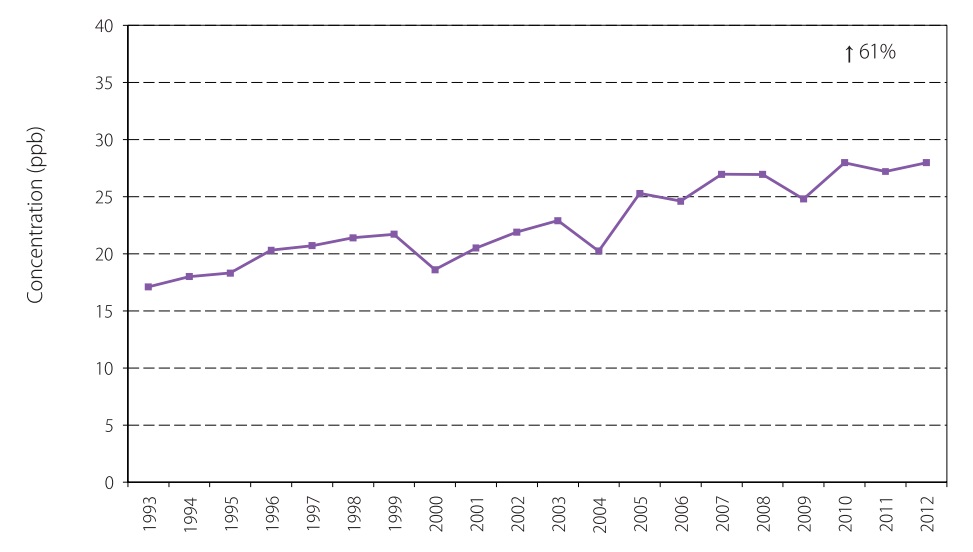
Figure A2: 20 year trend of ozone annual mean at Windsor West
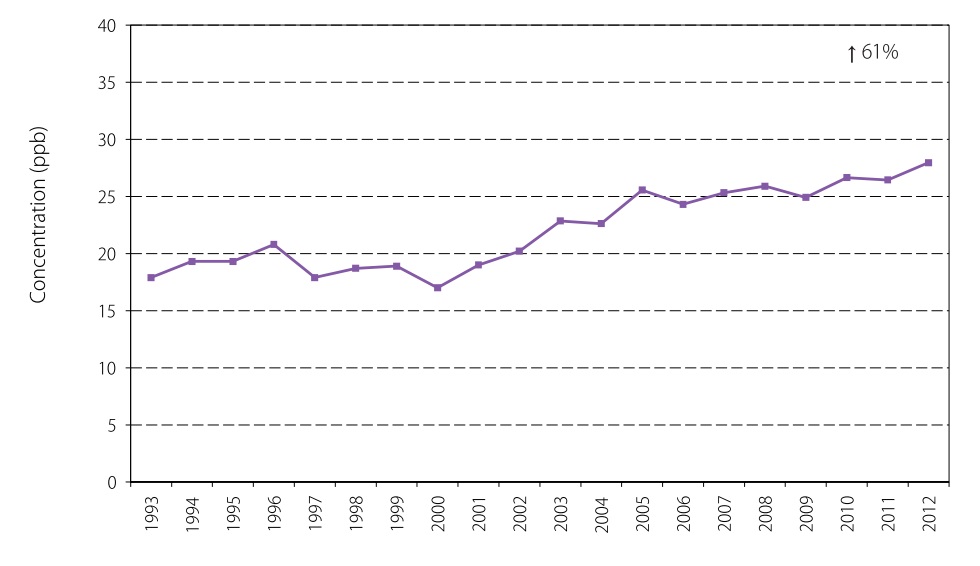
Figure A3: 20 year trend of ozone annual mean at Sarnia
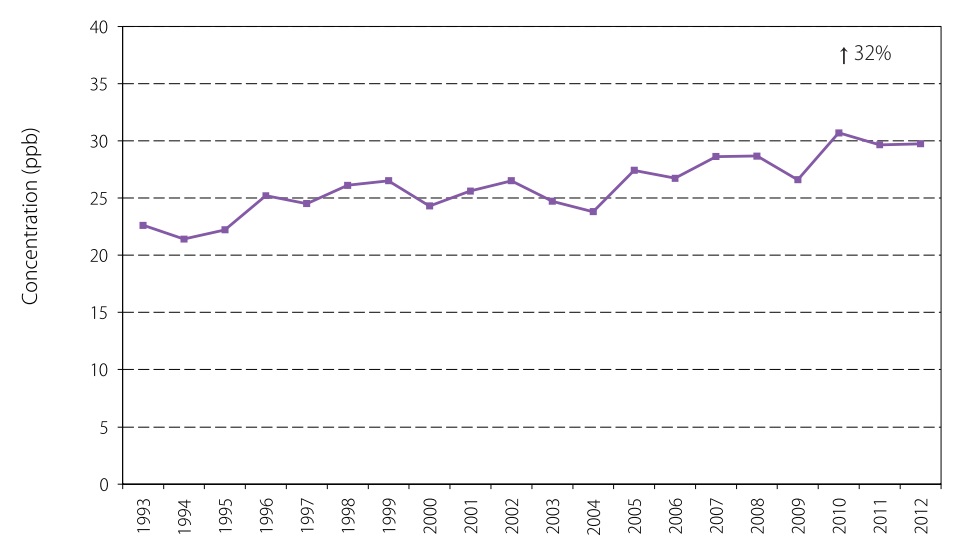
Figure A4: 20 year trend of ozone annual mean at Grand Bend
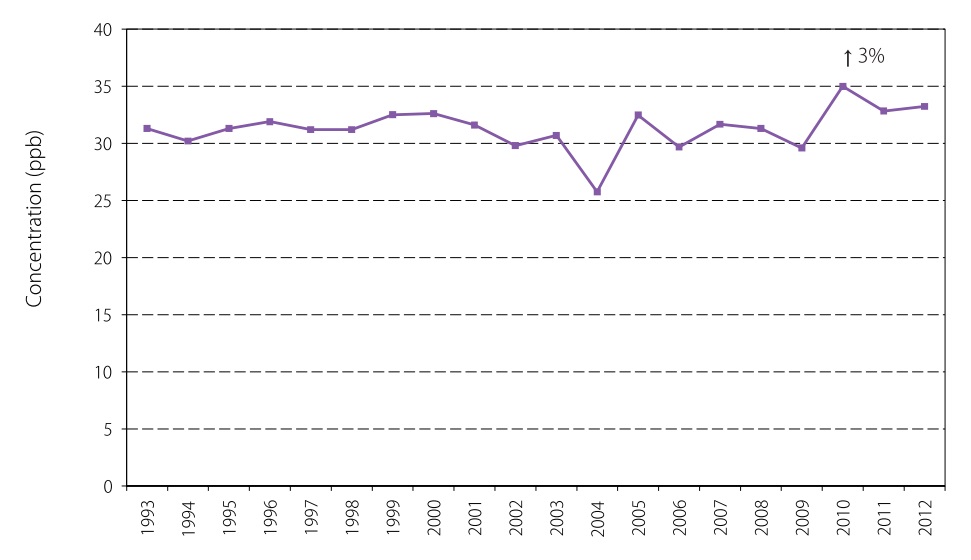
Figure A5: 20 year trend of ozone annual mean at London
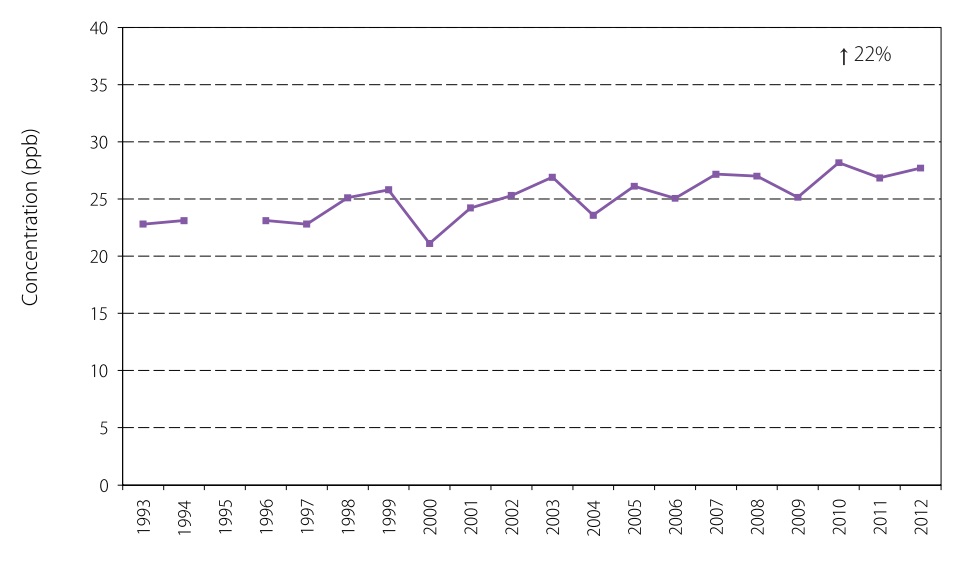
Figure A6: 20 year trend of ozone annual mean at Tiverton
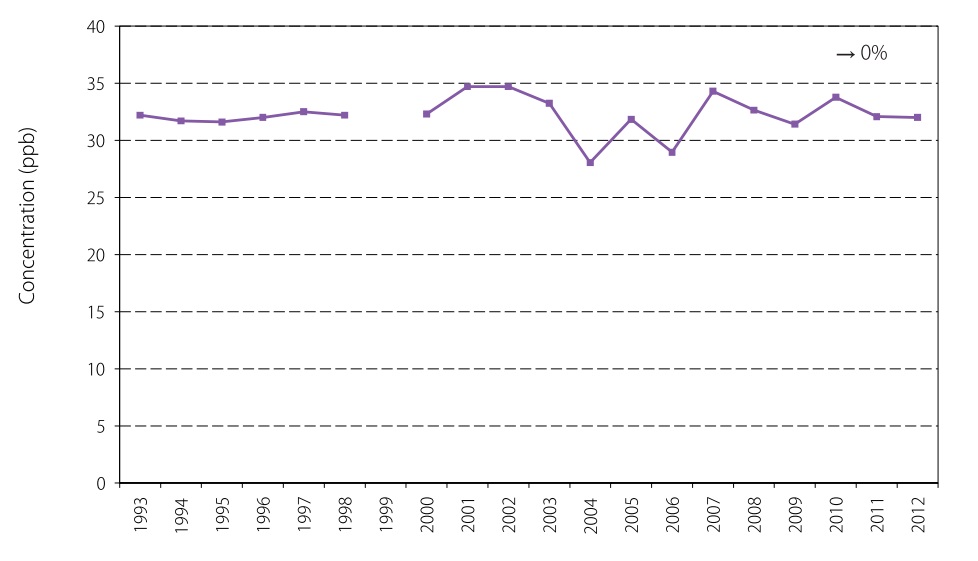
Figure A7: 20 year trend of ozone annual mean at Kitchener
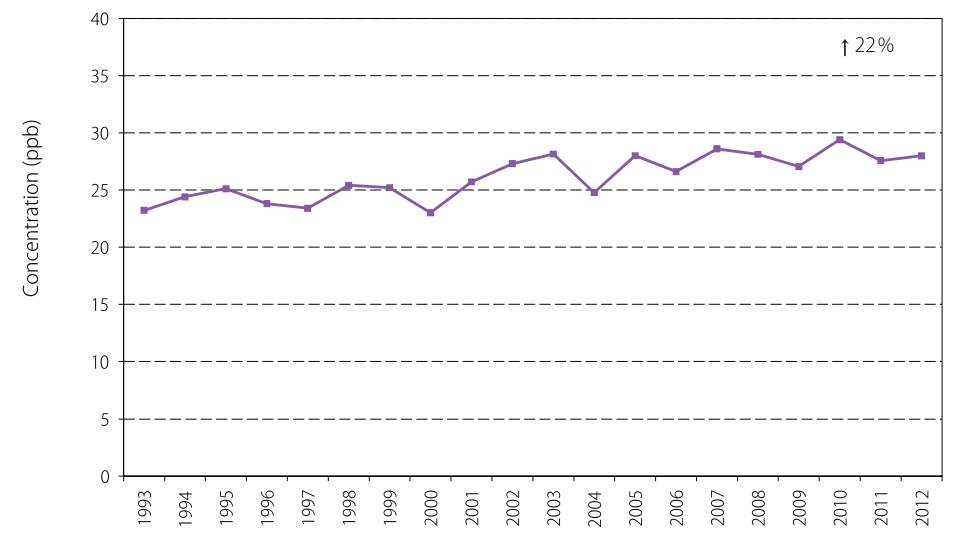
Figure A8: 20 year trend of ozone annual mean at St. Catharines
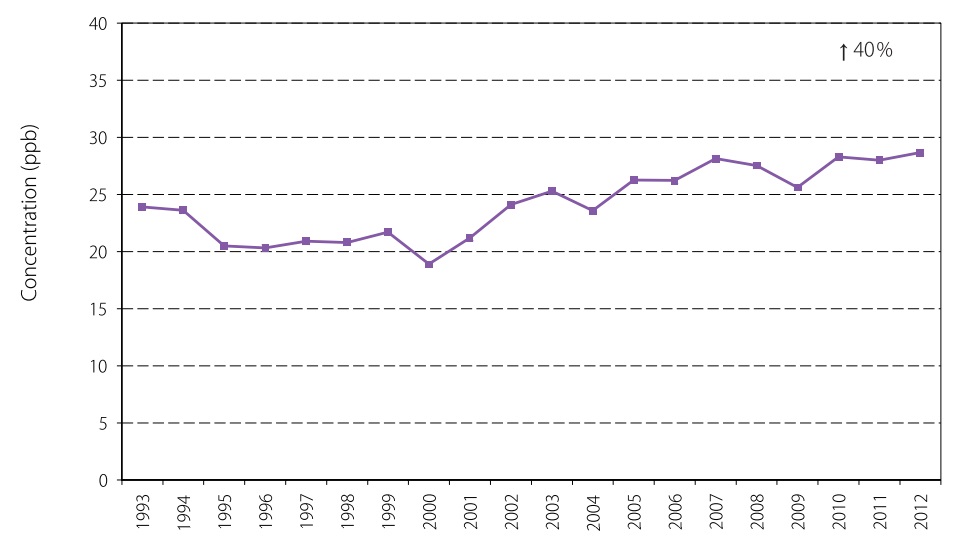
Figure A9: 20 year trend of ozone annual mean at Guelph
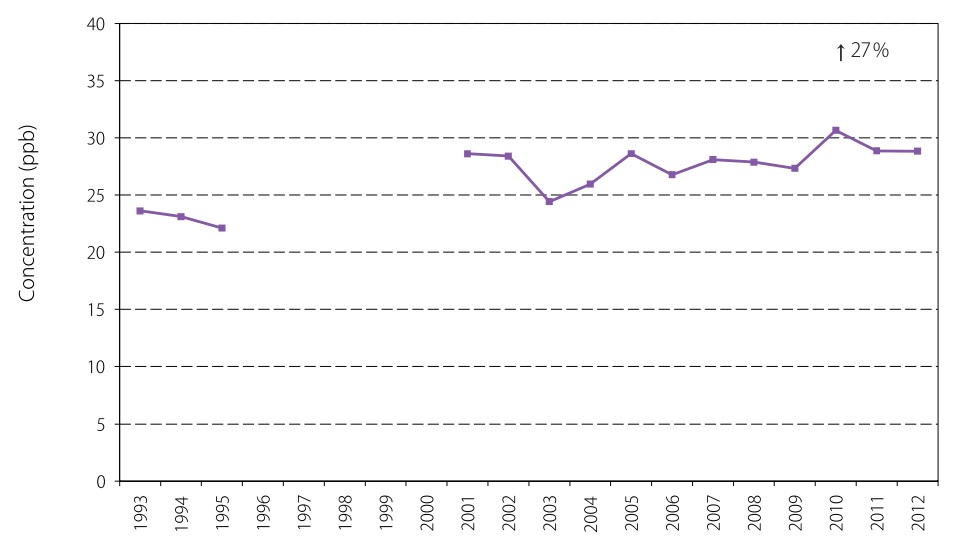
Figure A10: 20 year trend of ozone annual mean at Hamilton Downtown
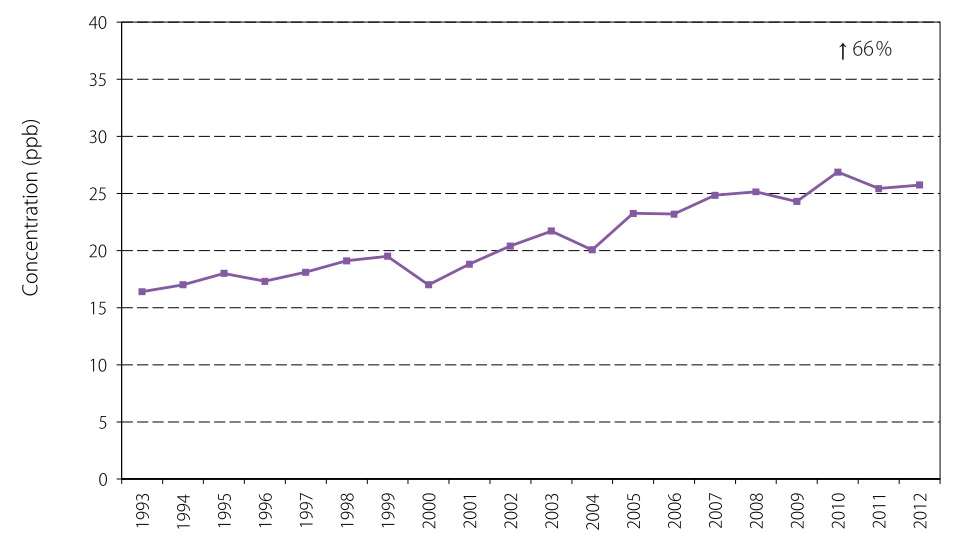
Figure A11: 20 year trend of ozone annual mean at Hamilton Mountain
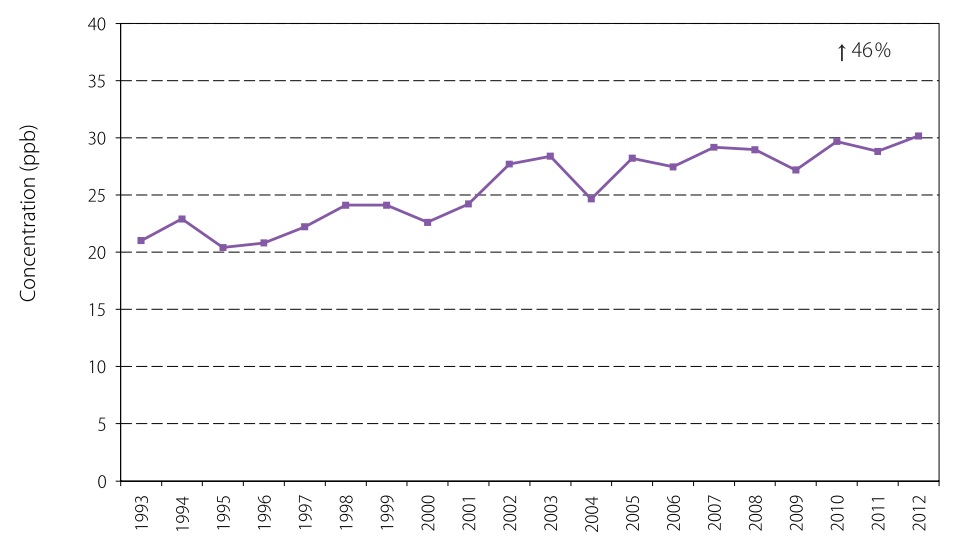
Figure A12: 20 year trend of ozone annual mean at Hamilton West
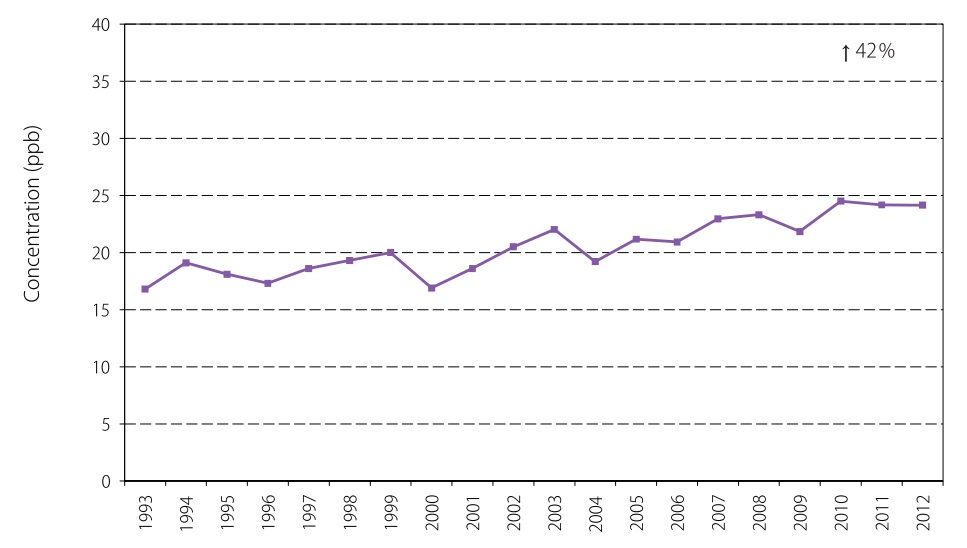
Figure A13: 20 year trend of ozone annual mean at Toronto Downtown
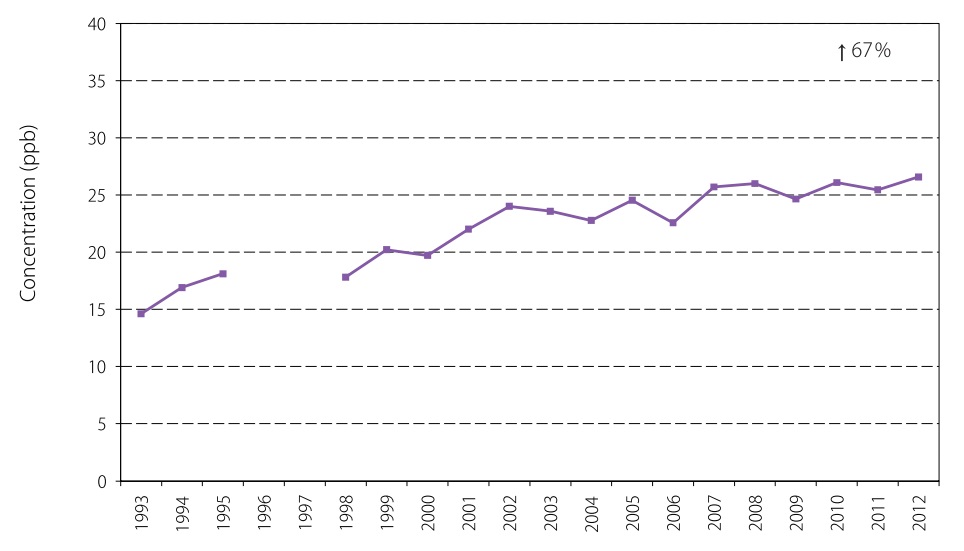
Figure A14: 20 year trend of ozone annual mean at Toronto East
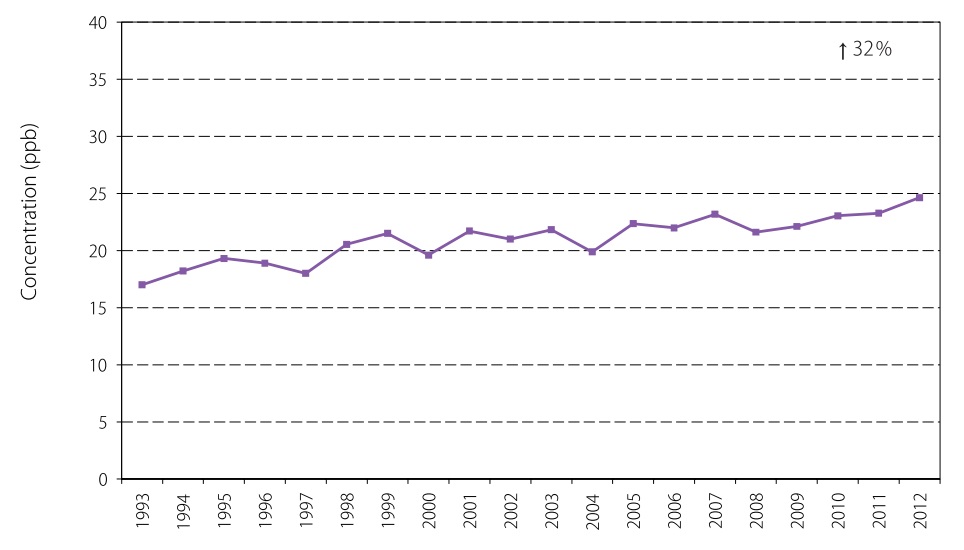
Figure A15: 20 year trend of ozone annual mean at Toronto North
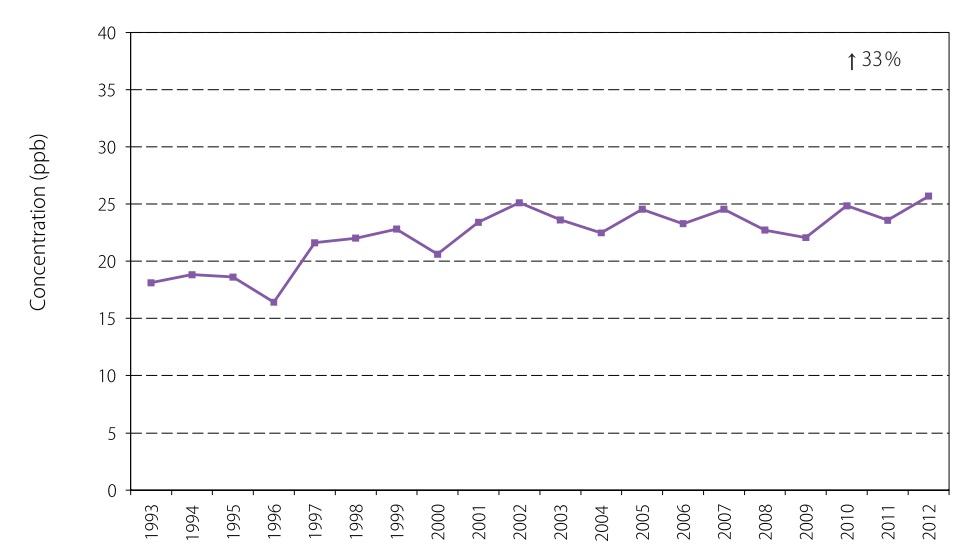
Figure A16: 20 year trend of ozone annual mean at Burlington
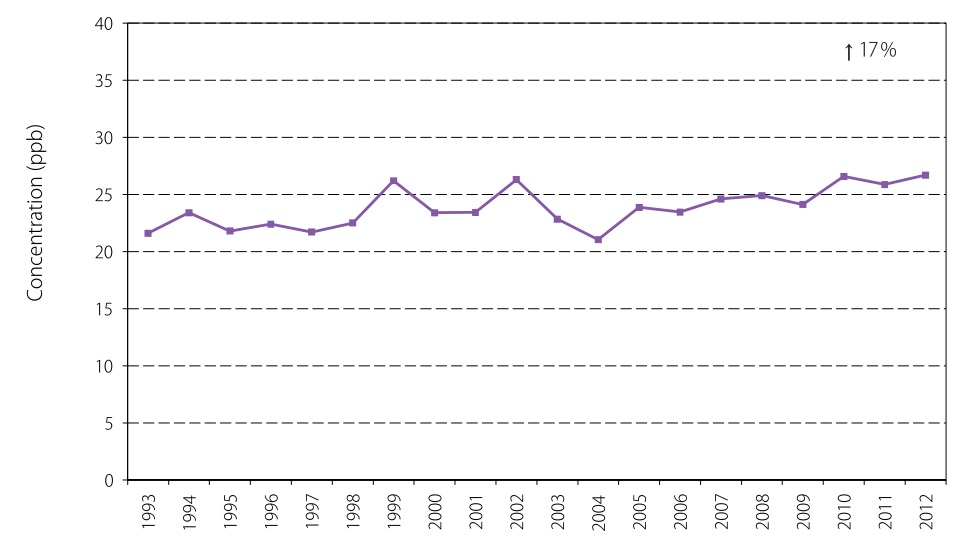
Figure A17: 20 year trend of ozone annual mean at Oakville
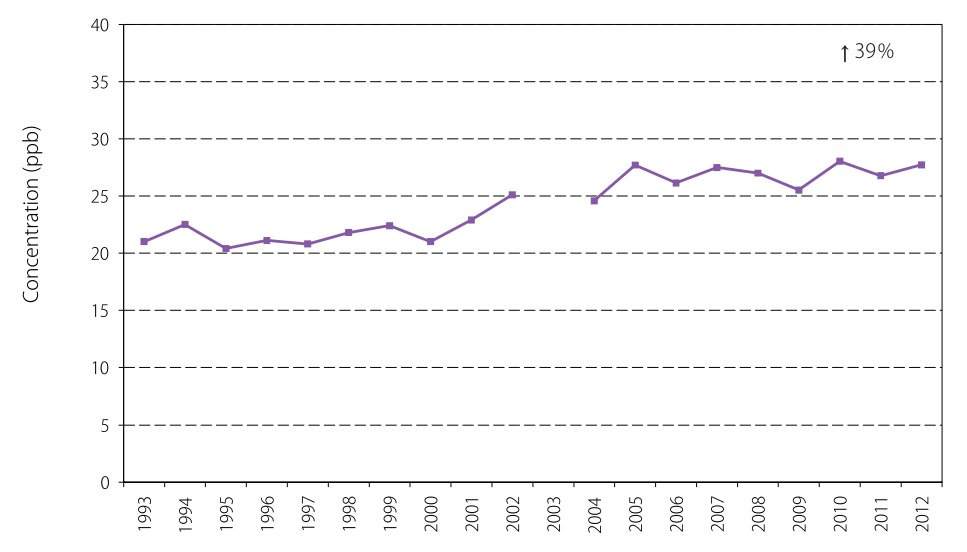
Figure A18: 20 year trend of ozone annual mean at Oshawa
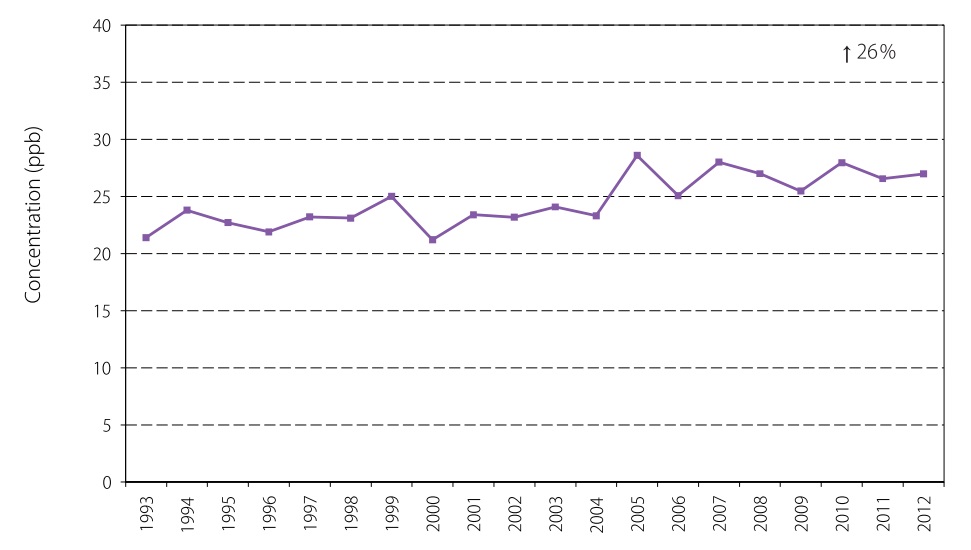
Figure A19: 20 year trend of ozone annual mean at Mississauga
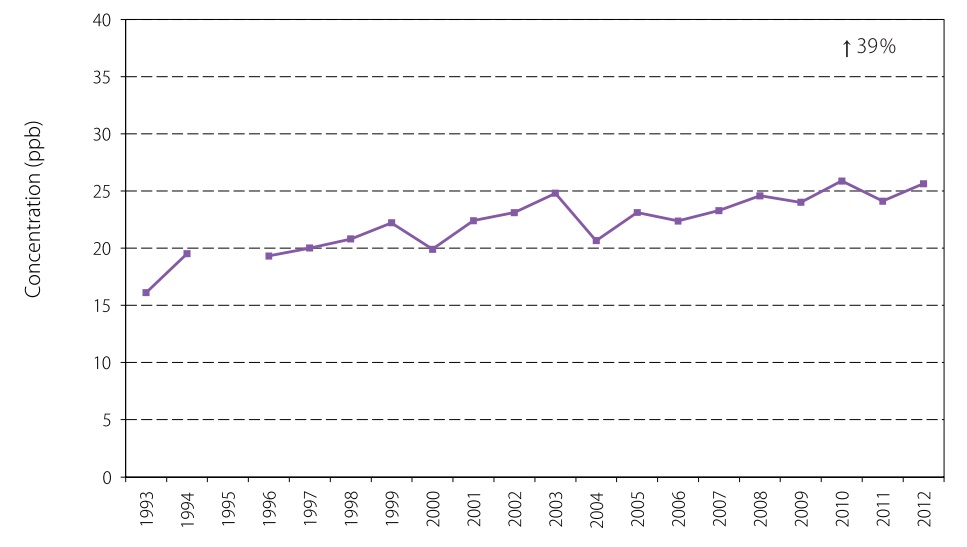
Figure A20: 20 year trend of ozone annual mean at Dorset
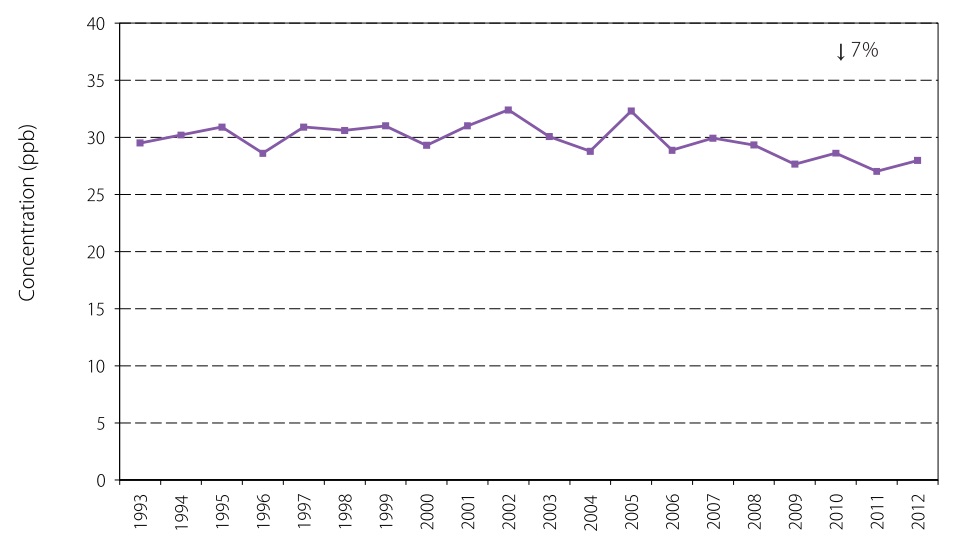
Figure A21: 20 year trend of ozone annual mean at Ottawa Downtown
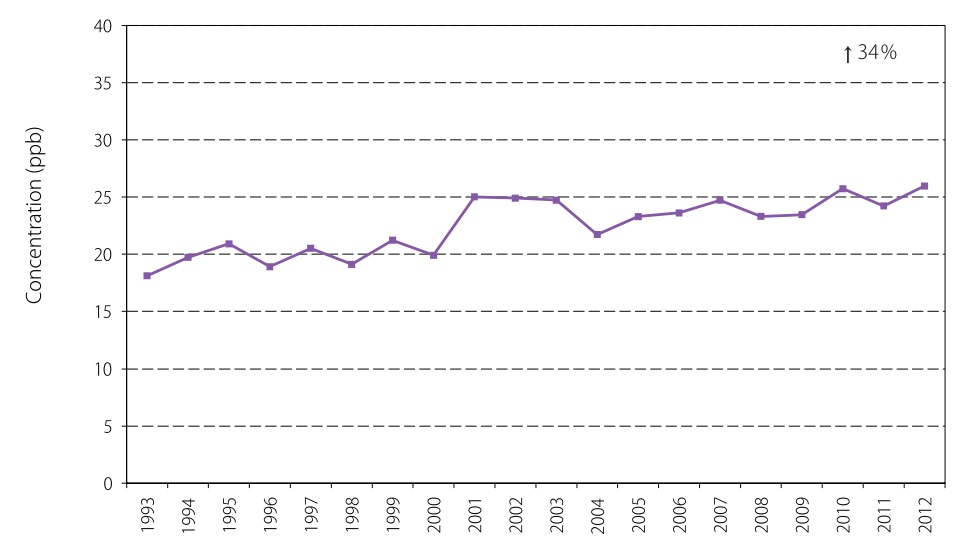
Figure A22: 20 year trend of ozone annual mean at Cornwall
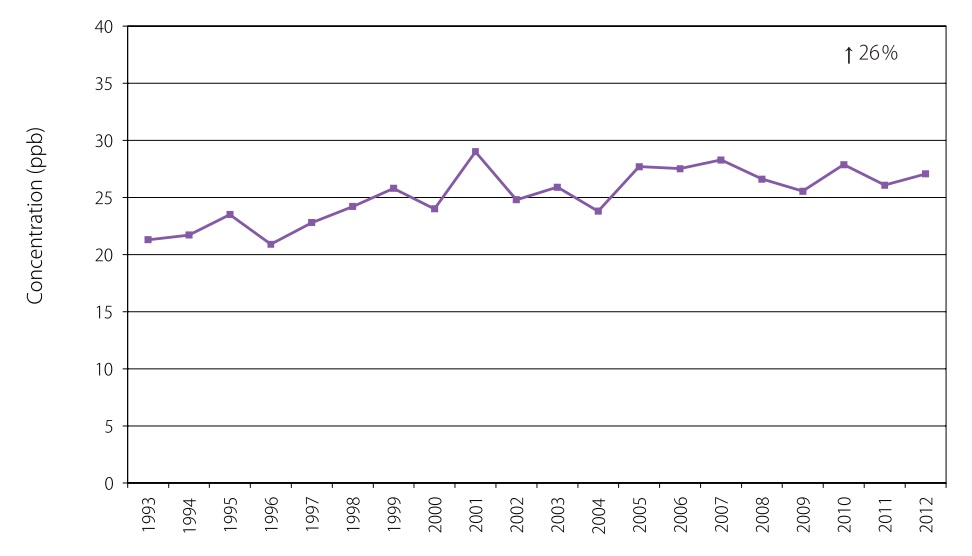
Figure A23: 20 year trend of ozone annual mean at Thunder Bay
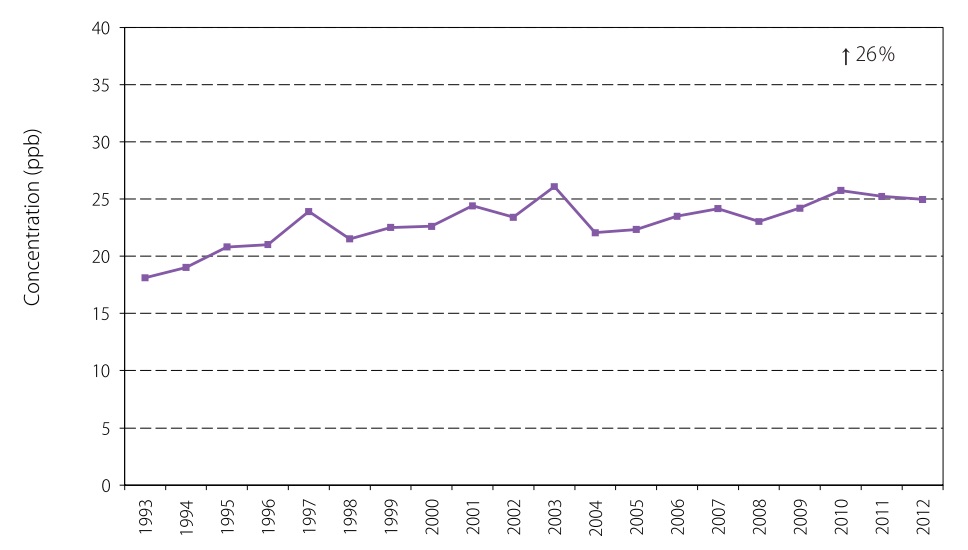
Figure A24: 20 year trend of ozone annual mean at Sault Ste. Marie
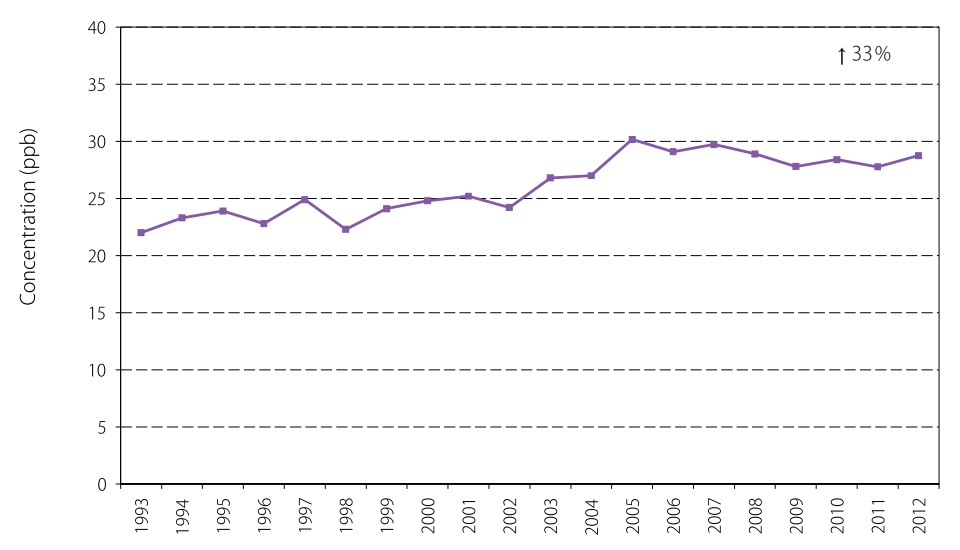
Figure A25: 20 year trend of ozone annual mean at North Bay
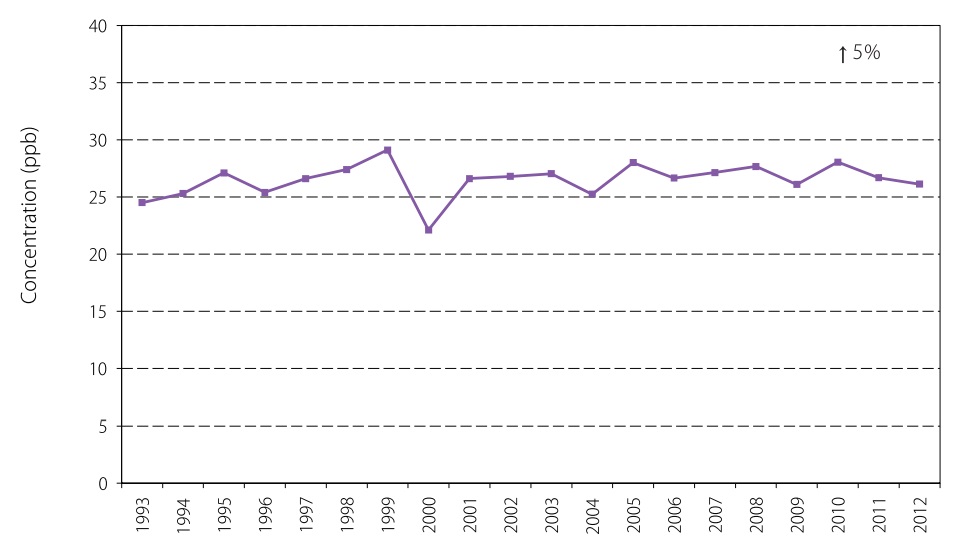
Figure A26: 20 year trend of ozone annual mean at Sudbury
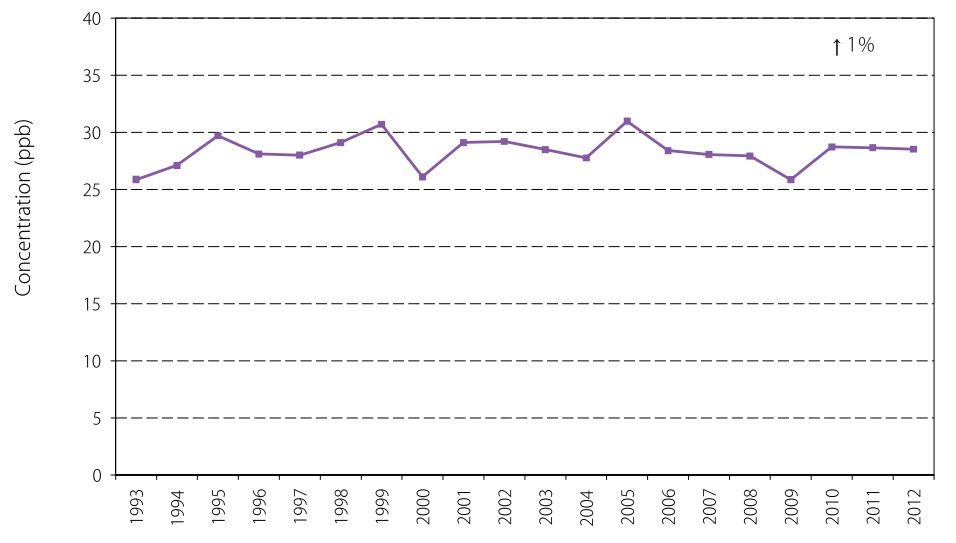
Figure A27: 20 year trend of NO2 annual mean at Windsor Downtown
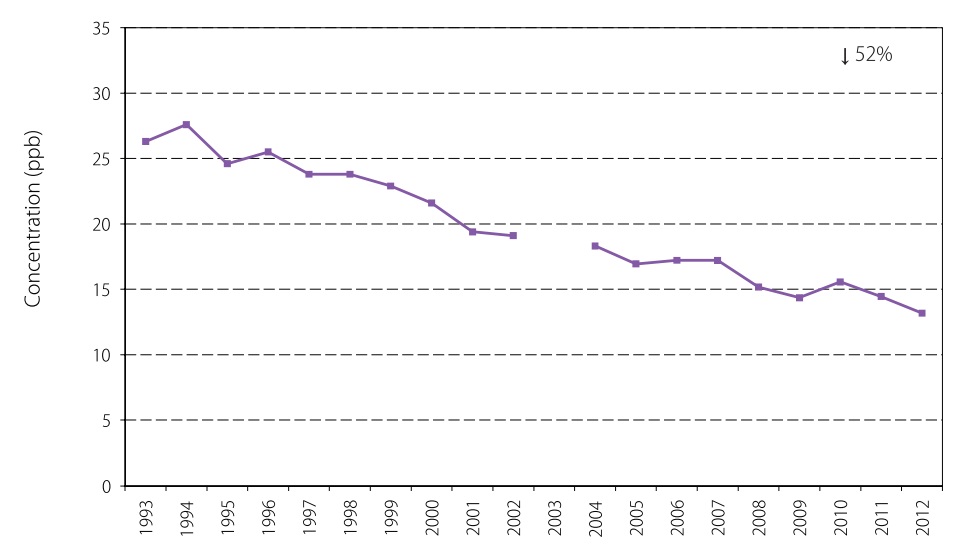
Figure A28: 20 year trend of NO2 annual mean at Sarnia
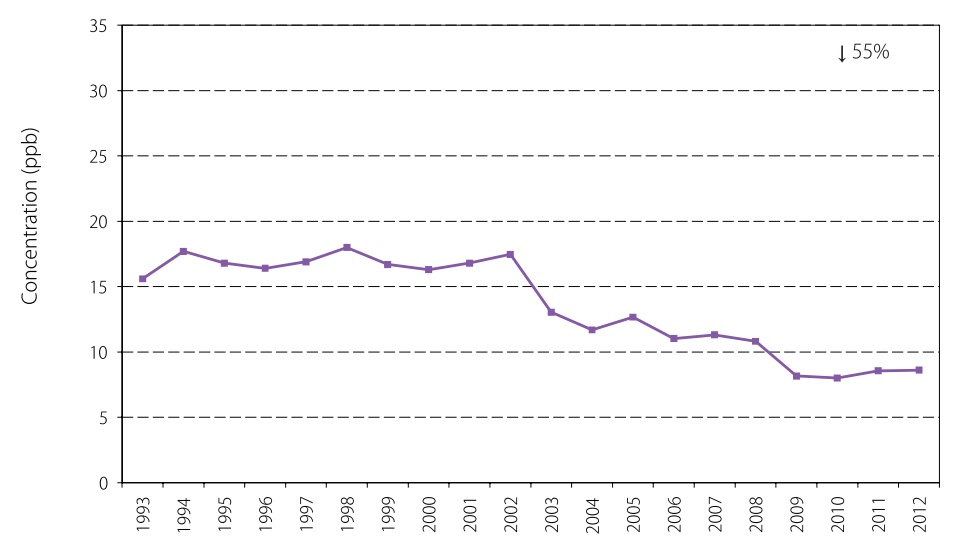
Figure A29: 20 year trend of NO2 annual mean at London
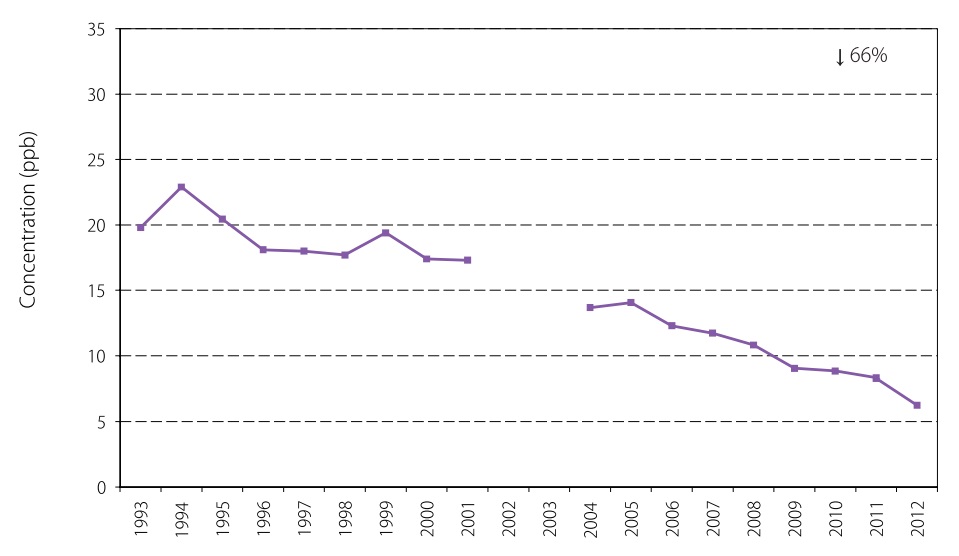
Figure A30: 20 year trend of NO2 annual mean at Kitchener
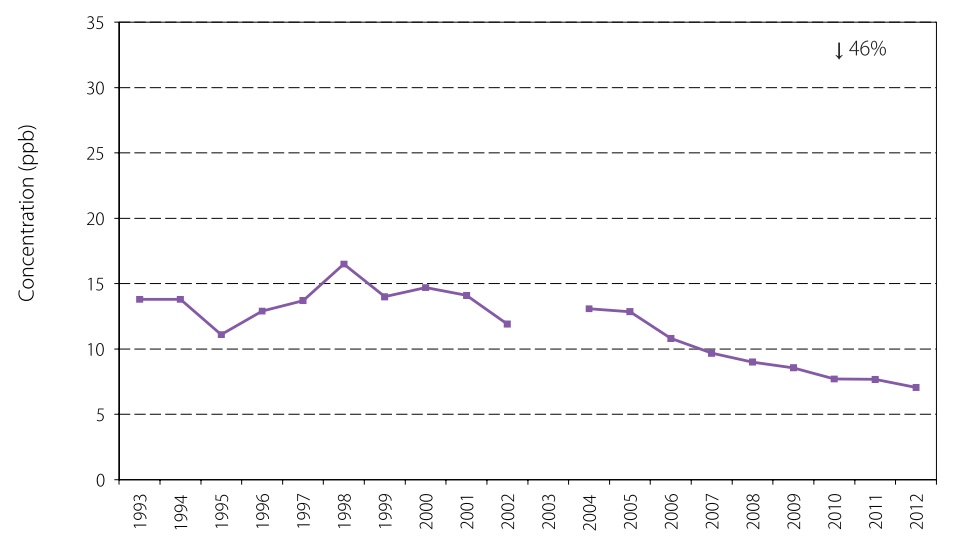
Figure A31: 20 year trend of NO2 annual mean at St. Catharines
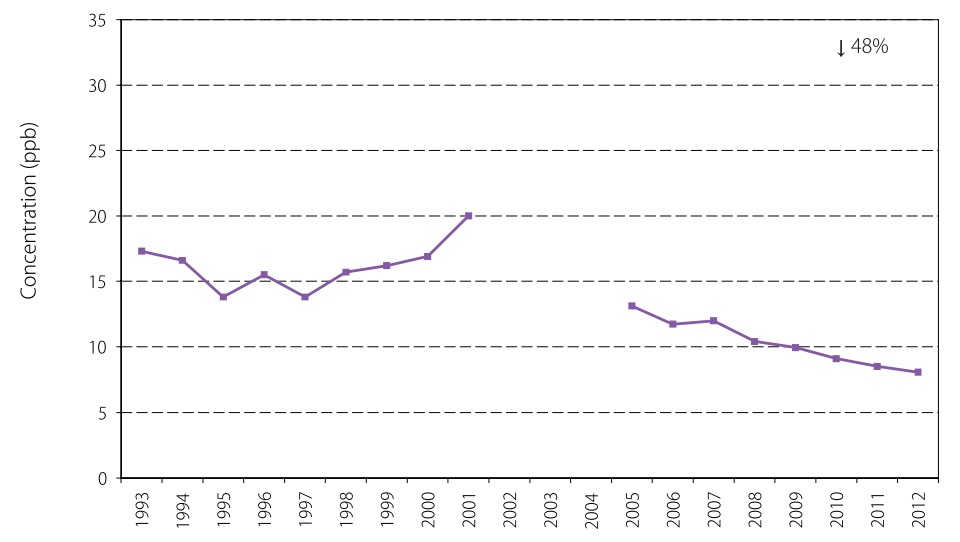
Figure A32: 20 year trend of NO2 annual mean at Hamilton Downtown
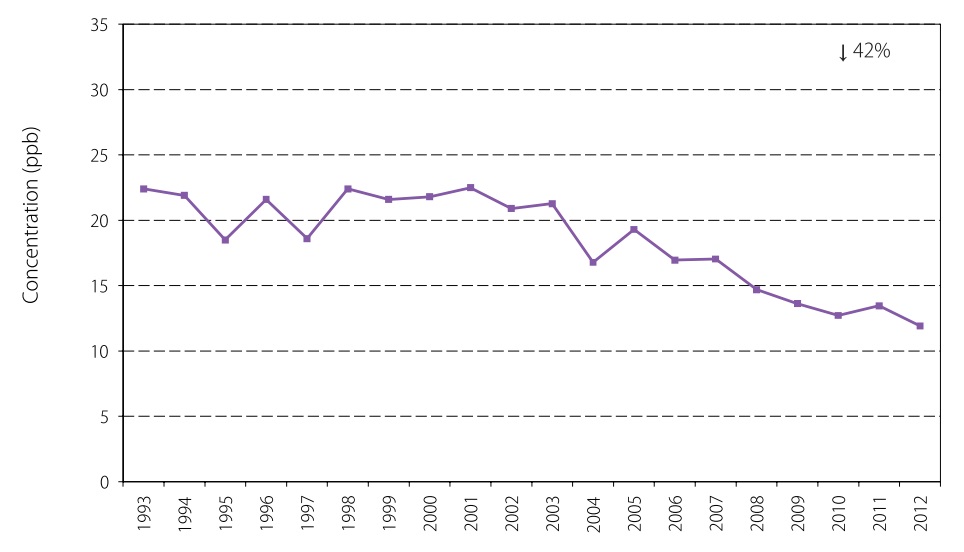
Figure A33: 20 year trend of NO2 annual mean at Hamilton Mountain
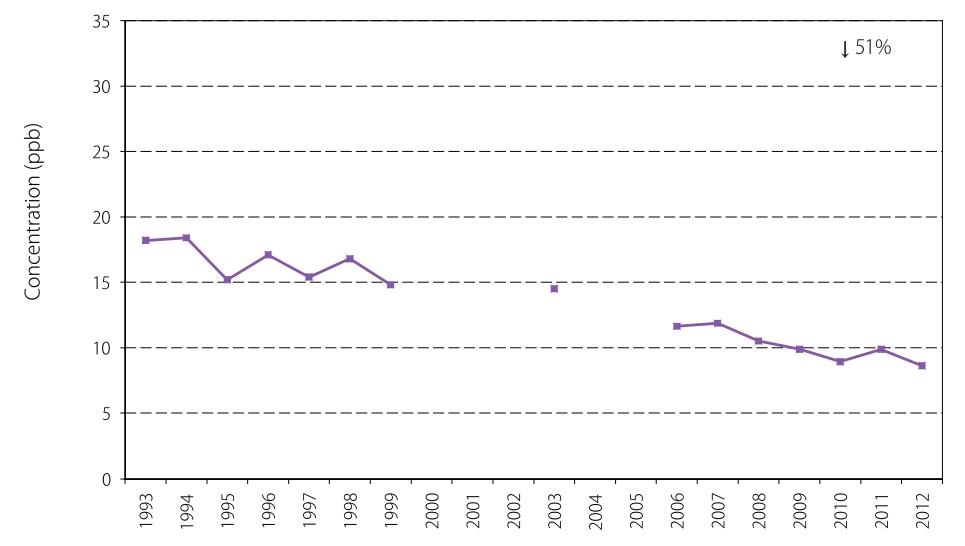
Figure A34: 20 year trend of NO2 annual mean at Toronto Downtown
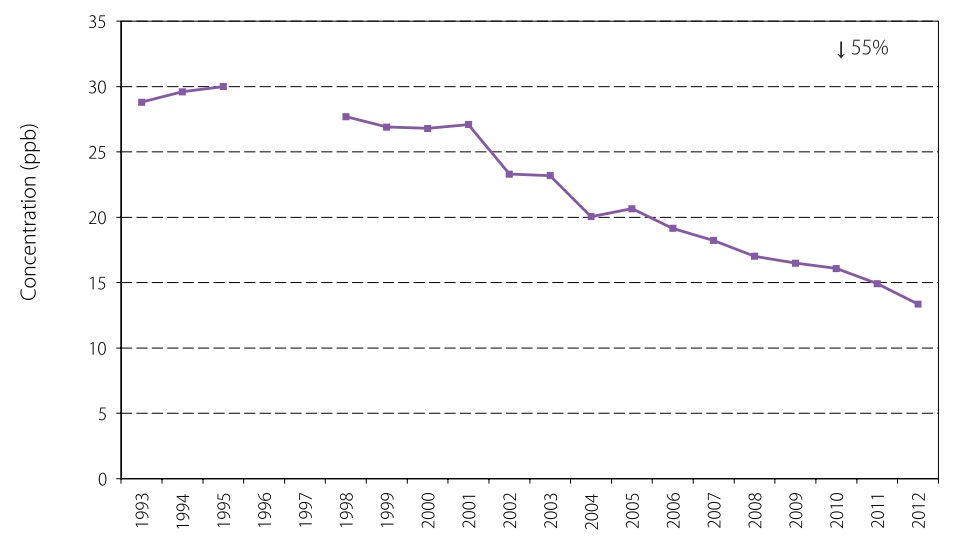
Figure A35: 20 year trend of NO2 annual mean at Toronto East
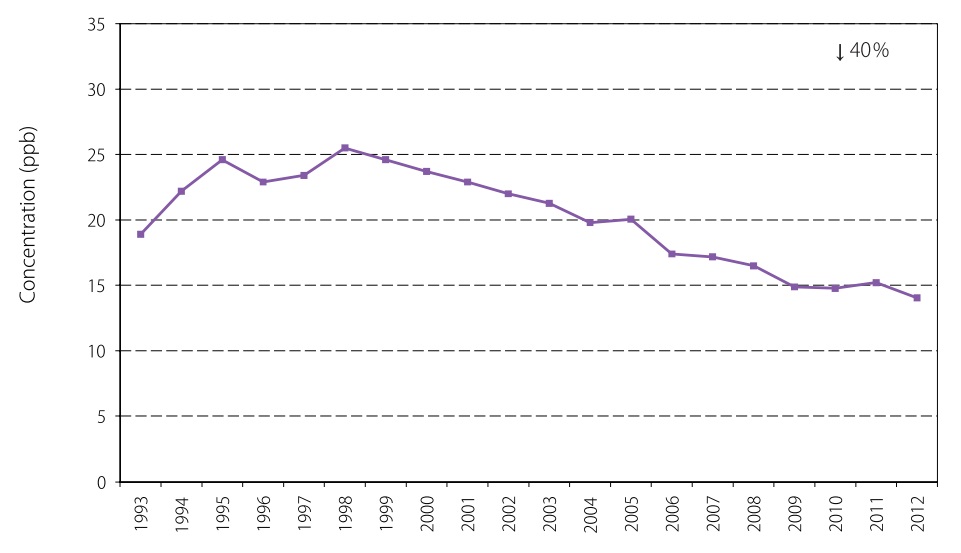
Figure A36: 20 year trend of NO2 annual mean at Toronto North
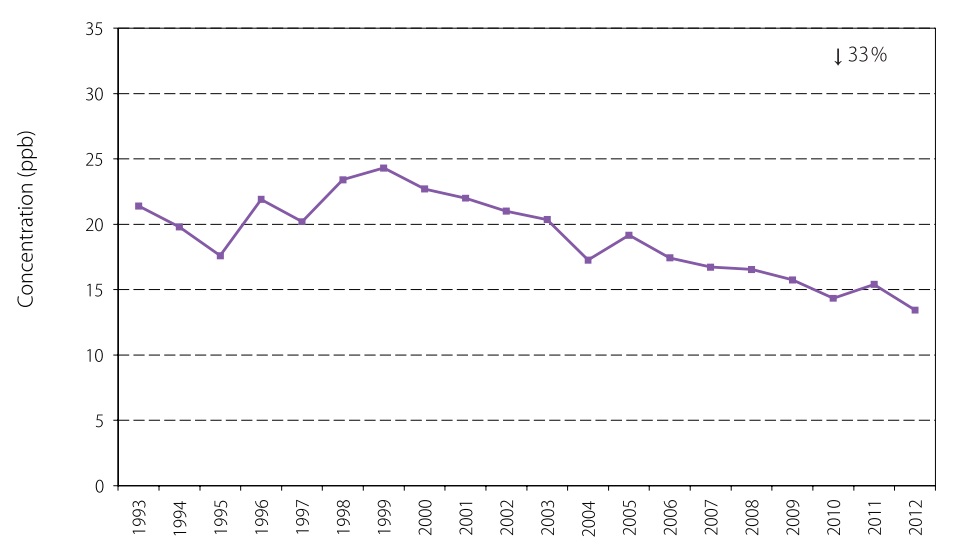
Figure A37: 20 year trend of NO2 annual mean at Burlington
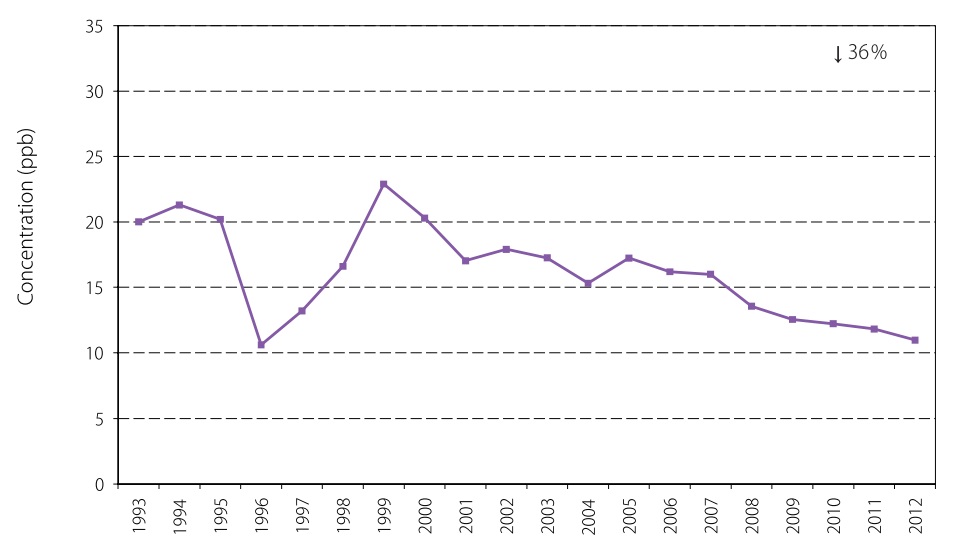
Figure A38: 20 year trend of NO2 annual mean at Oakville
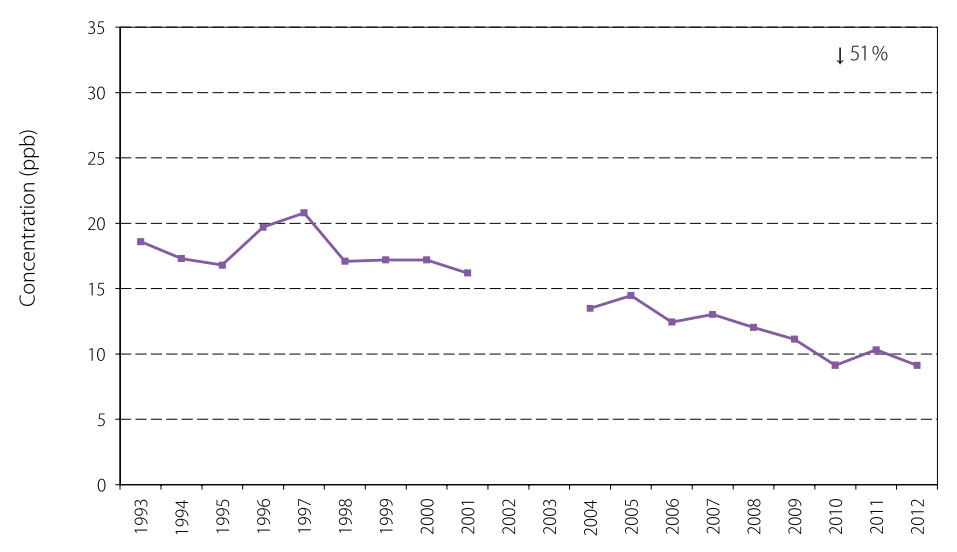
Figure A39: 20 year trend of NO2 annual mean at Oshawa
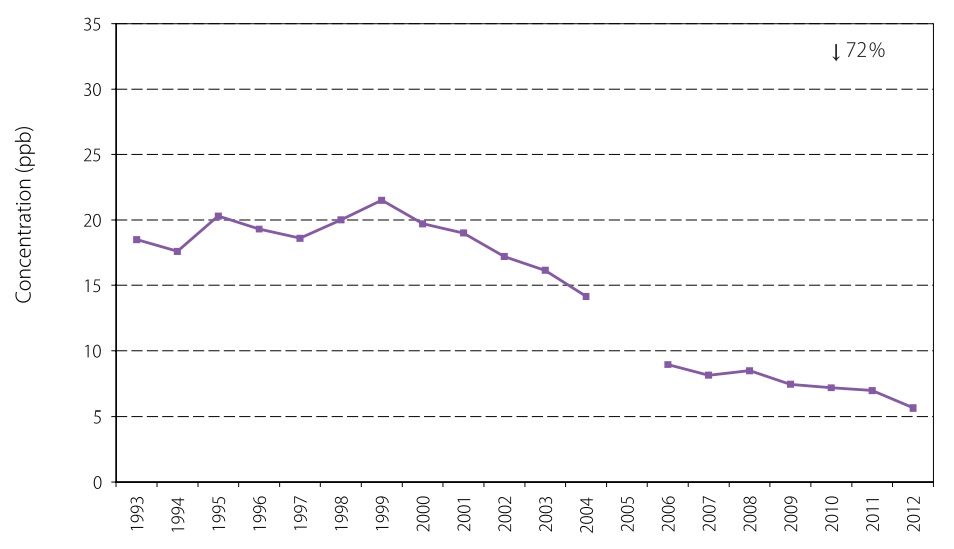
Figure A40: 20 year trend of NO2 annual mean at Ottawa Downtown
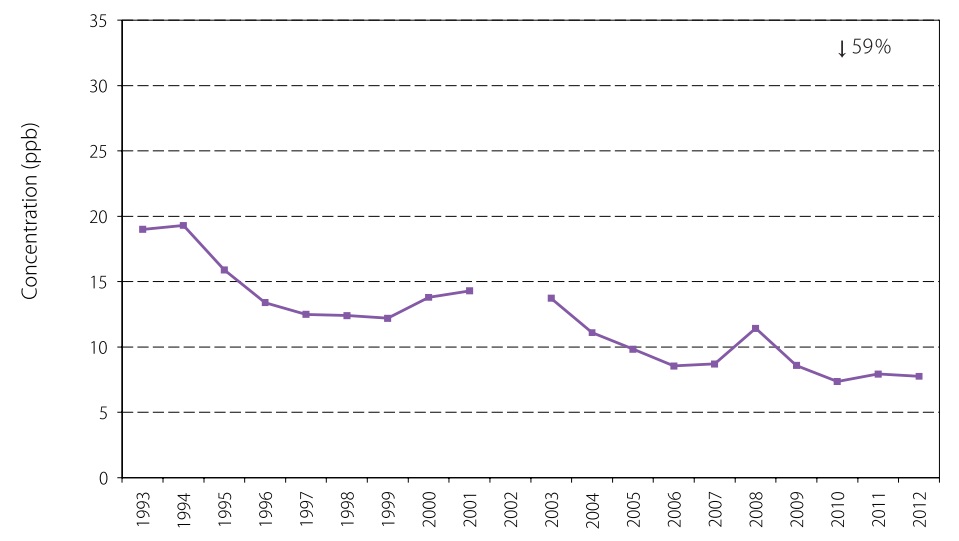
Figure A41: 20 year trend of SO2 annual mean at Windsor Downtown
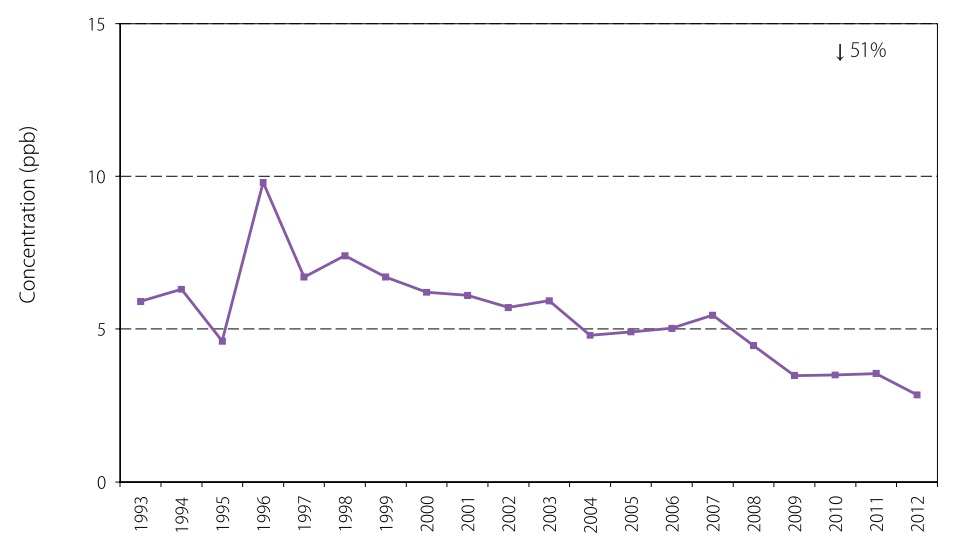
Figure A42: 20 year trend of SO2 annual mean at Windsor West
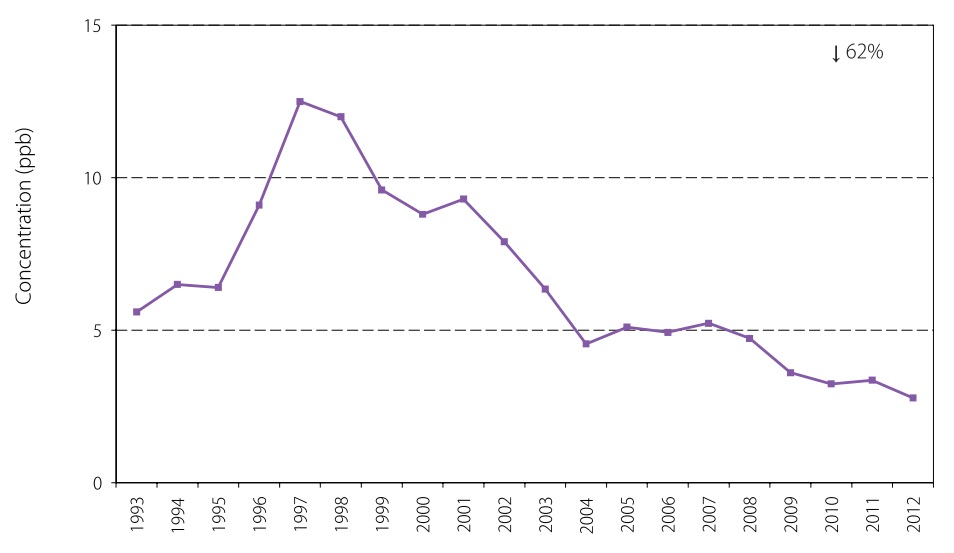
Figure A43: 20 year trend of SO2 annual mean at Sarnia
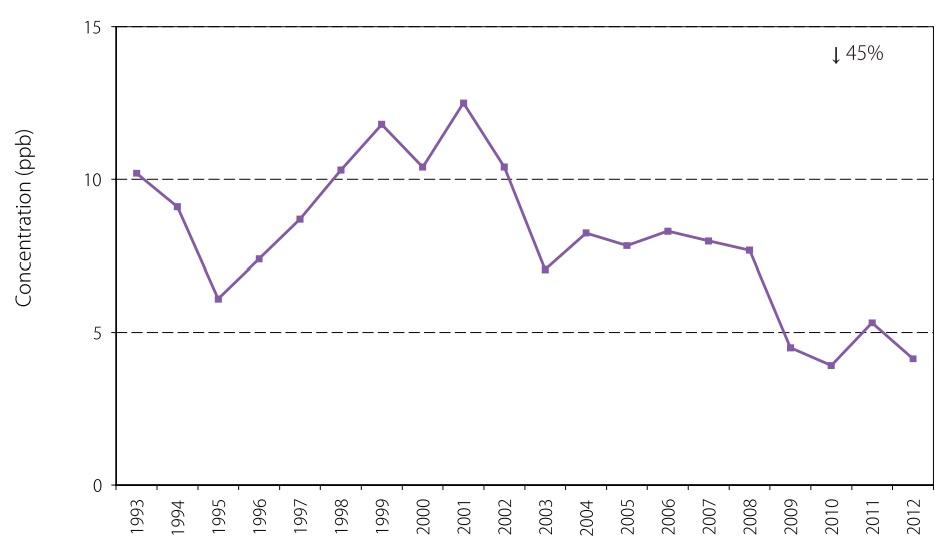
Figure A44: 20 year trend of SO2 annual mean at Hamilton Downtown
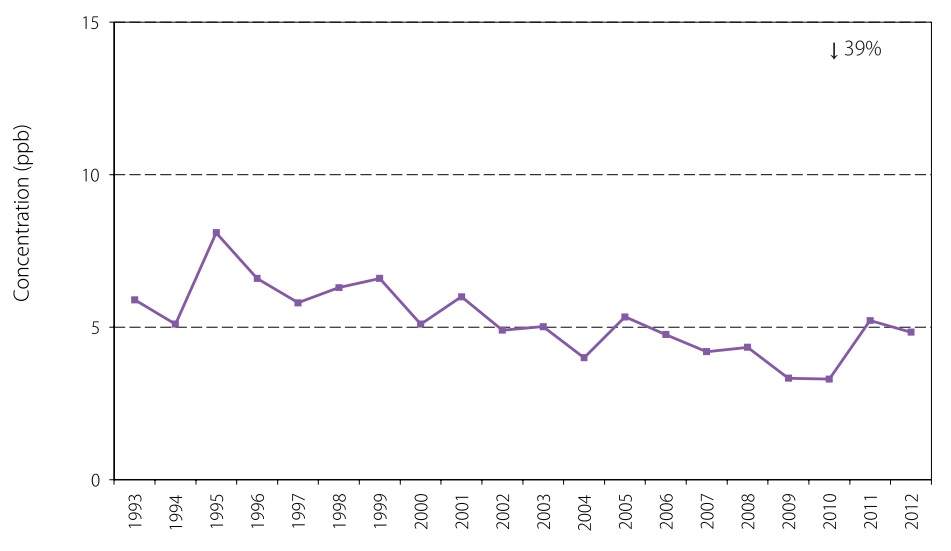
Figure A45: 20 year trend of SO2 annual mean at Hamilton Mountain
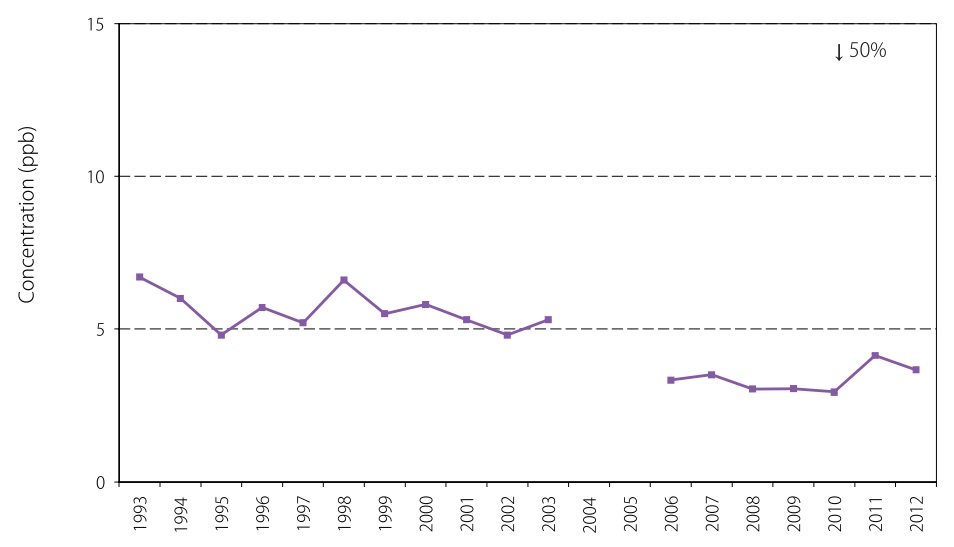
Figure A46: 20 year trend of SO2 annual mean at Ottawa Downtown
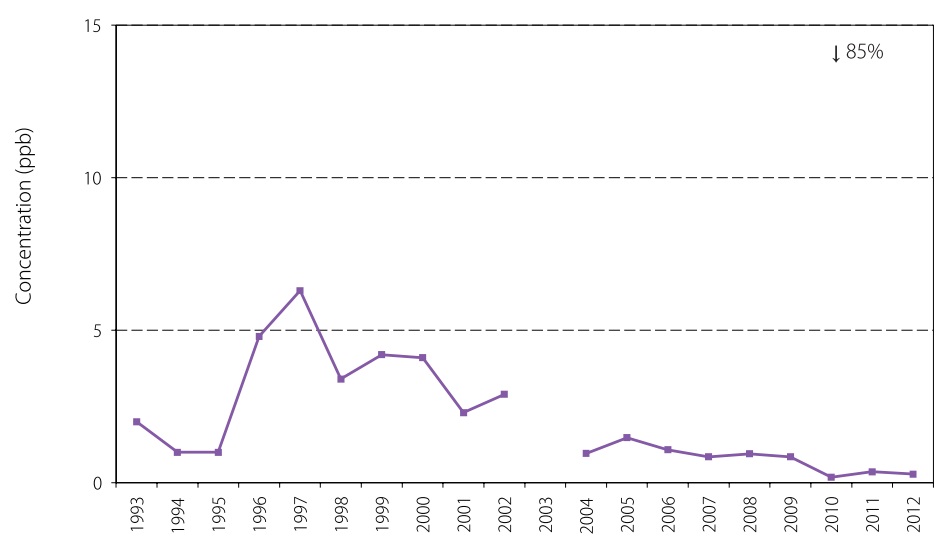
Figure A47: 20 year trend of SO2 annual mean at Sault St. Marie
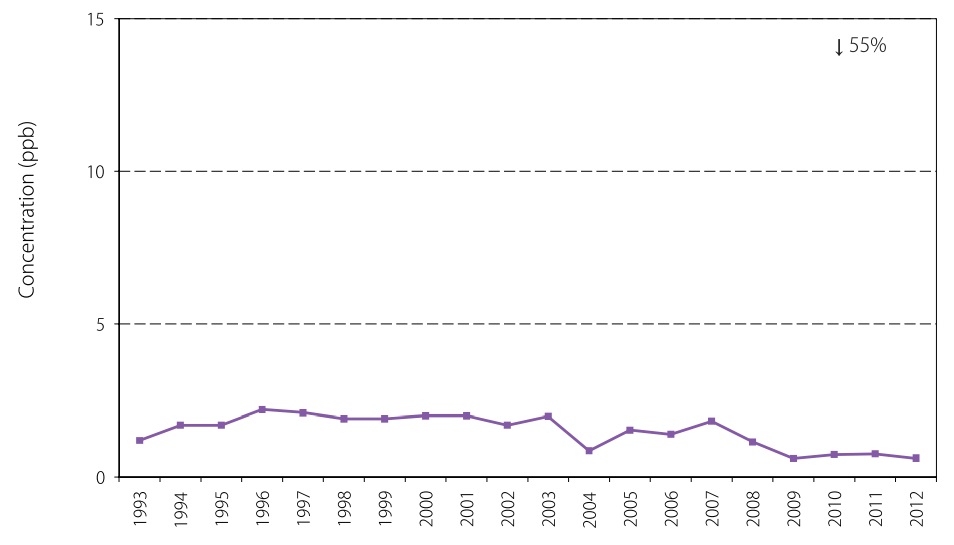
Figure A48: 20 year trend of SO2 annual mean at Sudbury
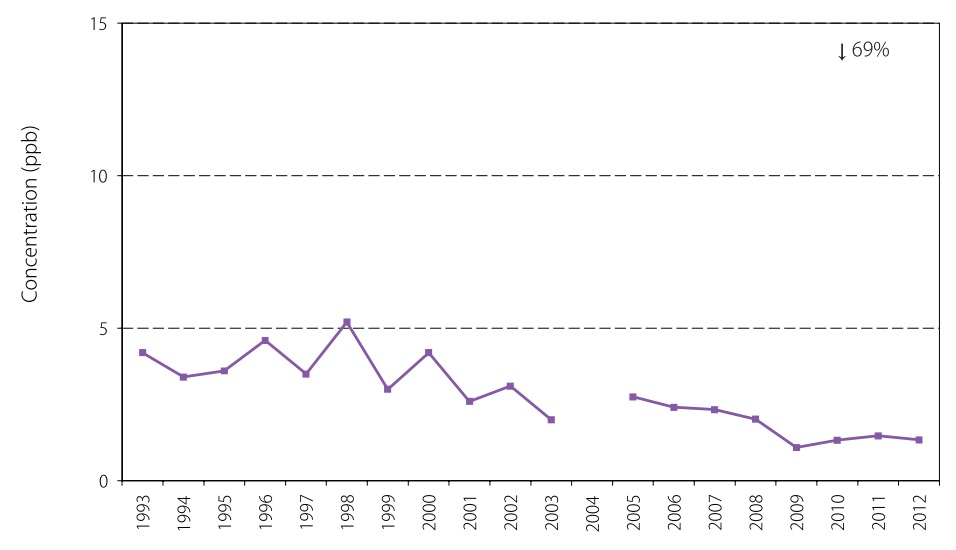
Acknowledgements
This report has been prepared by the staff of the Environmental Monitoring and Reporting Branch of the Ontario Ministry of the Environment and Climate Change. Environment Canada’s National Air Pollution Surveillance program is acknowledged for providing air monitoring instrumentation to the province of Ontario.
For more information:
Ministry of the Environment and Climate Change Public Information Centre
Email: picemail.moe@ontario.ca
Website: Ministry of the Environment and Climate Change
© Queen’s Printer for Ontario, 2014
PIBS# 9598e